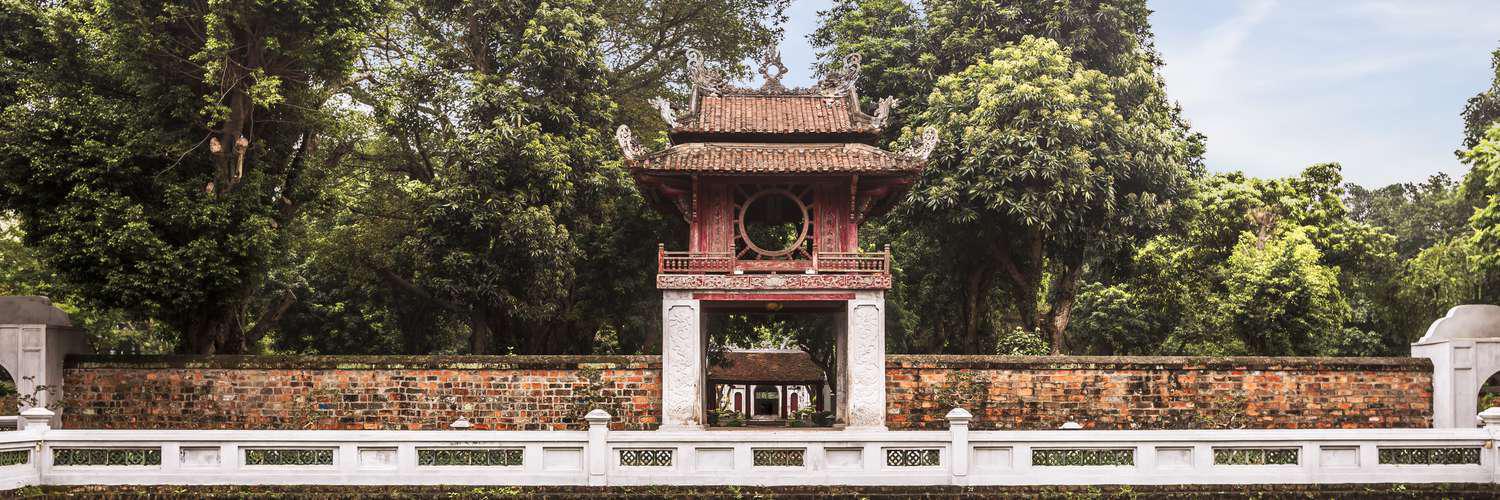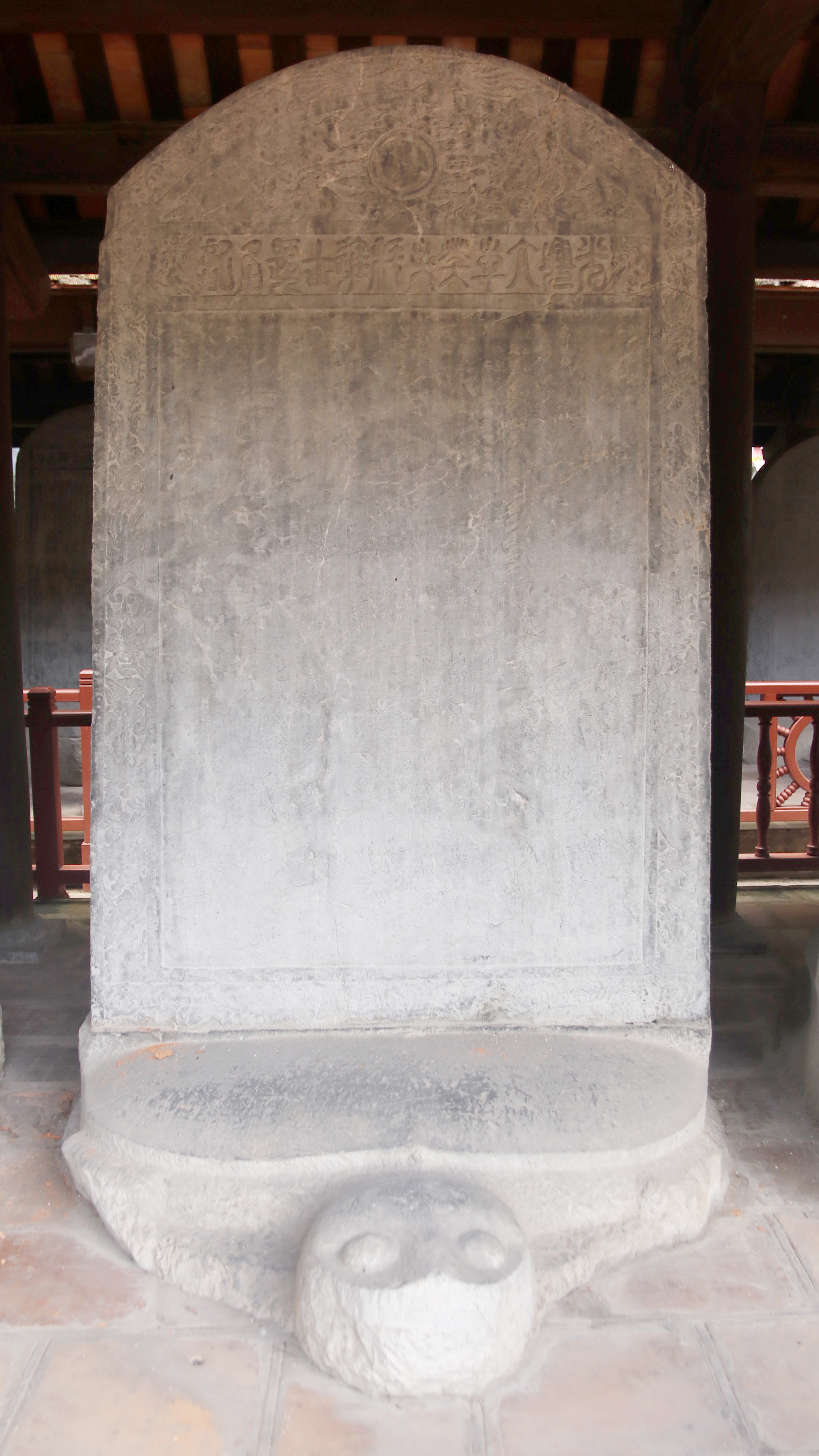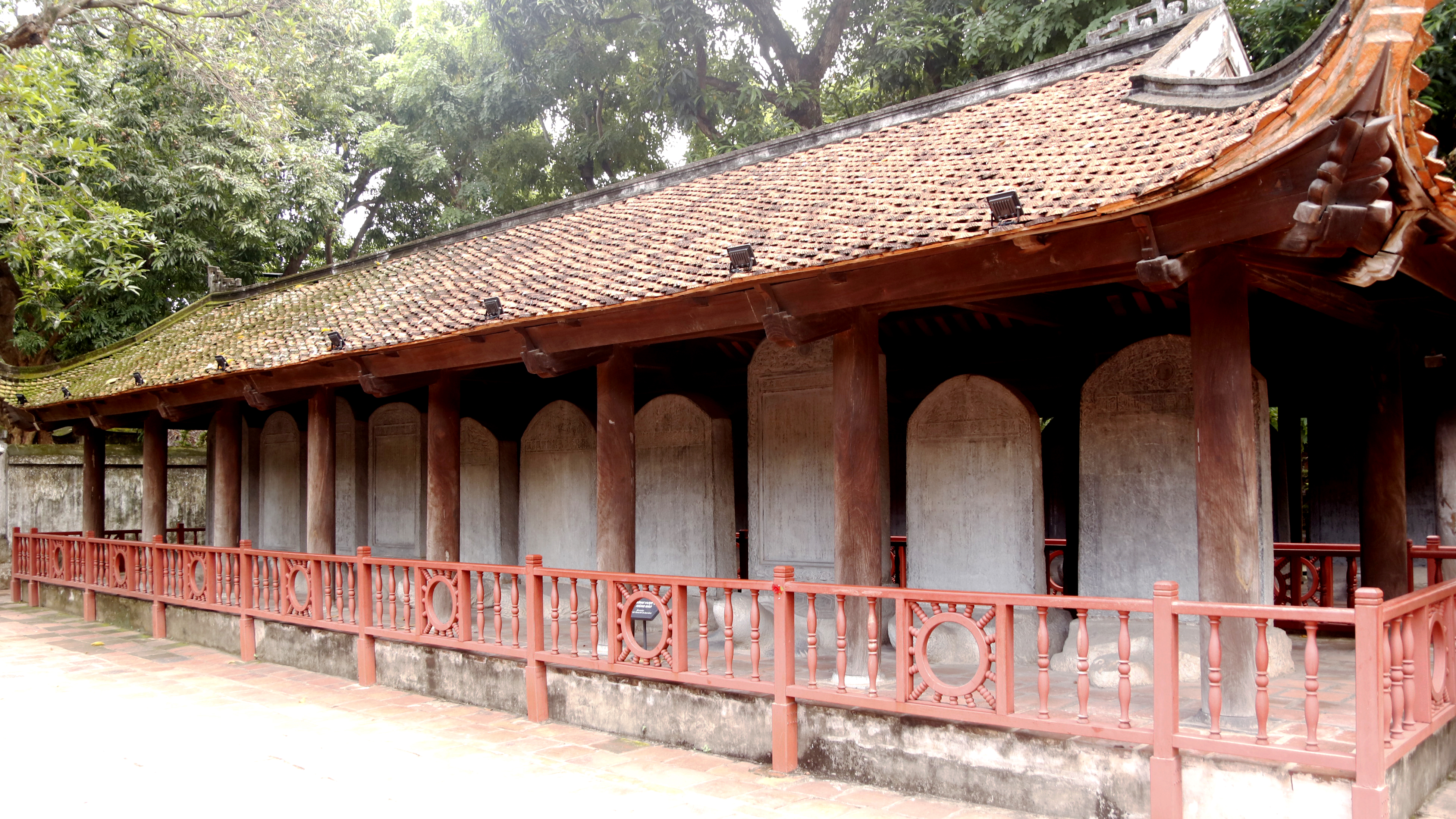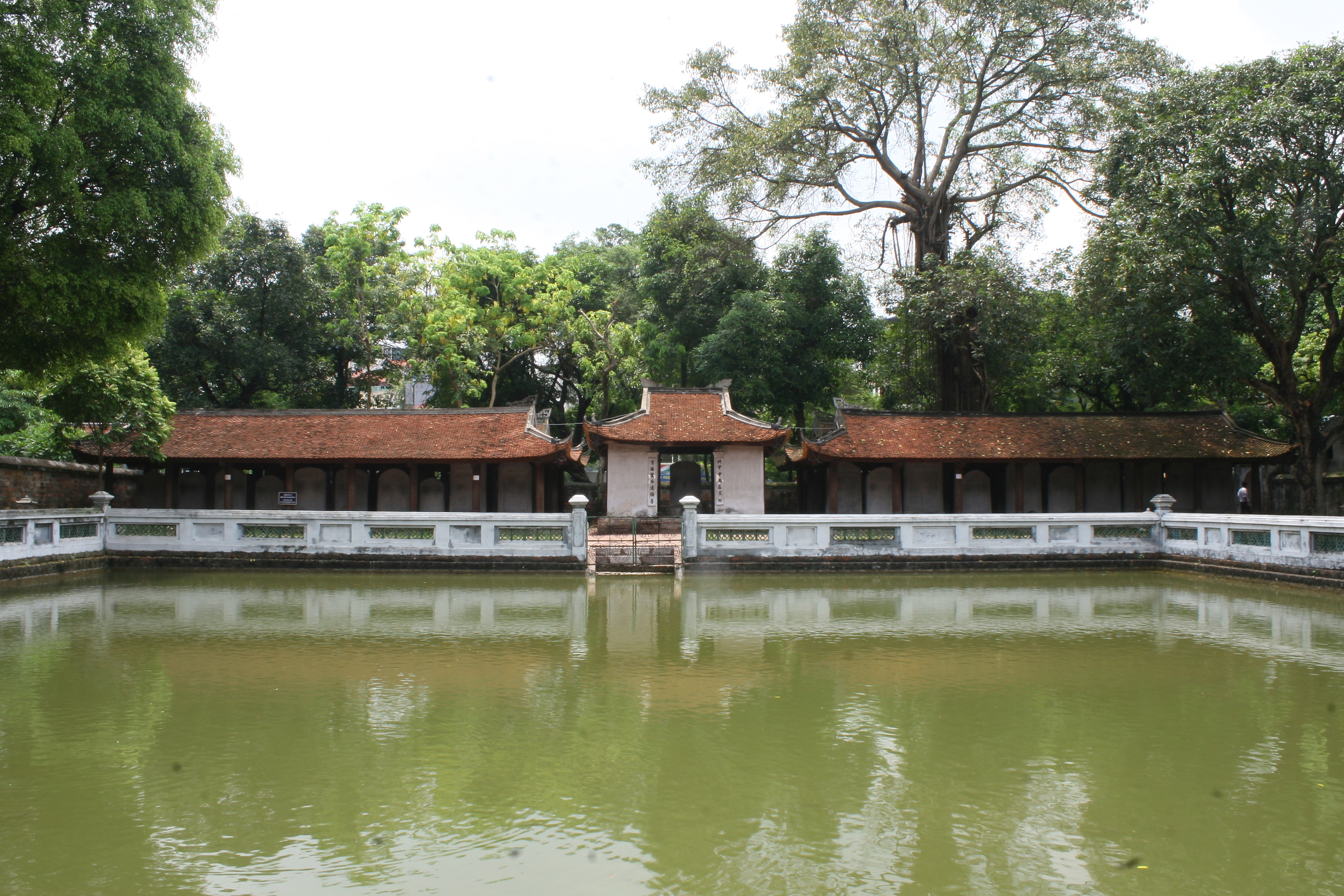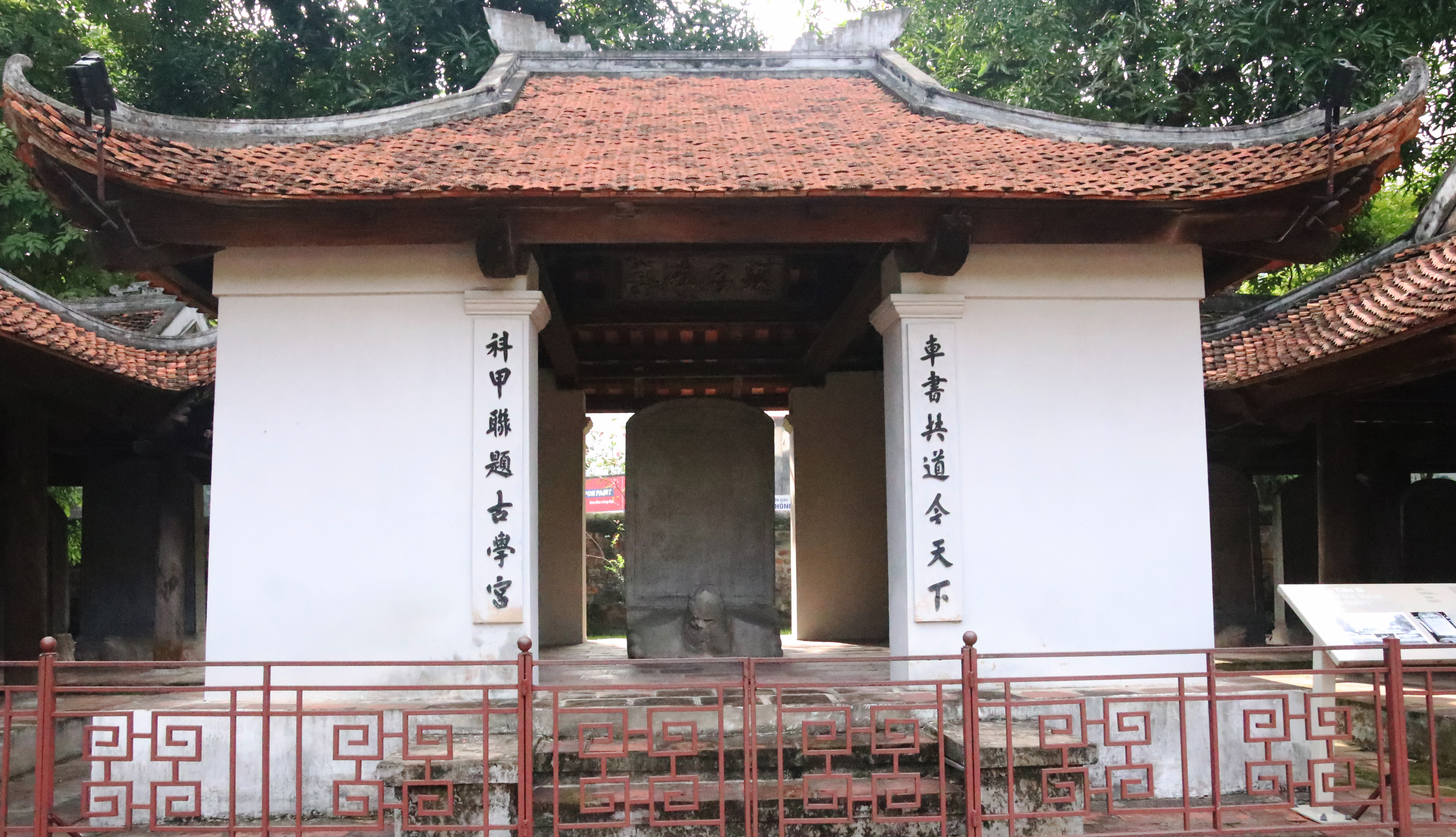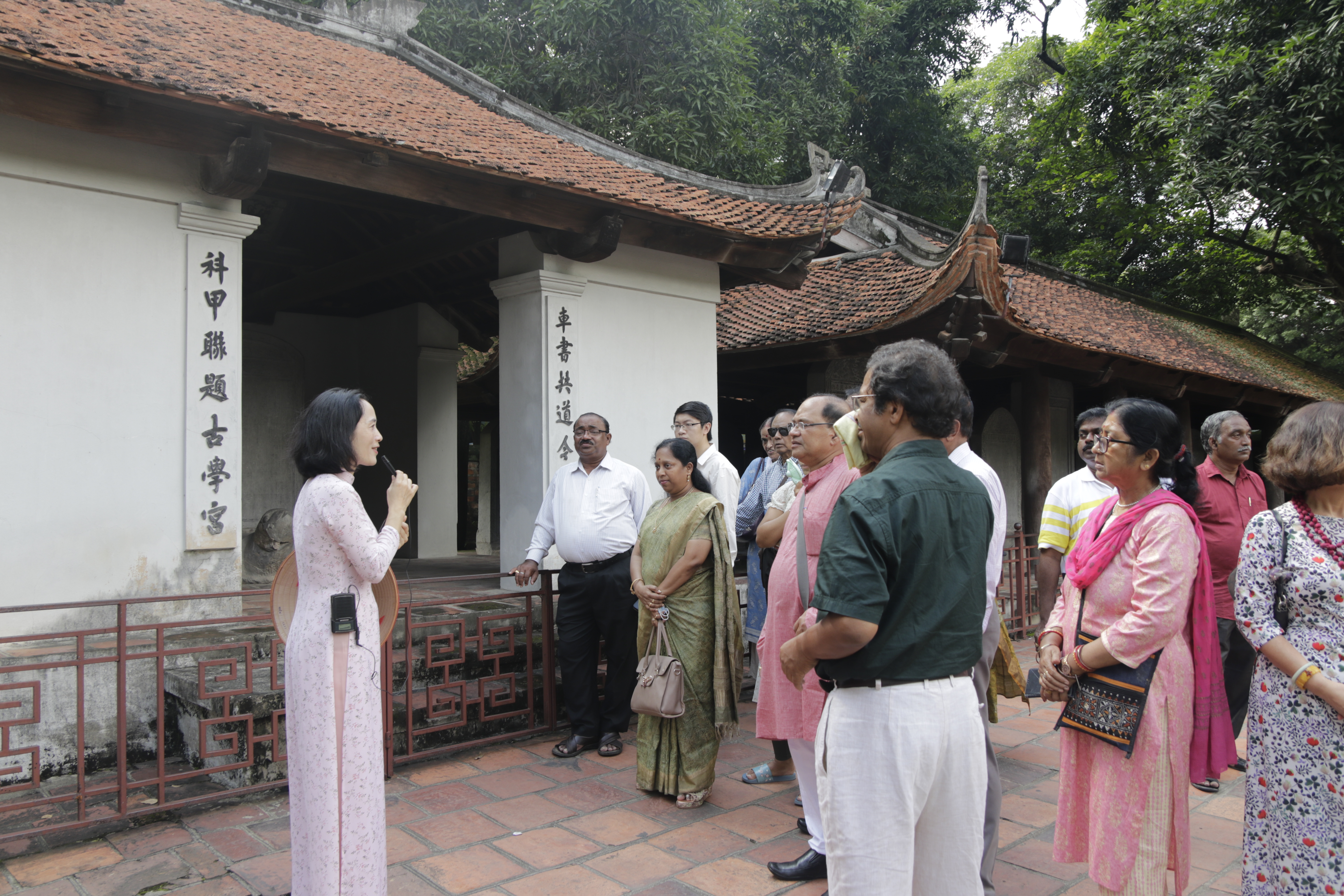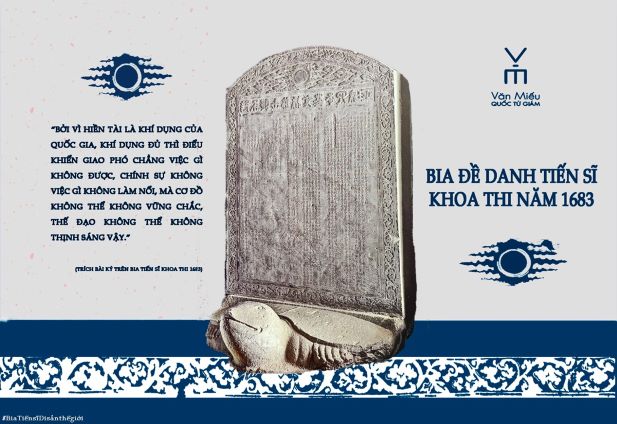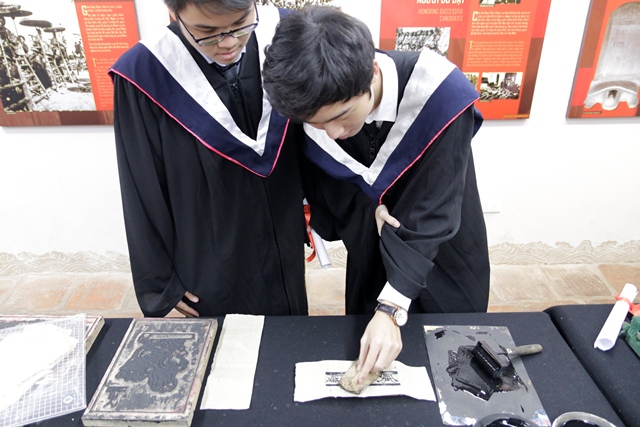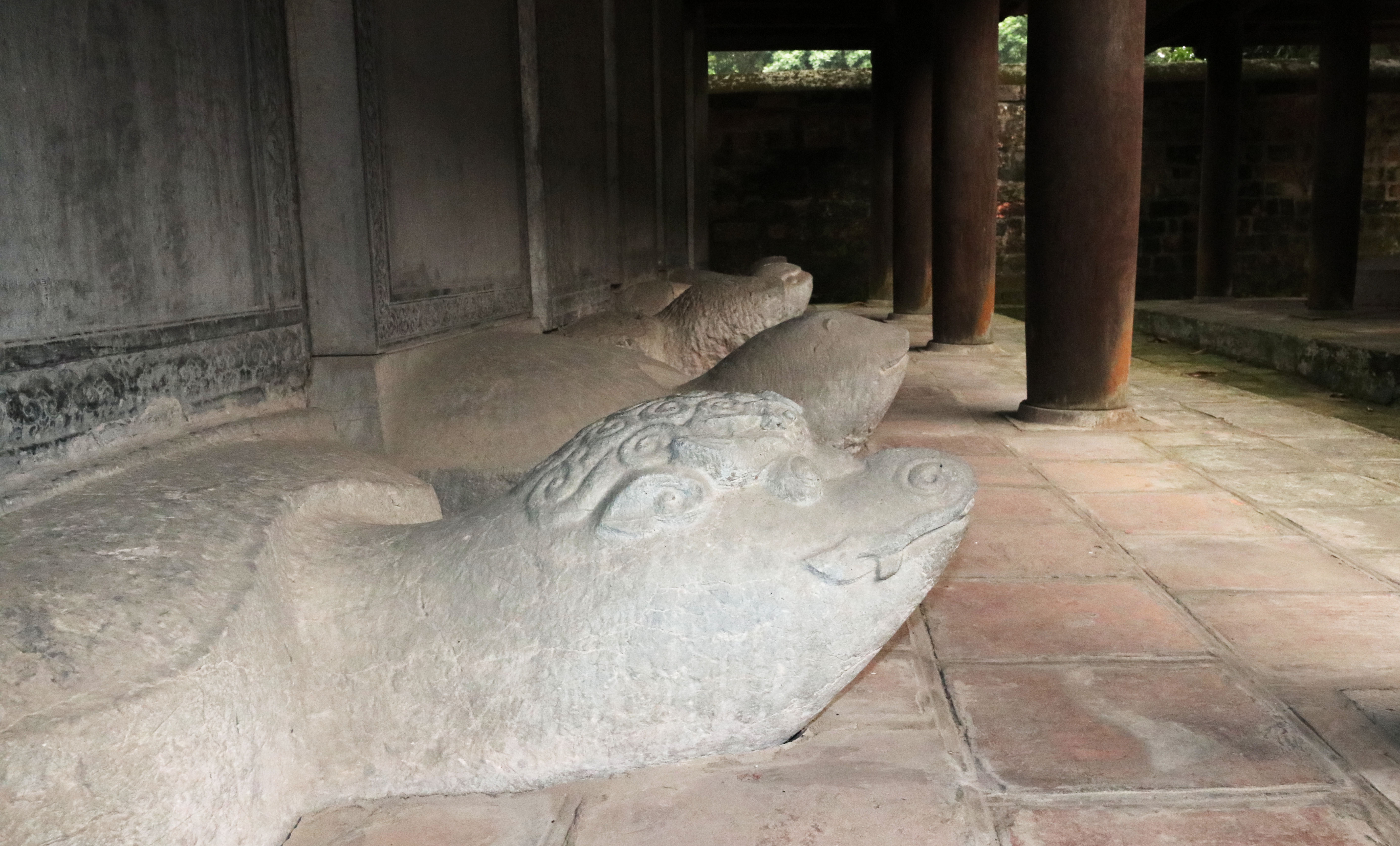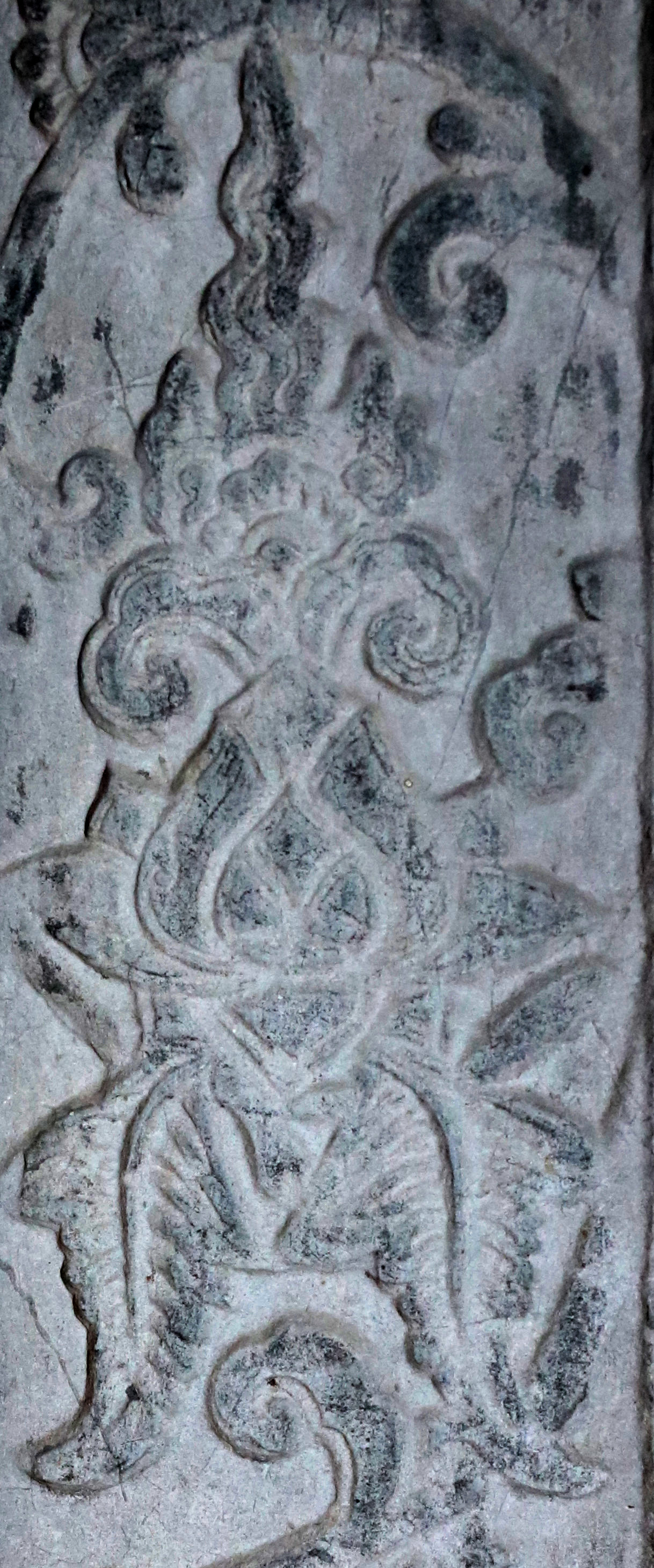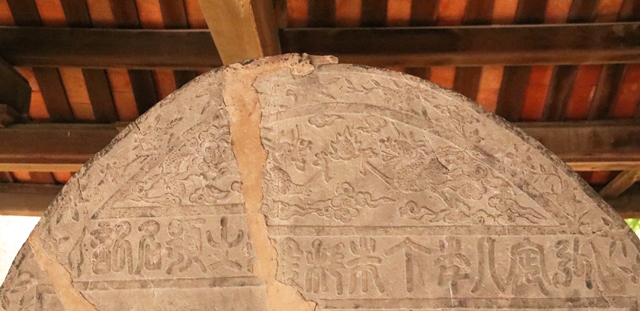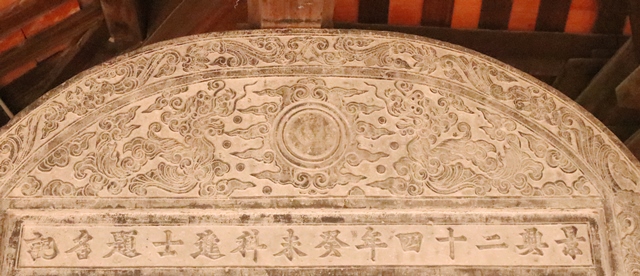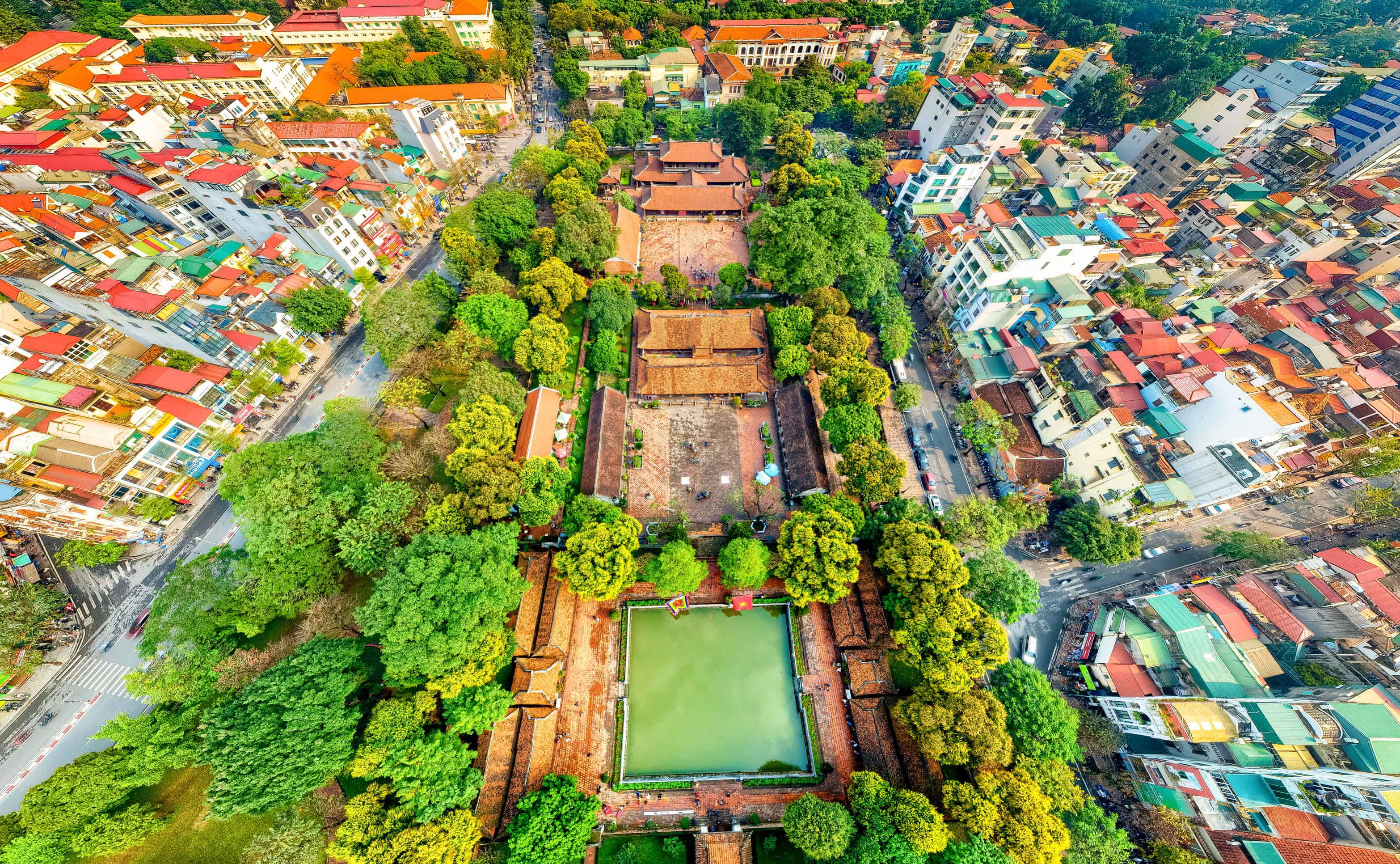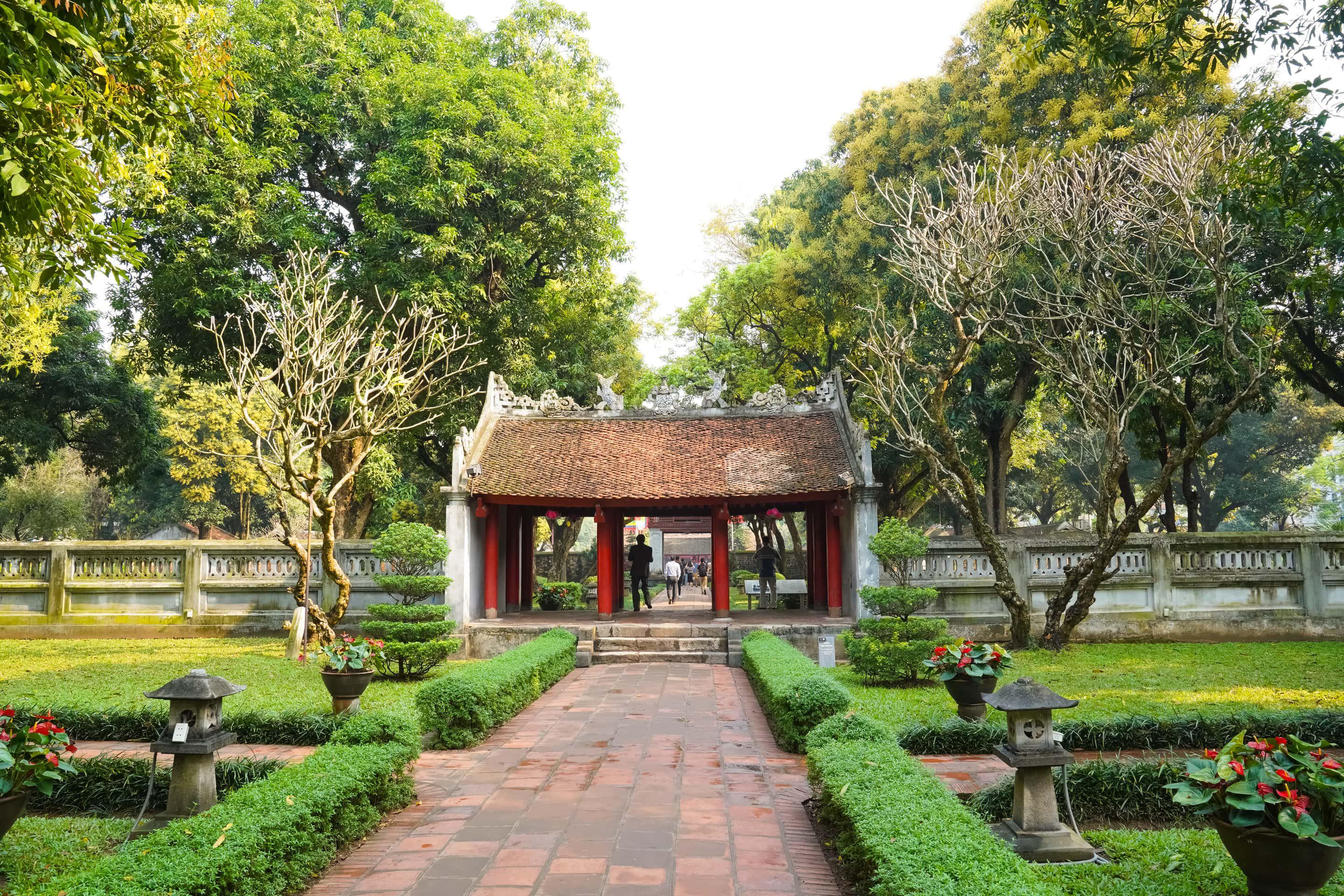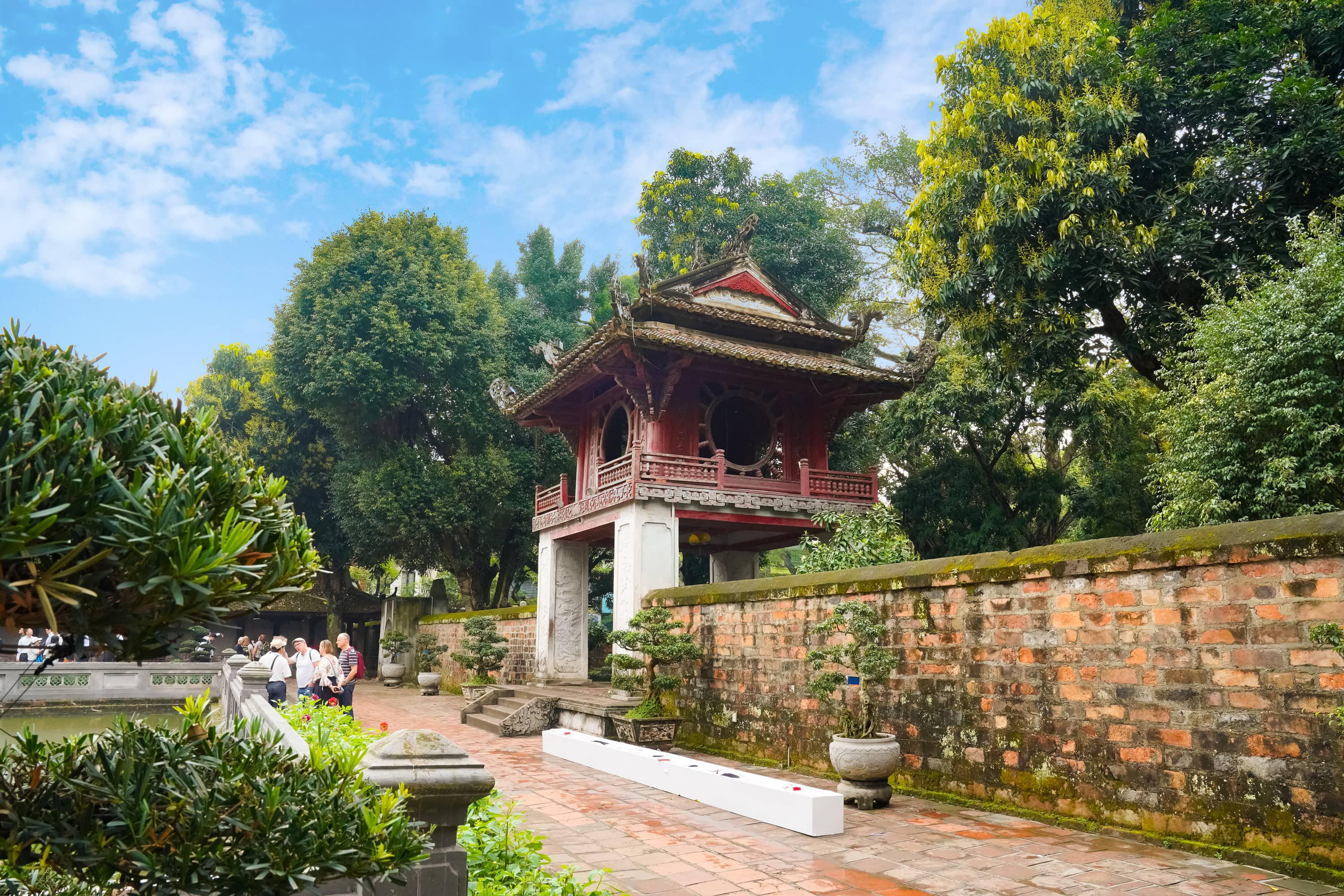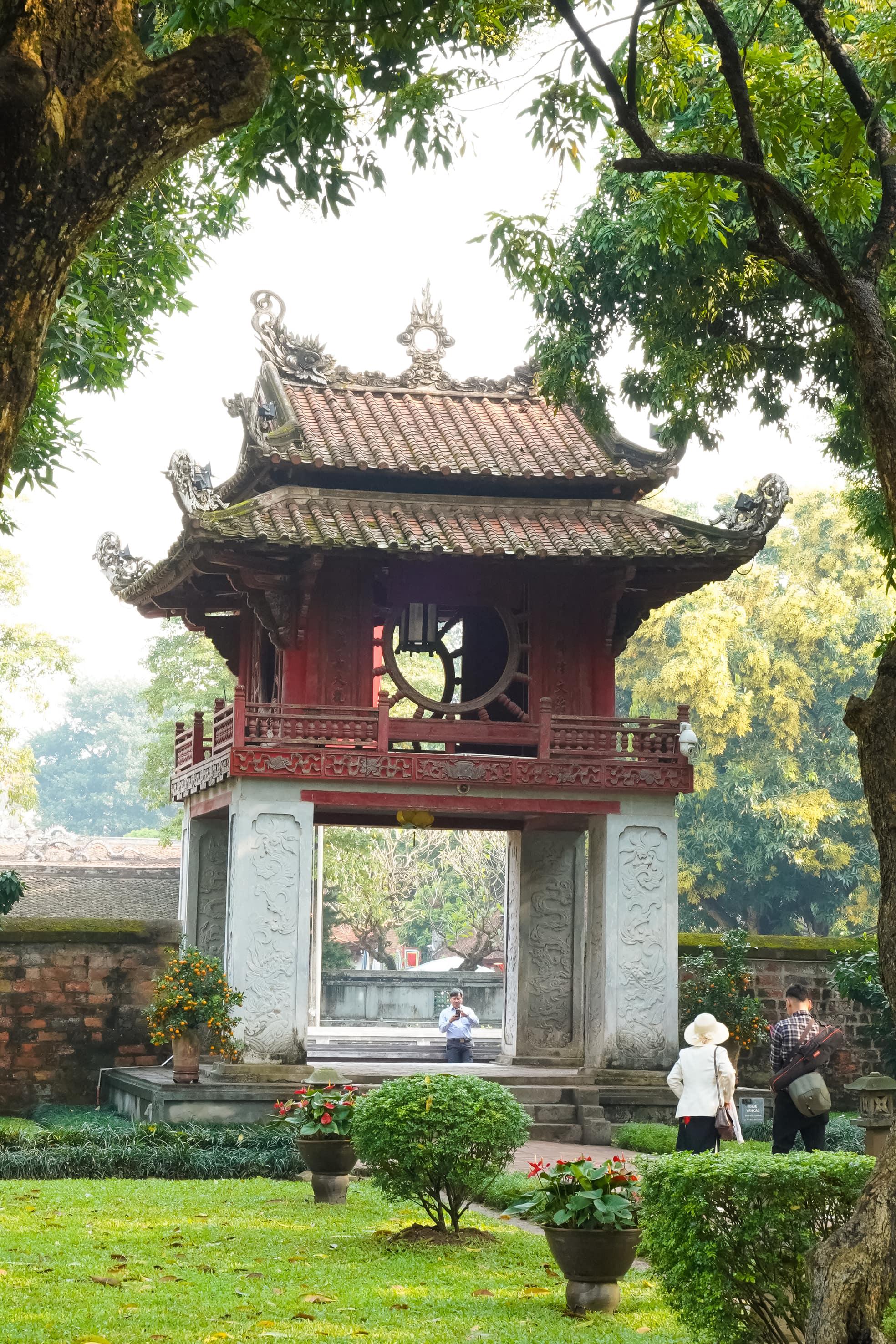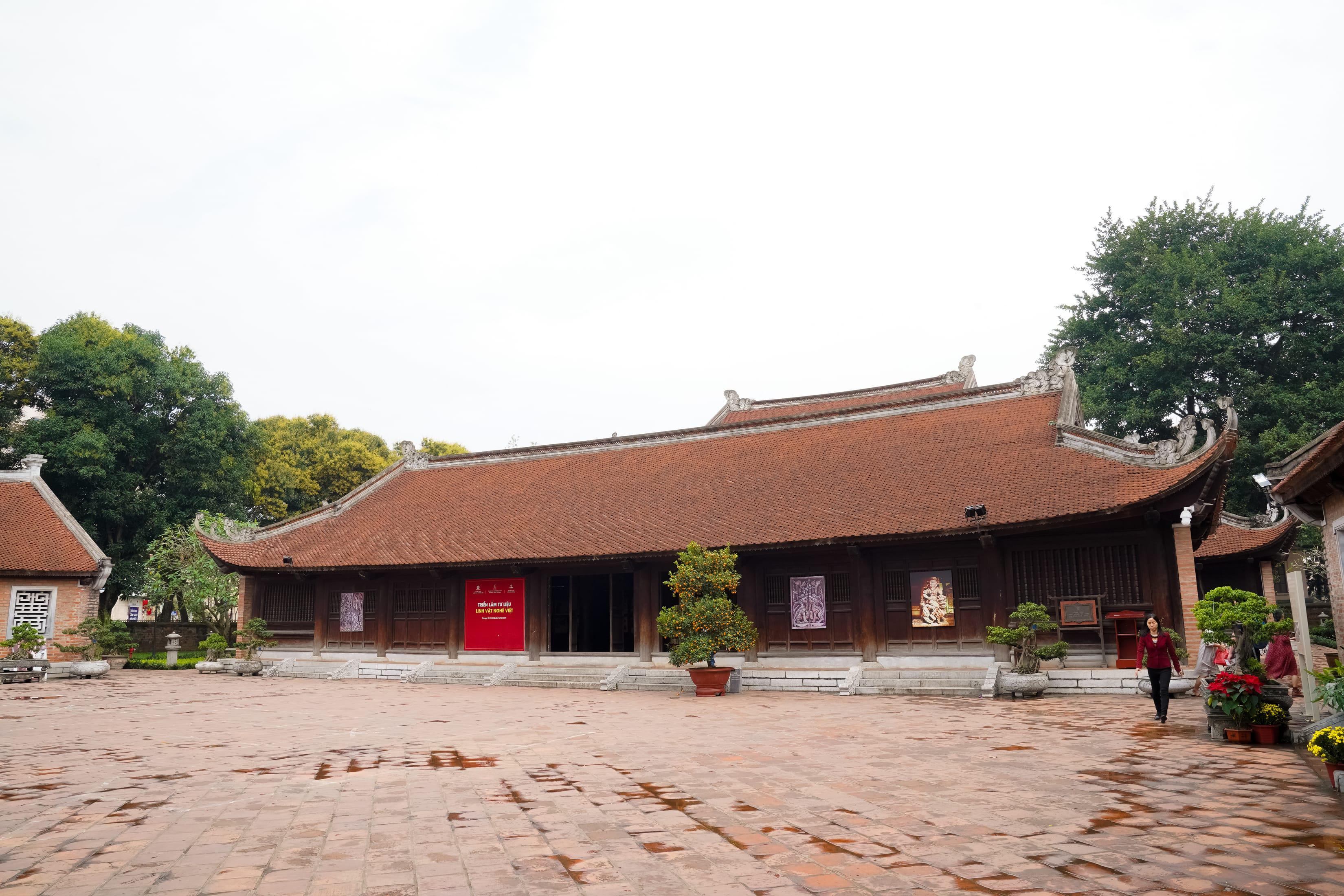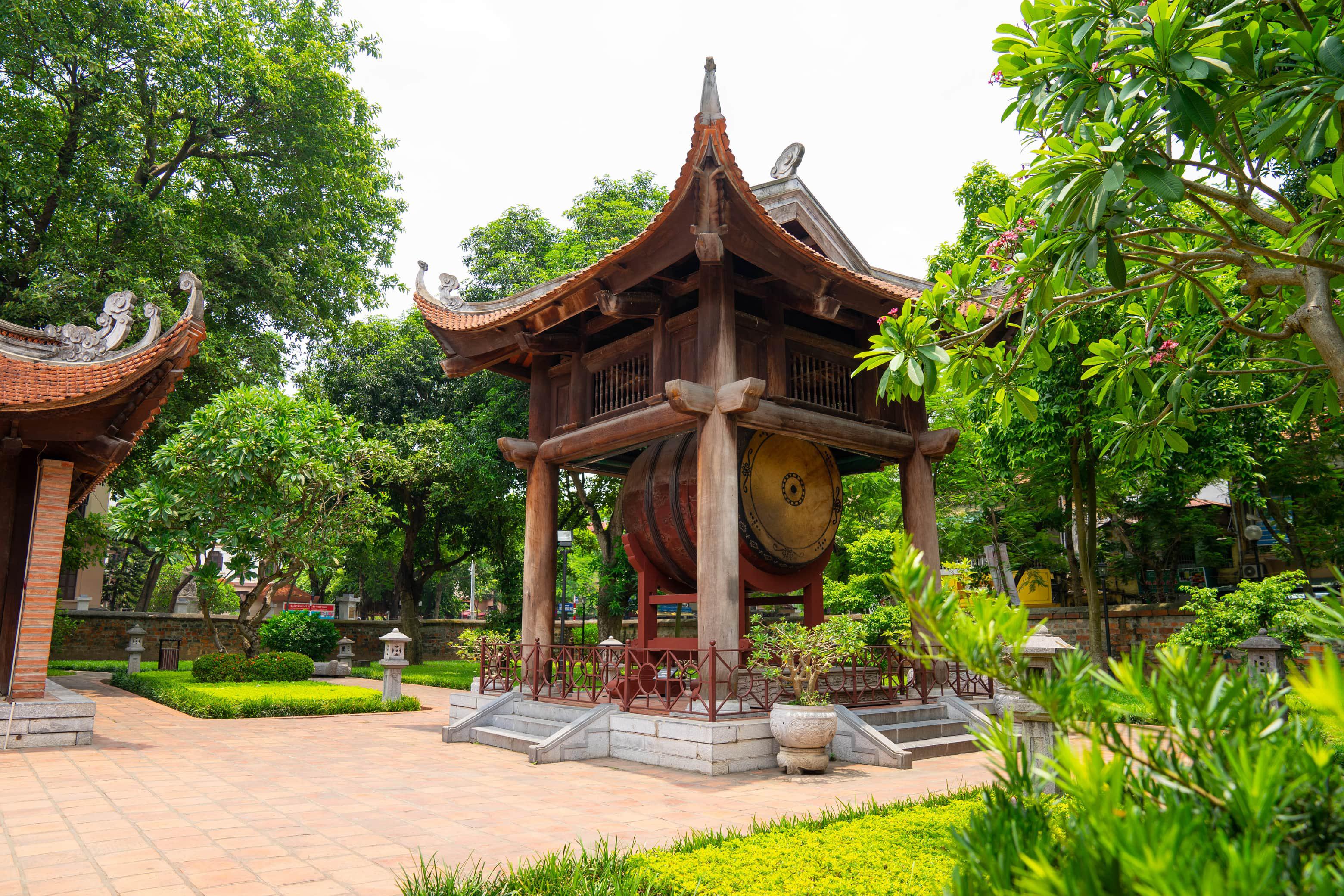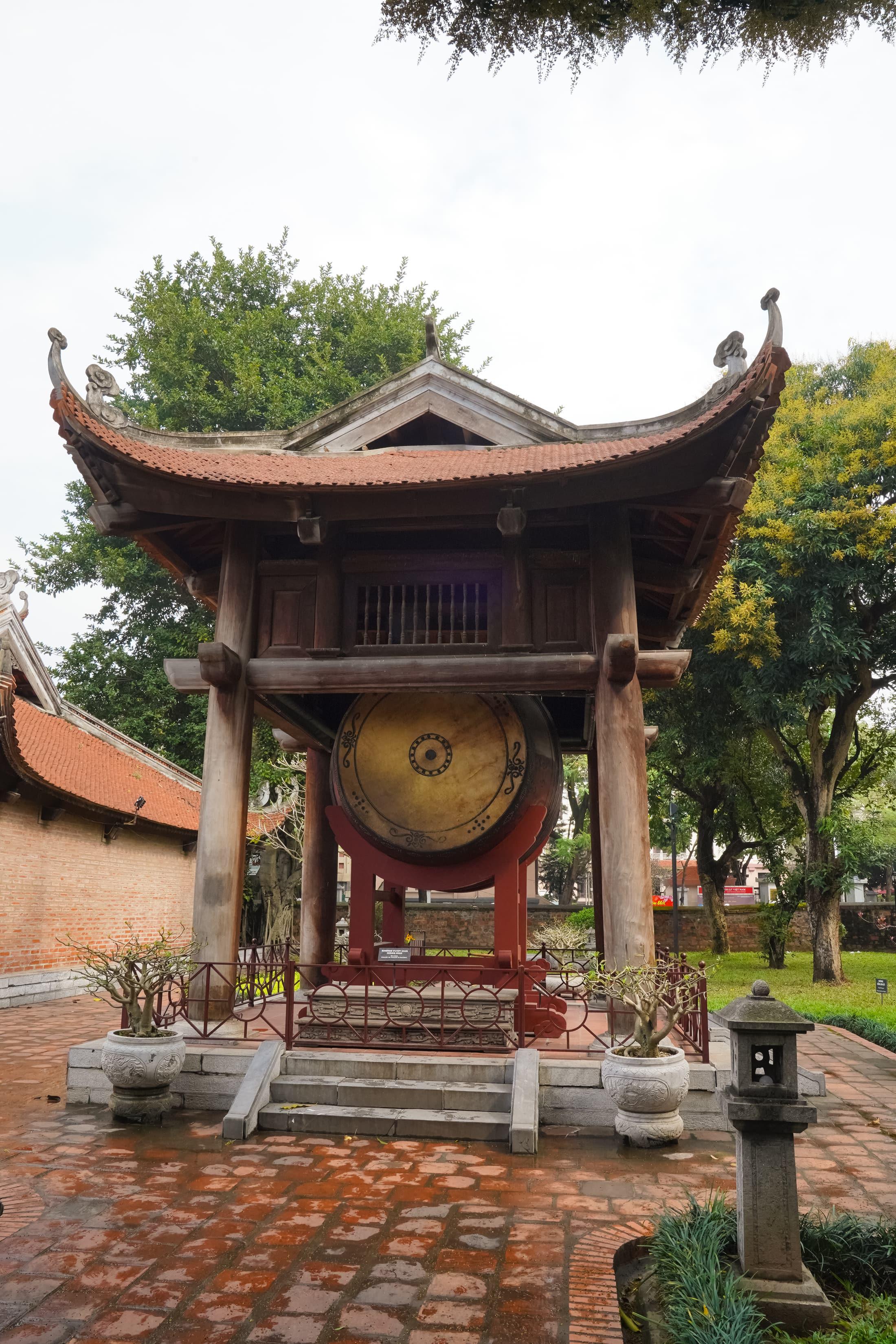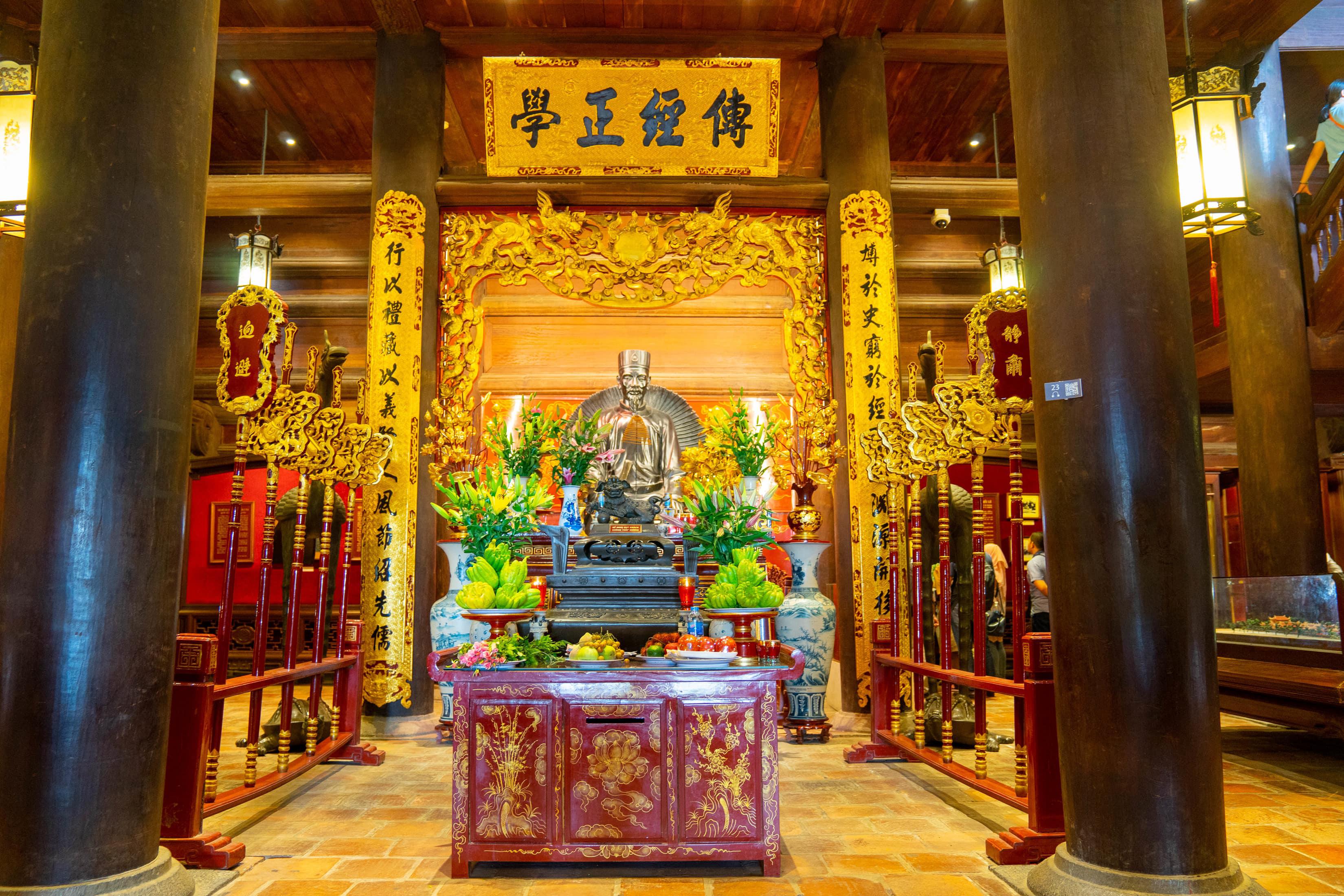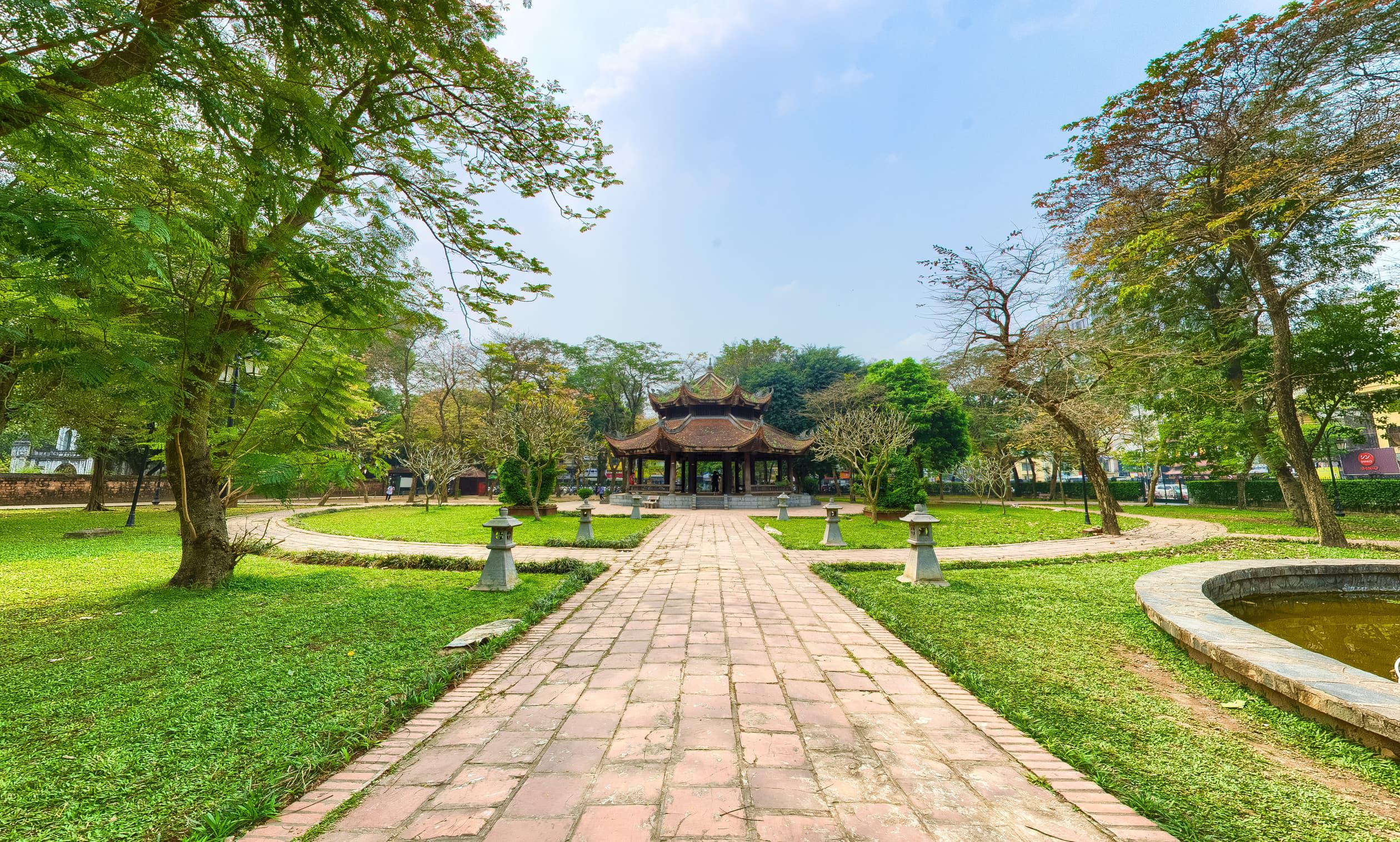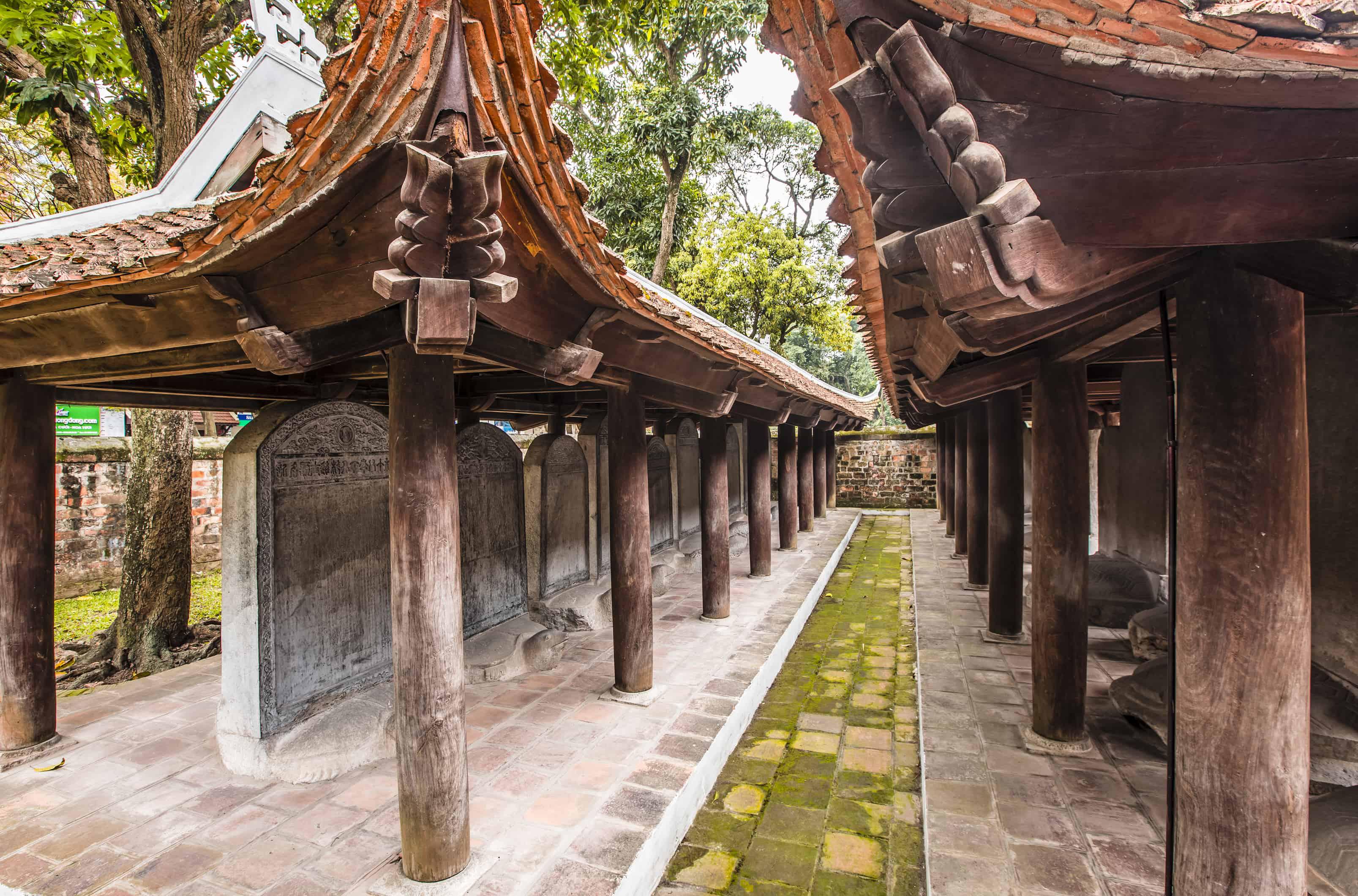HOÀNG GIÁP NGUYỄN NHÂN THIỆM – A DISTINGUISHED SCHOLAR FROM THANH HÓA
Among the 25 Doctoral Steles erected in the second series in 1653 (commemorating examinations held between 1554 and 1652), the stele for the 1583 examination (the 6th year of the Quang Hưng reign) records the names and native places of four laureates: three who earned the title of Tiến sĩ xuất thân (Doctor, Second Rank – Hoàng giáp) and one who attained the title of Đồng Tiến sĩ xuất thân (Doctor, Third Rank). Among them, Nguyễn Nhân Thiệm, the Đình nguyên (first laureate of the palace examination), stands out as a representative figure, noted for his significant contributions to the royal court and the nation.
Nguyễn Nhân Thiệm (1563–1645) was born in Bột Thái village, Hoằng Hóa district (today Hoằng Lộc commune, Thanh Hóa province). From an early age, he was renowned for his intelligence, love of learning, and precocious talent. In 1583, during the reign of King Lê Thế Tông, he participated in the imperial examination after passing the regional (Hương) exam. Excelling through the higher-level Hội exam, he advanced to the palace examination (Đình thí). There, he was awarded the highest distinction, Đình nguyên, and conferred the title Đệ nhị giáp Tiến sĩ xuất thân (Hoàng giáp) at the age of only 21 (as recorded in the Lịch triều đăng khoa lục).
After his success, he entered officialdom, serving the court faithfully. He rose to the position of Thái thường tự khanh (Head of the Court of Ceremonies), responsible for rituals, music, and state ceremonies at temples, shrines, and royal mausoleums. He was also entrusted with a diplomatic mission to the Ming court in China, demonstrating both his talent and the high confidence the Lê court placed in him
.
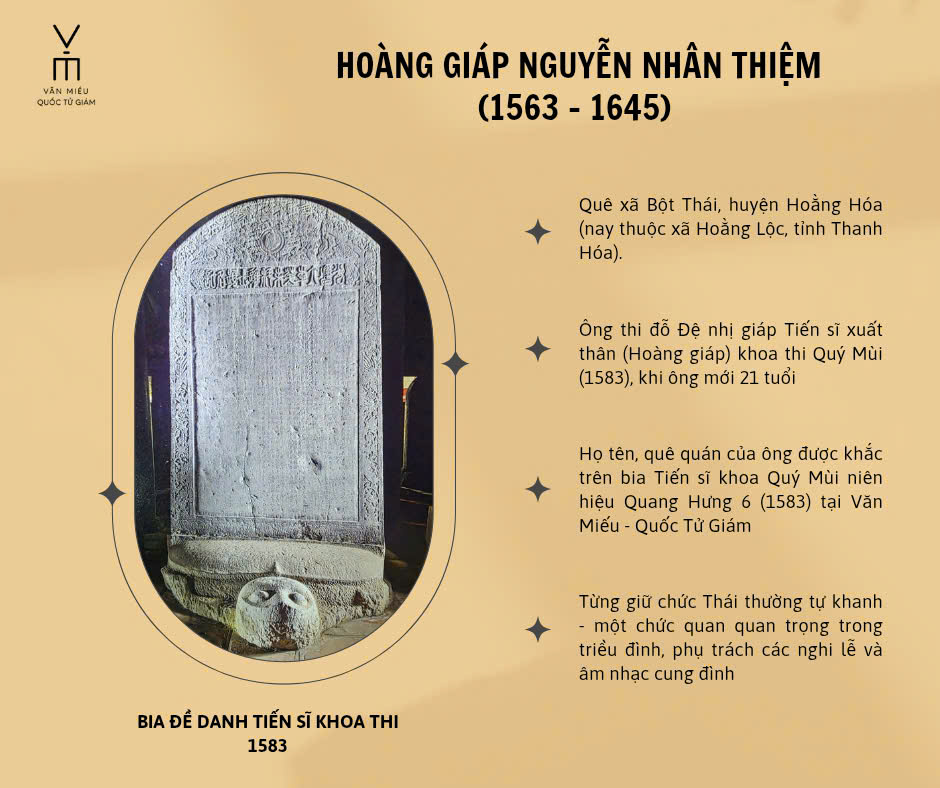
His career unfolded during a period of national restoration, when virtuous and capable scholars were appointed to assist the Lê kings and Trịnh lords in consolidating governance. Nguyễn Nhân Thiệm’s integrity, devotion to the nation, and prestige among the scholar-gentry earned him lasting respect from both his contemporaries and later generations.
In 1653, seventy years after the 1583 examination, a Doctoral Stele was erected in his honor at the Văn Miếu - Quốc Tử Giám. The stele inscription, composed by Thám hoa Khương Thế Hiền, Assistant Academician of the Hanlin Academy, praised the laureates of the exam: “Those who came forth in this examination were men of profound learning and talent, delighted to put their abilities to use for the nation – assisting in military affairs and suppressing the Mạc usurpers.” The inscription also emphasized their virtues: “Among them were men renowned for righteous governance, men esteemed for their integrity and uprightness.” These words testify to the talent and character of the laureates, among whom Nguyễn Nhân Thiệm was a shining exemplar.
Coming from a land steeped in scholarly tradition, Nguyễn Nhân Thiệm was one of 12 doctoral laureates from Hoằng Lộc commune, a place long celebrated for its culture of learning, where the Bảng môn đình (Hall of Honor) was erected to commemorate those who achieved academic distinction. By inscribing his name on the Doctoral Steles of Văn Miếu – Quốc Tử Giám, Nguyễn Nhân Thiệm not only affirmed his personal success but also contributed enduringly to the history of Vietnamese education and diplomacy under the Lê Restoration. His life and career exemplify the perseverance, moral integrity, and thirst for knowledge of past scholars, leaving a timeless legacy for posterity and enriching the intellectual heritage of Vietnam.
Translator: BP
DOCTORAL STELE OF THE QUÝ MÙI NATIONAL EXAMINATION, QUANG HƯNG 6 (1583)
The Doctoral Stele of the Quý Mùi National Examination, Quang Hưng 6 (1583), is a flat stele measuring 168 cm in height, 110 cm in width, and 25 cm in thickness. It was erected on November 16, 1653, seventy years after the examination had taken place.
The pediment of the stele is decorated with a pair of dragons flanking the sun and moon, radiating beams of light amidst auspicious clouds. The border is adorned with motifs of hoa bảo tiên (sacred floral patterns), phoenixes, and peacocks—birds regarded as Buddhist symbols. The stele’s title is inscribed in Seal Script, with characters 10 cm high.
The inscription engraved on the body of the stele provides valuable historical records of the 1583 National Examination, including the number of laureates, their names and native places, as well as the attitude of the court toward the recruitment and employment of talented scholars.
The purpose of erecting the stele is clearly expressed in the inscription: despite the country’s many hardships, the court always valued the selection of talents to contribute to national development: “At that time, military affairs still required attention, yet the search for virtuous and capable men was held as the highest priority.”
In this examination, His Majesty personally reviewed the results. Four candidates were conferred degrees: three obtained the title of Đệ nhị giáp Tiến sĩ xuất thân (Second-rank Doctoral Laureates), headed by Nguyễn Nhân Thiệm from Hoằng Hóa, Thanh Hóa; and one obtained the title of Đệ tam giáp Đồng Tiến sĩ xuất thân (Third-rank Doctoral Laureate).
The inscription also conveys moral lessons on the responsibility of scholars: “Let us consider those who passed this examination: some became renowned for virtuous governance, some for their integrity and uprightness. Yet among them, there must also have been those who were dishonest and weak-spirited. Once their names are engraved on this stone, posterity will point at them and say: this one succeeded, that one failed; this one was virtuous, that one was not. By this, the good may be encouraged, and the wicked may be warned.”
Furthermore, the stele emphasises the profound significance of its erection: “This stone is set up not merely to honour empty fame or to please the eye. Its deeper meaning lies in the encouragement and admonition it conveys.”
The Doctoral Stele of the 1583 examination thus stands as a “stone chronicle,” an invaluable source of historical data on the National Examination of 1583. At the same time, it serves as a moral reminder, encouraging future generations to reflect, learn, and follow the righteous path.
The Doctoral Stele of the Quý Mùi National Examination, Quang Hưng 6 (1583), at the Văn Miếu – Quốc Tử Giám
Thúy Hồng
TL: LH
DOCTORAL LAUREATE STELE OF THE CANH THÌN EXAMINATION, 3rd YEAR OF QUANG HƯNG ERA (1580)
The Doctoral Laureate Stele of the Canh Thìn Examination, 3rd year of the Quang Hưng era (1580), was erected during the stele erection campaign of 1653. Thus, it was seventy-three years after the examination was held that this stone stele was set up.
The stele is 164 cm high, 116 cm wide, and 20 cm thick. Distinctively, this is the only stele whose pediment is decorated with a pair of unicorns flanking a sacred gem, auspicious clouds, and ancient coins. Along the sides of the border are carvings of phoenixes, lotuses, peach blossoms, and pomegranates; at the base, a pair of galloping horses is depicted.
The inscription engraved on the stele is a valuable historical source, recording information about the examination, the dynasty’s emphasis on education and talent selection, as well as the names and native places of the six successful laureates.
In the year of Canh Thìn, 3rd year of the Quang Hưng era (1580), although the country was still in turmoil, the court placed the opening of the Doctoral Laureate Examination in Thanh Hóa as a foremost priority. This examination selected six men of talent. Immediately afterwards, the Royal Examination was held, in which His Majesty personally assessed and appointed: four men, led by Nguyễn Văn Giai, were conferred the title Doctoral Laureateand the other two were granted the title Associated Doctoral Laureate. The court generously rewarded all.
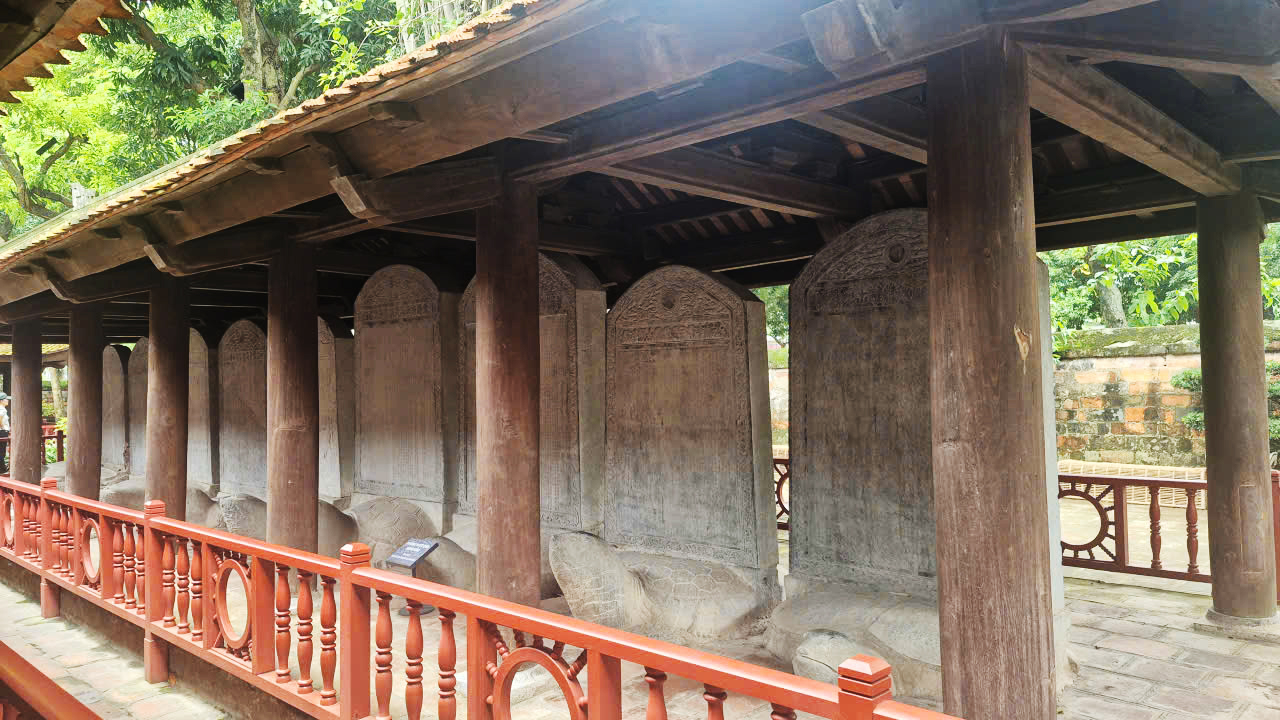
Following this examination, the court continued to hold the Quý Mùi (1583), Kỷ Sửu (1589), and Nhâm Thìn (1592) examinations, through which many scholars of intellect and integrity were selected. They contributed greatly to quelling the Mạc usurpation, regaining the capital, and reunifying the country. At the outset of the Restoration, while building military achievements and reviving civil governance, the court held the Ất Mùi Examination (1595), considered the first examination of the Restoration era, followed by the Mậu Tuất Examination (1598), the second one. During this period, more and more genuine candidates gathered, many capable Confucian scholars emerged, and they contributed to glorifying the nation’s tradition of learning and culture.
At the same time, the stele admonishes the ethical responsibilities of scholars: “Consider this very examination: some devised strategies to help quell rebellion; some managed state affairs to promote order; some served as envoys and fulfilled their missions; some held censorial posts and succeeded in rectifying the monarch’s mind. Their careers and reputations can thus be seen. But if some conducted themselves deceitfully, belonging to the corrupt and base, how could they escape the judgment of posterity?”
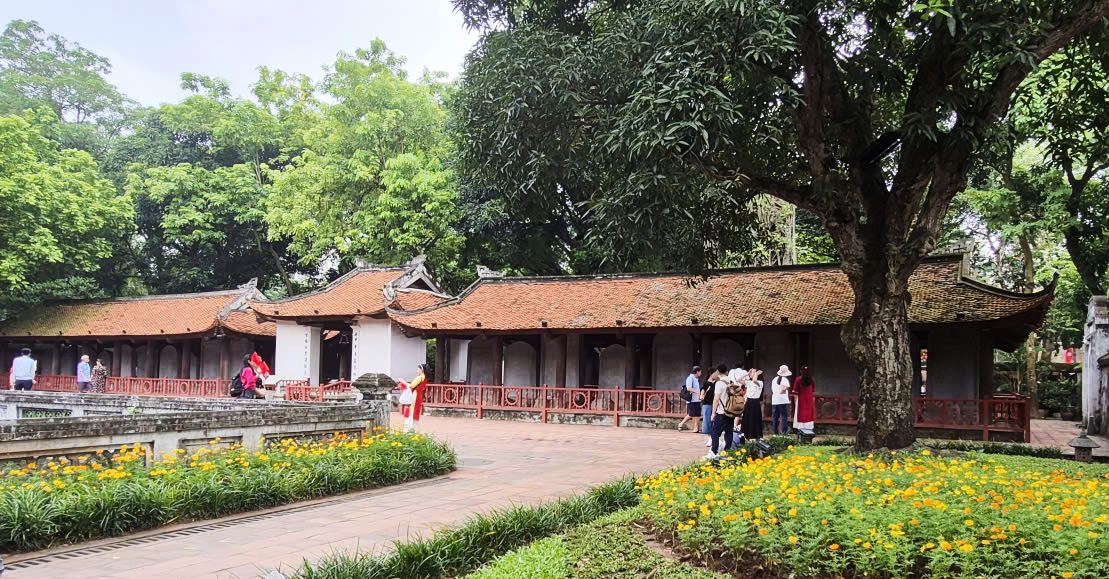
Finally, the inscription affirms the profound significance of erecting the stele:“This stone being set up, the virtuous shall be encouraged, the wicked shall take warning, the past shall be revealed, and the future widely instructed. Its benefit to education, its relation to governance – can such effects be considered small?”
The Doctoral Laureate Stele of the Canh Thìn Examination (1580) thus stands not only as a historical testimony to the examinations of the Lê Restoration period but also as an eternal reminder of the importance of honouring talent, encouraging virtue, restraining vice, safeguarding good governance, and nurturing the nation’s vital essence.
LH
DOCTORAL EXAMINATION STELE OF THE ĐINH SỬU YEAR (GIA THÁI 5, 1577)
The stele for the 1577 examination was erected on November 16 of the first year of Thịnh Đức (1653). It measures 168 cm in height, 118 cm in width, and 25 cm in thickness. The stele is flat and made of grayish stone.
The stele for the 1577 examination
In this examination, the imperial court successfully conferred degrees on five candidates. Of these, three attained the First Rank (Đệ nhất giáp) with the title Chế khoa xuất thân, and two attained the Second Rank (Đệ nhị giáp) with the title đồng Chế khoa xuất thân. Of the first-rank graduates, only Lê Trạc Tú, the top scorer, was from Phú Thọ; the other four were all Confucian scholars from Hà Tĩnh, a region renowned for its scholarly tradition.
At the end of the stele’s inscription are recorded the name and information of the person who composed the text: Court Academician Nguyễn Đăng Cảo. Nguyễn Đăng Cảo was the author of the steles for the 1554, 1565, and 1577 examinations. He achieved the titles Hội nguyên and Đình nguyên, and First-Class Doctor (Third Place, known as Thám hoa) in the 4th year of the Phúc Thái era (1646) during Emperor Lê Chân Tông’s reign, at the age of 28.
The Doctoral stele of the 1577 examination was erected together with 24 other steles during the second stele-erection phase in 1653 at the Văn Miếu – Quốc Tử Giám. The steles erected at this time exhibit a rich and diverse array of decorative motifs.
The pediment of the 1577 examination stele is decorated with auspicious clouds and a sun-and-moon motif. The stele’s main border is adorned with floral vine patterns. The lower border is carved with layered lotus petals, forming a continuous lotus pedestal design (liên hoa bảo toà). The stele’s title is engraved in seal script, with characters 10 cm tall.
A close-up photograph of the pediment and decorative border of the stele for the 1577 examination.
The base border of the stele is carved with layered lotus petals, forming a continuous lotus pedestal motif (liên hoa bảo toà).
The inscription of the 1577 examination stele is an enduring literary masterpiece, containing profound moral teachings and clarifying the significance of erecting a Doctoral Stele. It reads:
"...Now, whilst developing the Dynasty, His Majesty also tries to seek new talent. Adopting the regime for recruiting mandarins introduced in the Han era, He stipulates that a Royal examination will be held every three years, with the kind of test varying according to specific circumstances. Ever since the year of Đinh Sửu in the reign of Gia Thái, a significant number of talented people have been revealed through examinations. What a wonderful outcome! Moreover, the names of the laureates have been engraved on stone stelae to serve as examples to posterity.
The laureates now already Court mandarins should dedicate all of their talent to the fulfilment of their respective duties. They should be upright and honest, they should assist His Majesty and the population, so that future generations can commend them as righteous men who do not stain the honours they won during the examination.
If any of the laureates uses the honours he has gained to seek wealth and credit from the mandarinate, posterity will surely criticise him as an evil mean man who brings disgrace on our education system.
Therefore, this stone stele will serve both as praise and admonition..."
From the above excerpt of the stele, we see that the Doctoral Stele was erected not only to honor the scholars and encourage study and examination, affirming the value of talent to the country, but also to admonish scholars about their moral responsibilities, encouraging good deeds and preventing wrongdoing.
List of Doctoral Degree Recipients, 1577 Examination:
-
First Rank (Đệ nhất giáp, Chế khoa xuất thân) – 3 people:
-
Lê Trạc Tú: from Thượng Cốc commune, Lôi Dương district
-
Nguyễn Bật Lượng: from Cương Gián commune, Nghi Xuân district
-
Lê Phúc Nhạc: from Lạc Xuyên commune, Kỳ Hoa district
-
-
Second Rank (Đệ nhị giáp, đồng Chế khoa xuất thân) – 2 people:
-
Hồ Bỉnh Quốc: from Bình Lãng commune, Thiên Lộc district
-
Nguyễn Hoành Từ: from Phất Não commune, Thạch Hà district
-
References:
-
Van Mieu – Quoc Tu Giam Center for Cultural and Scientific Activities (2010), Sino-Nôm Stone Inscriptions at Văn Miếu – Quốc Tử Giám, pp. 353-355.
-
-
Trần Hậu Yên Thế and Trần Trung Hiếu (2018), Vietnamese Features on the Doctoral Steles of Văn Miếu – Quốc Tử Giám, Fine Arts Publishing House, pp. 30, 99.
BIA ĐỀ DANH TIẾN SĨ CHẾ KHOA ẤT SỬU NIÊN HIỆU CHÍNH TRỊ 8 (1565)
Bia Tiến sĩ khoa thi Chế khoa năm Ất Sửu, niên hiệu Chính Trị 8 (1565) là nguồn sử liệu vô cùng quý giá trong hệ thống 82 bia tiến sĩ đặt tại Di tích Văn Miếu - Quốc Tử Giám.
Bia được dựng đợt 2, năm 1653 (từ khoa thi 1554 đến khoa thi 1652). Bia có chiều cao 172cm, rộng 124cm, độ dày 25cm. Tấm bia không chỉ là biểu tượng của truyền thống hiếu học và đạo làm người của kẻ sĩ, mà còn là tác phẩm nghệ thuật độc đáo cho thấy kỹ nghệ chạm khắc đạt đỉnh cao, đặc biệt là các đồ án trang trí trên trán bia và diềm bia được người xưa gửi gắm nhiều thông điệp ý nghĩa.
Trên trán bia khoa thi 1565, lần đầu tiên xuất hiện hình tượng Rồng. Vốn là linh vật đứng đầu trong danh sách “Tứ linh”, Rồng luôn được coi là đại diện thiêng liêng, cao quý và chỉ dành cho các bậc quân vương. Tuy nhiên, Rồng trên trán bia khoa thi 1565 được tạo tác chỉ có 3 móng, dưới dạng “Rồng thức”. Hình Rồng uốn khúc từ trên vòng xuống, vi vảy chạm rõ, uy nghi đĩnh đạc, râu tóc uốn lượn, thần thái dũng mãnh chầu vào vầng nhật nguyệt với các tia sáng xung quanh. Rùa đội bia có dáng cổ rụt, mặt bẹt, sống mũi uốn cao, hốc mũi và mắt tạo thành hình chữ T, mắt lồi, miệng rộng, mai cong đều và có một gờ nhỏ chạy dọc sống lưng. Phần trên cùng sát với trán bia có khắc niên đại tổ chức khoa thi theo thể chữ triện: “Chính Trị bát niên Ất Sửu khoa Chế khoa đề danh ký” (Bài ký đề danh khoa thi Chế khoa Ất Sửu niên hiệu Chính Trị năm thứ 8).
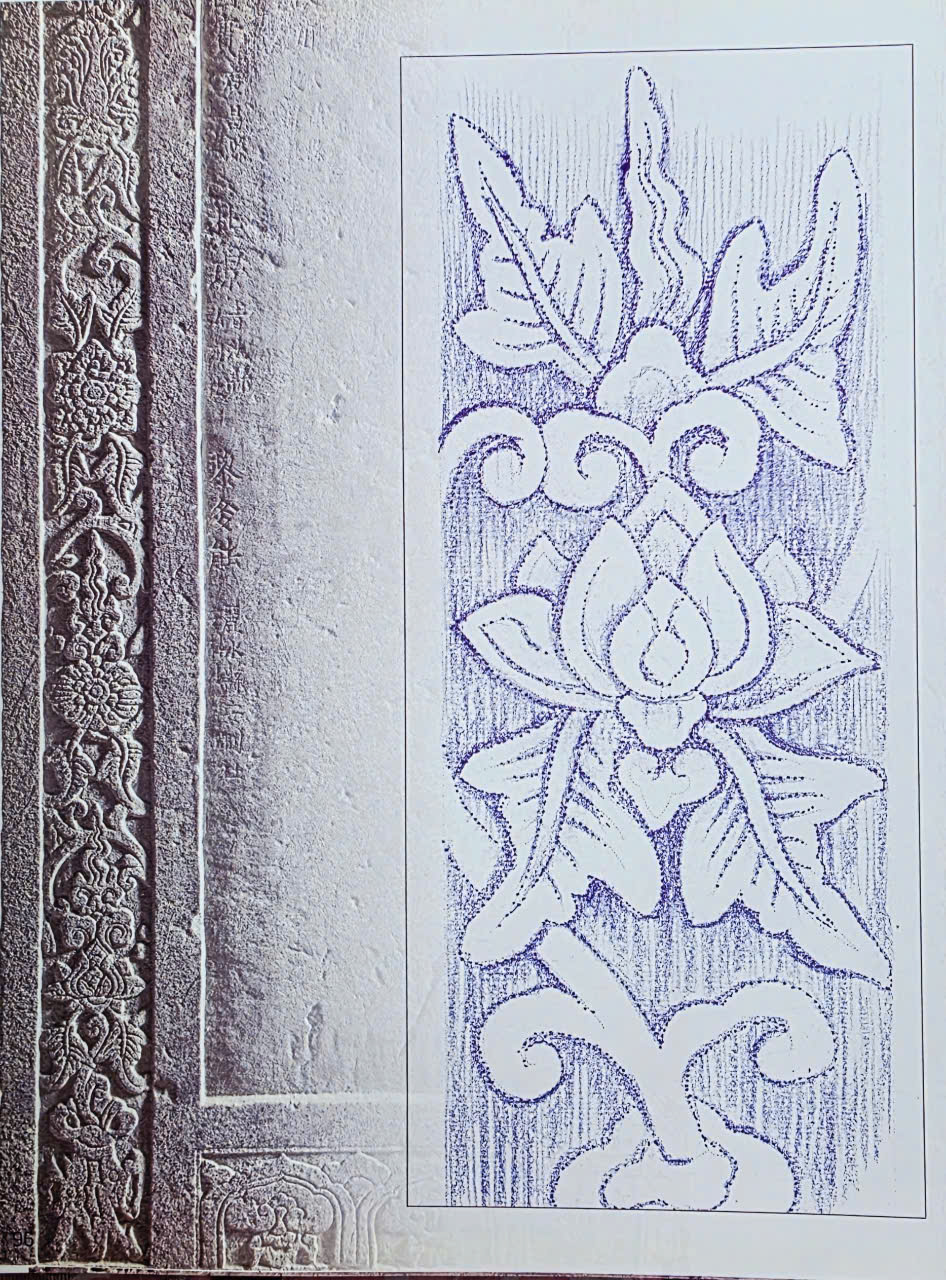
Hai bên diềm bia trang trí hoa bảo tiên (bảo tướng hoa)
Trên thân bia có khắc bài văn bia bằng chữ Hán do Hàn lâm viện Đãi chế Nguyễn Đăng Cảo vâng sắc soạn. Trong đó có nội dung đề cao vai trò, giá trị hiền tài đối với đất nước, cần sự chăm lo, vun trồng của triều đình: “Đến nay Hoàng thượng bệ hạ nghĩ muốn mở mang nghiệp lớn của tiên tổ, muốn mở quy chế lậu dài; đặc biệt nghĩ hiền tài là nguyên khí của quốc gia phải nên vun trồng; khoa cử là chế độ của triều đỉnh phải nên chấn chỉnh…”
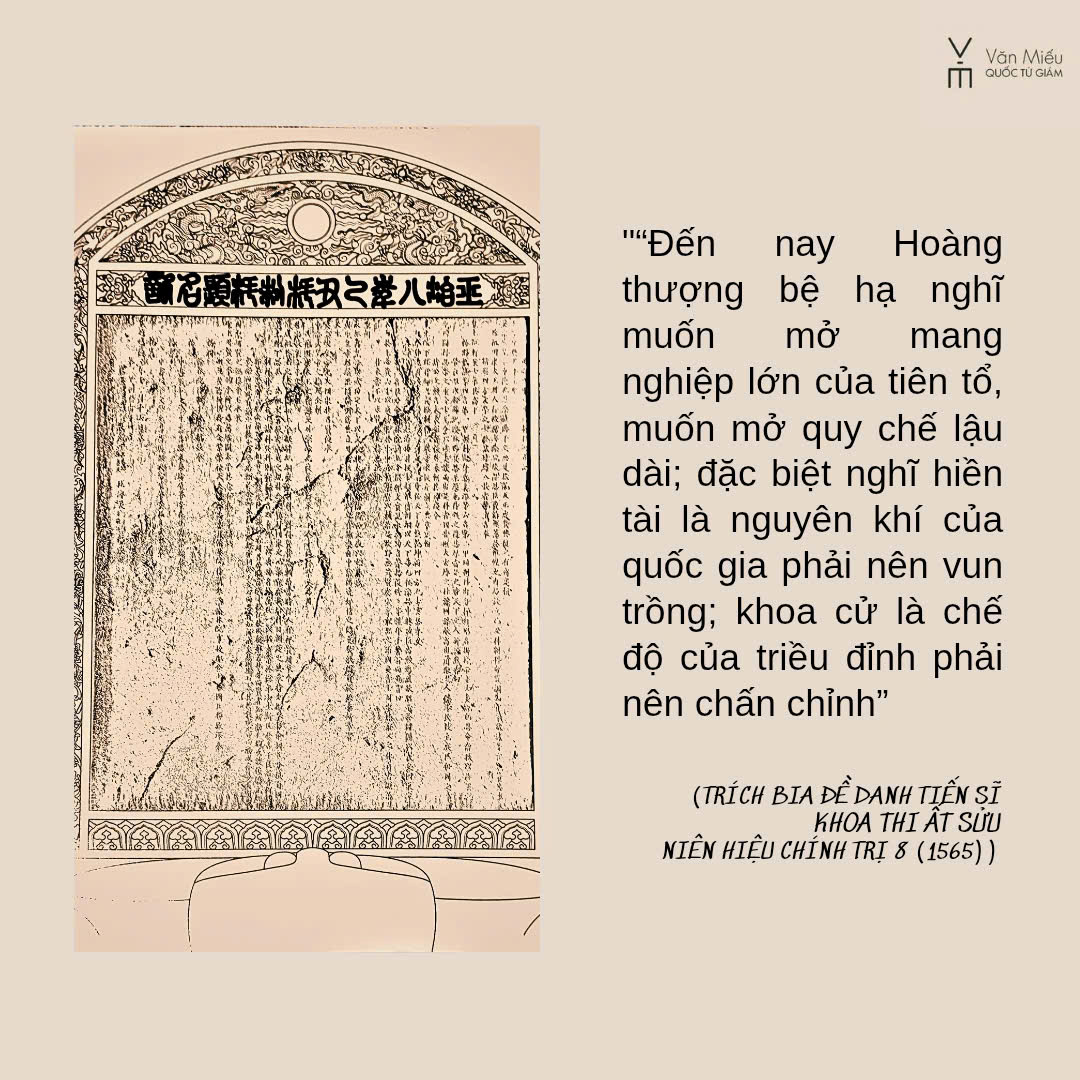
Cuối bài văn bia chép họ tên, thông tin của người viết chữ trên bia: Trung thư giám Hoa văn học sinh người phường Vĩnh Thái huyện Thọ Xương, trú quán xã Hoa Đường là Đào Vinh Lộc vâng sắc viết chữ chân. Trung thư giám Hoa văn học sinh người phường Báo Thiên huyện Thọ Xương, nhà ở xã Hoa Đường là Vũ Cử vâng sắc viết chữ triện.
Khoa thi này triều đình lấy đỗ được 10 người, trong đó có 4 người đỗ Đệ nhất giáp Chế khoa xuất thân và 6 người đỗ Đệ nhị giáp đồng Chế khoa xuất thân. Họ tên, quê quán của 10 vị Tiến sĩ được khắc bên trái thân bia theo thứ hạng từ cao xuống thấp.
DANH SÁCH TIẾN SĨ KHOA ẤT SỬU, NIÊN HIỆU CHÍNH TRỊ 8 (1565):
Đệ nhất giáp Chế khoa Tiến sĩ xuất thân, 4 người:
LÊ KHIÊM: xã Bảo Đà huyện Lôi Dương
BÙI KHẮC NHẤT: xã Bột Thái huyện Hoằng Hóa
ĐỖ TẾ MỸ: xã Cổ Đôi huyện Nông Cống
DƯƠNG TRÍ DỤNG: xã Bạt Trạc huyện Thiên Lộc
Đệ nhị giáp đồng Chế khoa Tiến sĩ xuất thân, 6 người
LÊ NGHĨA TRẠCH: xã Cổ Đôi huyện Nông Cống
ĐINH DOÃN TÍN: xã Văn Giáp huyện Thượng Phúc
LÊ VĂN XƯỚNG: xã Đan Hải huyện Nghi Xuân
HOÀNG QUỐC THỰC: xã Dực Thượng huyện Quảng Xương
ĐỖ CẢNH: xã Hoằng Liệt huyện Thanh Trì
LÊ ĐA NĂNG: Xã Yên Chế huyện Lệ Thuỷ
Nhan Vu
DOCTORAL STELE OF THE GIÁP DẦN EXAMINATION – 6TH YEAR OF THE THUẬN BÌNH ERA (1554)
The doctoral stele commemorating the Giáp Dần examination held in the 6th year of the Thuận Bình era (1554) is located at the Văn Miếu – Quốc Tử Giám historical site. The stele stands 164 cm tall, 119 cm wide, and 23 cm thick. Its pediment is adorned with a radiant sun and moon motif surrounded by sacred clouds. The stone turtle supporting the stele features a flat head, T-shaped eye and nose sockets, round and protruding eyes, a wide mouth, and a ridge running down the centre of its back. At the top of the stele, just below the pediment, an inscription in seal script indicates the year and title of the examination: “Record of the Names of Doctoral Laureates of the Giáp Dần Examination in the Sixth Year of the Thuận Bình Era.”
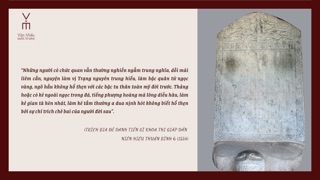
The stele’s inscription, written in classical Chinese, was composed by Nguyễn Đăng Cảo, an Academician of the Imperial Academy, by royal command. Nguyễn Đăng Cảo (1619–?) ranked first in both the National Examination and the Royal Examination, earning the title of Third Laureate of the First-rank Doctoral Degree (Thám hoa) in 1646. He was the elder brother of Nguyễn Đăng Ninh and the uncle of both Nguyễn Đăng Tuân and Nguyễn Đăng Đạo.
The stele text includes moral guidance for laureates, with lines such as:“Those who hold official positions must always reflect on loyalty and righteousness, cultivate honesty and diligence, aspire to be loyal and filial First-rank Laureates, to be virtuous and noble gentlemen—so as not to feel ashamed before the exemplary sages of the past. But if one is polished on the outside yet rough within, if they have the voice of a phoenix but feathers of a hawk, if they are deceitful and cowardly, base and sycophantic, then they will not escape the criticism and condemnation of posterity.”
In this examination, the imperial court selected 13 successful candidates:
- 5 individuals attained the title of Đệ nhất giáp Chế khoa xuất thân
- 8 individuals attained the title of Đệ nhị giáp đồng Chế khoa xuất thân
Several of these doctoral laureates later held high-ranking government positions, such as Đinh Bạt Tụy, who became Minister of the Ministry of Military Affairs, and Nguyễn Đức, who was appointed Minister of the Ministry of Justice.
At the end of the inscription, the names and backgrounds of the calligraphers are also recorded:
- Đỗ Soạn, a scholar from Thái Lạc village, Văn Giang district, a student of the Court Office’s Institute of Chinese Studies (Hoa văn học sinh Trung thư giám), wrote the inscription in standard script.
- Đỗ Công Vị, a student of the same institution from Thịnh Quang ward, Quảng Đức district, wrote the seal script.
This doctoral stele from the Giáp Dần examination of the Thuận Bình 6 era (1554) is a highly valuable historical source within the collection of 82 stelae at the Special National Relic Site of Văn Miếu – Quốc Tử Giám.
LIST OF DOCTORAL LAUREATES – GIÁP DẦN EXAMINATION, 6TH YEAR OF THUẬN BÌNH ERA (1554)
Đệ nhất giáp Chế khoa xuất thân – 5 laureates:
- Đinh Bạt Tụy – Bùi Khổng village, Hưng Nguyên district
- Nguyễn Văn Nghi – Ngọc Bôi village, Đông Sơn district
- Nguyễn Sư Lộ – Bột Thái village, Hoằng Hóa district
- Phan Tất Thông – Hạ Thành village, Đông Thành district
- Đỗ Danh Đại – Cổ Đôi village, Nông Cống district
Đệ nhị giáp đồng Chế khoa xuất thân – 8 laureates:
- Chu Quang Trứ – Nam Hoa Thượng village, Thanh Chương district
- Nguyễn Chiêu – Yên Việt Thượng village, La Sơn district
- Lê Văn Hiếu – Châu Xuyết village, Nông Cống district
- Biện Hoành – Hoa Duệ village, Kỳ Hoa district
- Nguyễn Công Dự – Văn Lâm village, Quảng Xương district
- Vũ Hoán – Hồng Khê village, Duy Tiên district
- Nguyễn Sằn – Dịch Vọng village, Từ Liêm district
- Nguyễn Đức – Nỗ Bạn village, Thanh Trì district
An Nhiên
LH
DOCTORAL STELE OF THE TÂN SỬU EXAMINATION, 12TH YEAR OF THE HỒNG ĐỨC REIGN (1481)
The 82 doctoral steles at Văn Miếu – Quốc Tử Giám historical site have long become an inseparable part of Vietnam's cultural heritage, serving as vivid evidence of the nation's tradition of scholarly pursuit and knowledge. On the front of each stele, inscriptions record events related to the imperial examinations and the names of the successful doctoral candidates. Notably, some steles have inscriptions on both sides, including the doctoral stele of the Tân Sửu examination from the 12th year of the Hồng Đức reign (1481).
The front of the stele inscribes a text detailing that, in the 1481 Hội examination, more than 2,000 scholars participated, but only 40 were selected to advance to the Royal examination. After the royal exam, the King reviewed the exam papers and selected successful candidates from all three ranks of the doctoral degree. Among them, three individuals achieved the first rank, eight were placed in the second rank, and 29 in the third rank.
The text on the stele also explains the purpose of erecting the doctoral stele to educate scholars with a moral lesson: "So, those whose names are inscribed on this stone stele are naturally required to perfect themselves in morality, and to polish up their mentality by means of literature, so as to remain genuine doctoral laureates of a Royal exam, who will never betray the Court’s trust and never give away chances to make use of their knowledge."
On the back of the stele, the names and titles of the examiners are inscribed. These examiners were high-ranking officials in the royal court, all distinguished scholars and virtuous individuals:
Chief Examiner: Commander-in-chief, CountTrịnh Duy Hiếu (title: Đặc tiến phụ quốc Thượng tướng quân Trung quân Đô đốc phủ đường phủ sự, Thái bảo Bình lạc bá kiêm Tôn nhân phủ Tôn nhân lệnh);Minister of Finance Hoàng Nhân Thiêm (title: Phụng trực đại phu Hộ bộ thượng thư tư chính thượng khanh).
Panel of Judges: Chief academician Thân Nhân Trung (title: Phụng trực đại phu Hàn lâm viện thừa chỉ Đông các đại học sĩ Tư chính thượng khanh), Academician Đỗ Nhuận (title: Trung trinh đại phu, Hàn lâm viện thị độc kiêm Đông các đại học sĩ Khuông doãn mỹ); Vice-Rector of Quốc Tử Giám, Historian Ngô Sĩ Liên (Title: Triều liệt đại phu, Quốc Tử Giám Tư nghiệp, kiêm Sử quan tu soạn Tu thiện doãn); Academician Lương Thế Vinh (title: Hiển cung đại phu Hàn lâm viện Thị thư kiêm Sùng văn quán Tú lâm cục Tư huấn)
Supervisor: Procurator Quách Đình Bảo (title: Trung trinh đại phu, Ngự sử đài Đô Ngự sử Tả Xuân phường Tả trung doãn Khuông Mỹ doãn);Vice-minister of Military Affairs Đào Văn Hiển (title: Triều liệt đại phu Tu thiện doãn).
Over the course of more than 500 years, the doctoral stele of the Tân Sửu examination from the 12th year of the Hồng Đức reign (1481) has not only served as a precious historical relic but also as a symbol of the nation's tradition of honoring knowledge and virtue. Through each carved inscription, the stele not only commemorates the achievements of scholars but also serves as a reminder of the intellectual's responsibility to the country. It also stands as evidence of the court's attention to education, the recruitment of talented individuals, and the promotion of the country's development by establishing a sustainable and long-lasting scholarly culture. The doctoral steles are not only past treasures but also a source of inspiration for future generations in their pursuit of learning, self-cultivation, and dedication to the nation.
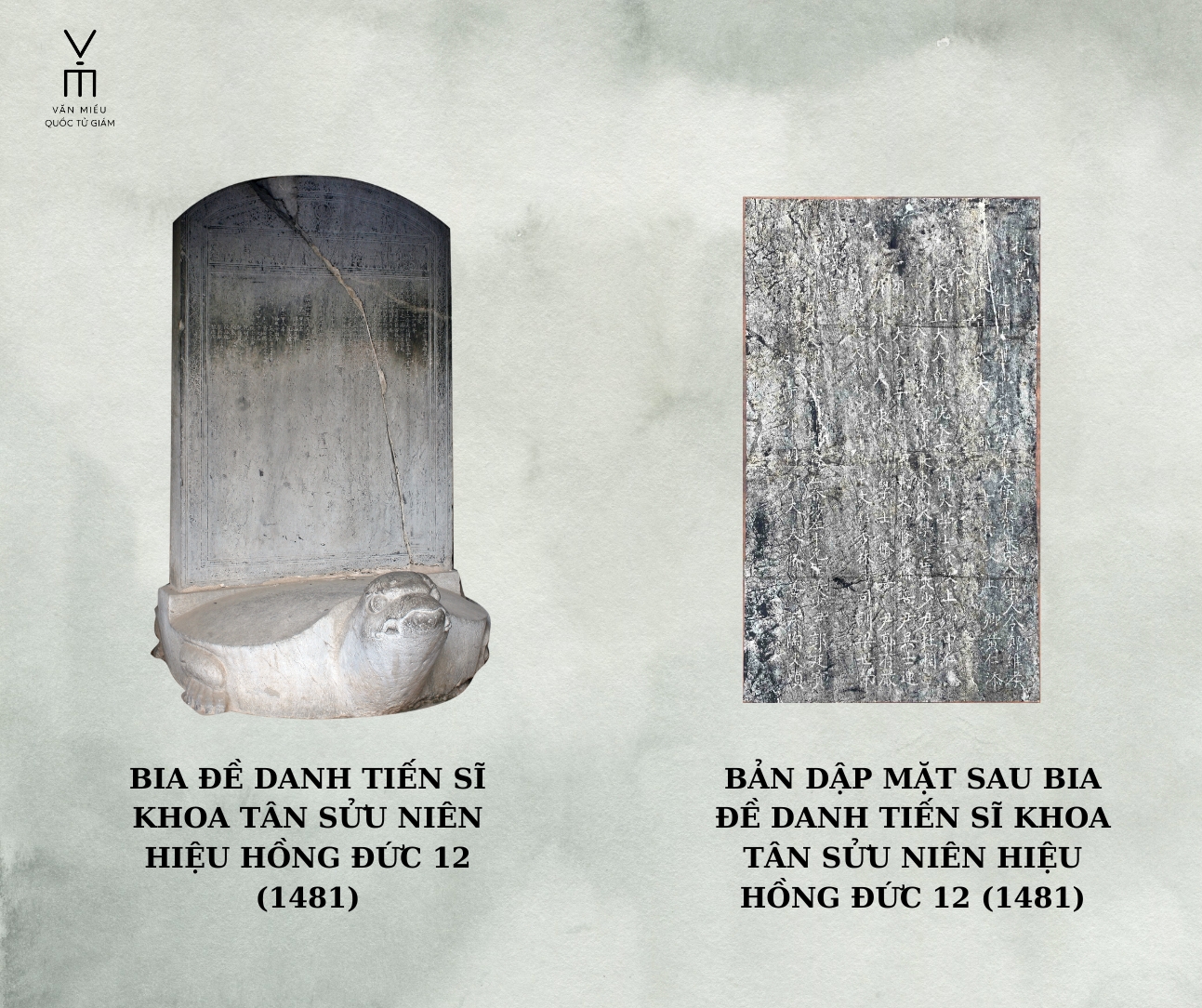
LH
DOCTORATE STELE OF THE EXAMINATION IN 1466
The Doctorate Stele of the Bính Tuất examination in the 7th year of the Quang Thuận era (1466) was erected in the first stele-erecting event in 1484.
The 1466 examination had up to 1,100 participants, but the court selected only 27. Academician Đỗ Nhuận was one of the successful candidates in this examination.
Through the text on the stele, it is evident that the dynasty highly valued talented individuals and emphasized the moral responsibility of those who passed the exam: "So the people whose names were engraved on the stelae should be moved to gratitude and have the dignity to repay the Emperor. The candidates must keep their heads held high and remain loyal, they must study harder in order to be well-known one day. Thus do we wait for talented men of outstanding merit to appear, with sufficient knowledge and virtue to help the country."
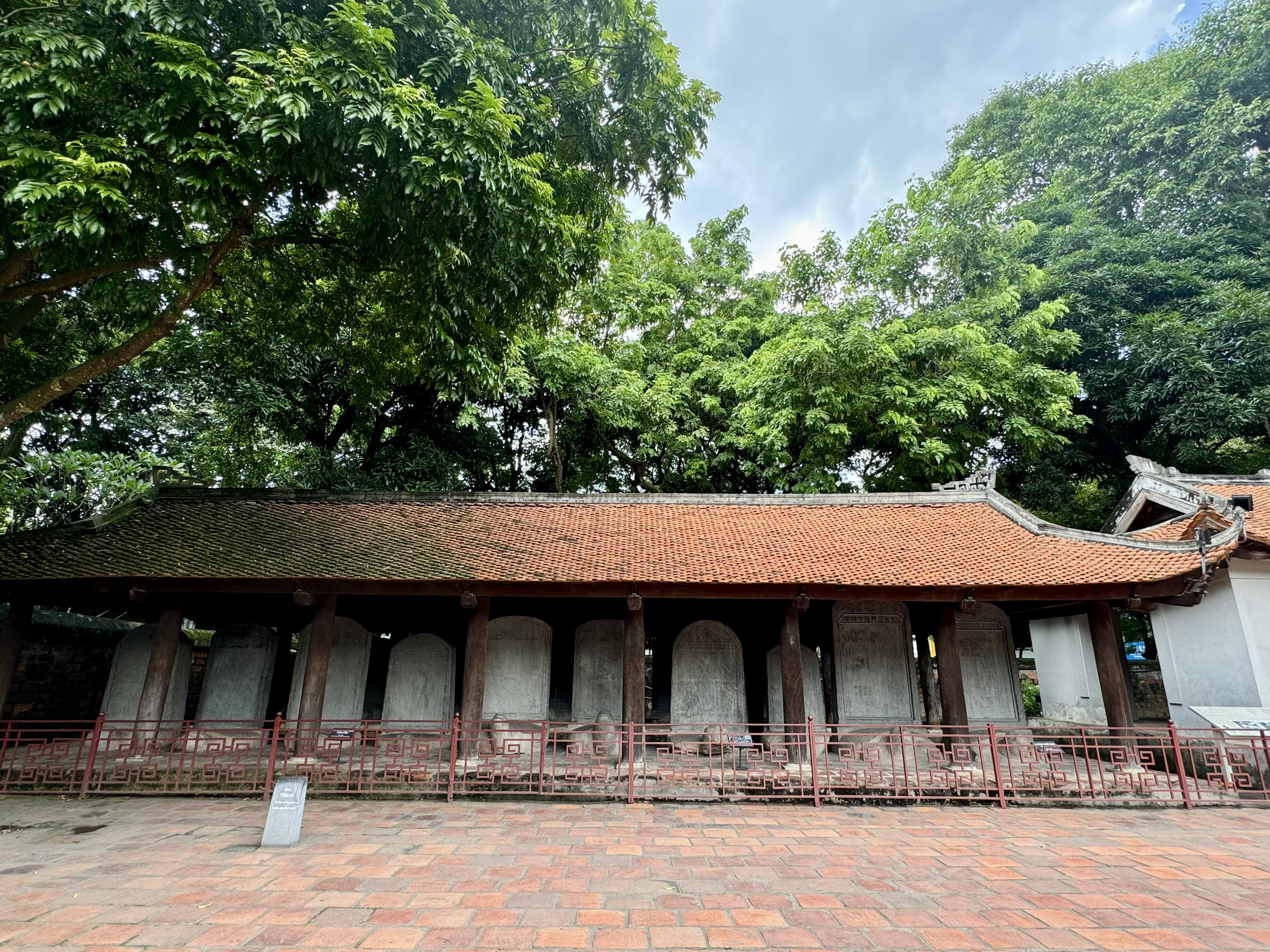
LH
BIA GHI DANH TRẠNG NGUYÊN LƯƠNG THẾ VINH
Bia Tiến sĩ khoa Quí Mùi niên hiệu Quang Thuận 4 (1463) là một trong mười tấm bia đầu tiên được dựng trong đợt dựng bia năm 1484 dưới triều vua Lê Thánh Tông.
Bia có hình dáng dẹt, màu ghi đá, có chiều cao 152cm, chiều rộng 119cm, bề dày 17cm. Trán bia hình khung vòm có trang trí mây thiêng hình khánh ngọc. Mây thiêng vốn là một biểu tượng của Đạo giáo. Sự xuất hiện hình mây hình khánh nằm ở trung tâm trán bia cho thấy phần nào mức độ ảnh hưởng của Đạo giáo với bia Tiến sĩ. Ngay phía dưới trán bia là hàng chữ ngang khắc niên đại tổ chức khoa thi Quang Thuận tứ niên Quý Mùi khoa tiến sĩ đề danh kí theo lối chữ triện. Thân bia có hình chữ nhật đặt trên lưng rùa. Đế bia hình rùa có tạo hình tinh tế trong sự đơn giản với mai trơn nhẵn, sống lưng có gờ nhỏ, chân rùa có 5 ngón.
Khoa thi này có tới 1.400 thí sinh, lấy đỗ 44 người. Ngày 16 tháng 2, vua Lê Thánh Tông ngự ở hiên điện, đích thân hỏi về đạo trị nước của các bậc đế vương, sai Đề điệu là Kiểm hiệu tư đồ Bình chương sự kiêm Đô đốc bình chương sự Đông đạo chư vệ quân Nguyễn Lỗi và Quốc Tử Giám Tế tửu Lê Niệm. Độc quyển là các ông Tả ty môn hạ sảnh Tả gián nghị đại phu Tri Bắc đạo quân dân bạ tịch sảnh kiêm Hàn lâm viện Thừa chỉ học sĩ Nguyễn Như Đổ; Hàn lâm viện thừa chỉ học sĩ Tri Đông đạo quân dân bạ tịch Nguyễn Vĩnh Tích; Quốc Tử Giám Tế tửu Nguyễn Bá Ký. Cử Chính sự viện Tham nghị chính sự Nguyễn Phục làm Giám thí.
Sau khi dâng quyển lên đọc, đích thân Hoàng thượng xem xét và định thứ bậc cao thấp. Đỗ đầu là Trạng nguyên Lương Thế Vinh (người làng Cao Hương, huyện Thiên Bản, Nam định), từ nhỏ đã nổi tiếng thông minh, học giỏi, được coi là thần đồng toán học. Ông làm quan đến chức Thị thư viện Hàn Lâm, có nhiều cống hiến trong các lĩnh vực chính trị, ngoại giao và giáo dục. Tác phẩm nổi tiếng “Đại thành toán pháp” gắn liền với tên tuổi của Trạng nguyên Lương Thế Vinh.
Đỗ Bảng nhãn là Nguyễn Đức Trinh – người huyện Thanh Lâm, phủ Nam Sách. Đặc biệt, đỗ Thám hoa trong khoa thi này là Quách Đình Bảo – người xã Phúc Khê, huyện Thanh Quan, Thái Bình. Ông làm quan đến chức Thượng thư Bộ Hình và đã từng sang sứ nhà Minh. Thám hoa Quách Đình Bảolà một trong mười tám vị minh quân phò tá có công lao lớn thời Lê Sơ, là một trong những danh thần được vua Lê Thánh Tông giao cho việc phụ trách việc dựng bia Tiến sĩ năm 1484.
Ngoài ra, trong 44 vị Tiến sĩ đỗ khoa thi này còn có Tiến sĩ Vũ Hữu – người huyện Đường An, phủ Thượng Hồng, Hải Dương. Ông có tác phẩm nổi bật để lại cho hậu thế là “Lập thành toán pháp”. Trong danh sách các vị đỗ đệ tam giáp đồng Tiến sĩ xuất thân còn có hai vị Tiến sĩ đã từng giữ chức Quốc Tử Giám Tư nghiệp là: Tiến sĩ Hoàng Bồi và Tiến sĩ Nguyễn Văn Chính.
Qua bài kí trên bia đã gửi gắm lời khuyên răn đối với những người đỗ đạt: “kẻ sĩ may mắn được ghi danh vào tấm đá này, phải làm cho danh đúng với thực, sửa nết giữ mình”. Hay sự trọng đãi của nhà vua với các vị tân khoa tiến sĩ: “Ngày 22 tháng hai, nhà vua ngự điện Kính Thiên, cho gọi loa xướng tên người thi đỗ. Quan bộ Lễ rước bảng vàng treo ngoài cửa Đông Hoa. Nhà vua còn ban áo mũ, yến tiệc để tỏ ý yêu mến đặc biệt, ơn sủng thật trọng hậu đối với các các nhà khoa bảng”.
Người được giao nhiệm vụ soạn bài văn bia là Đông các hiệu thư Đào Cử, viết chữ là Nguyễn Tủng và viết chữ triện là Tô Ngại.
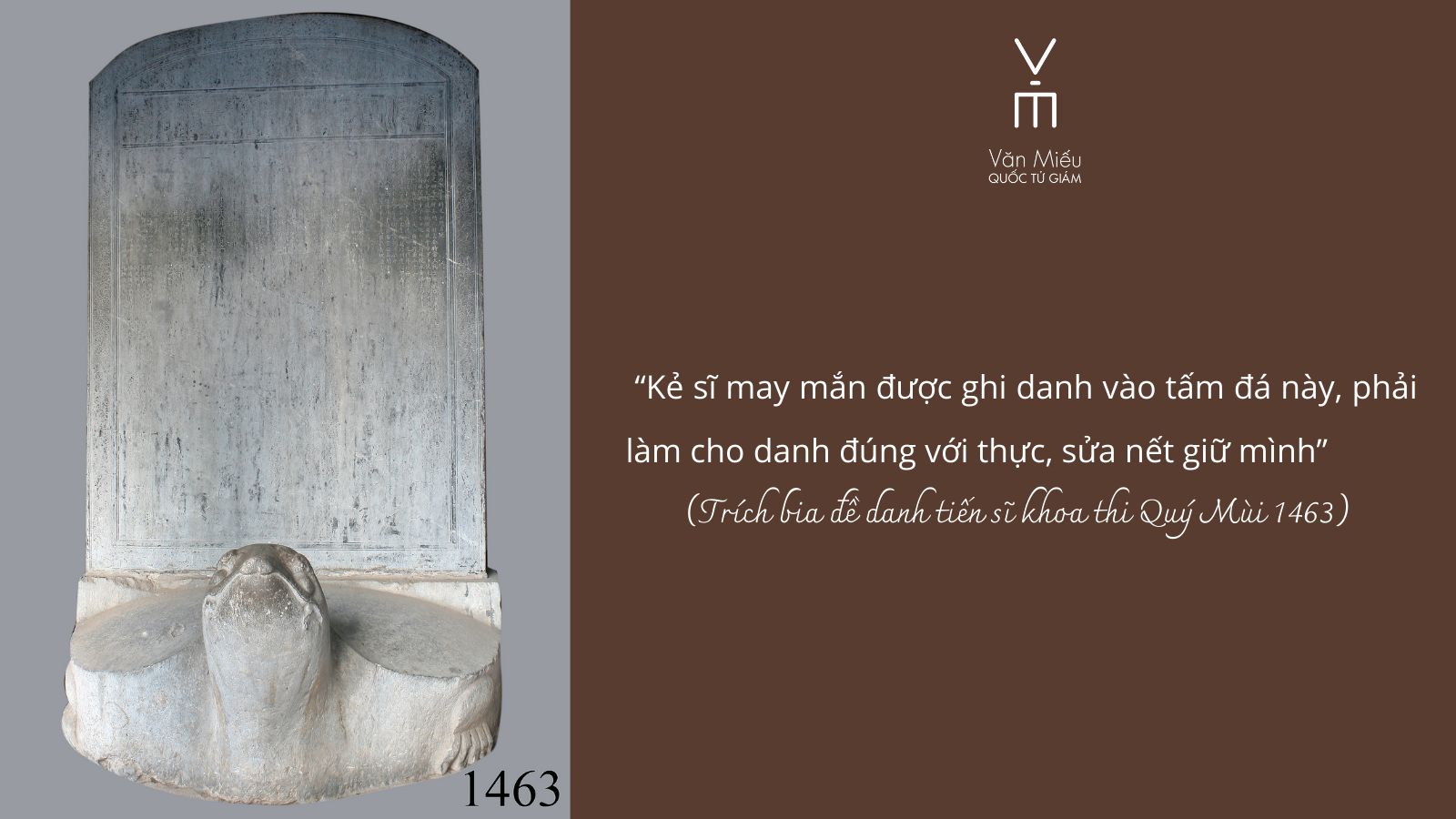
An Nhiên
LỜI RĂN DẠY NGƯỜI ĐỖ ĐẠT TRÊN BIA ĐỀ DANH TIẾN SĨ KHOA THI 1448
Bia Tiến sĩ khoa thi Mậu Thìn niên hiệu Thái Hòa 6 (1448) là tấm bia tiến sĩ thứ hai được dựng tại Văn Miếu – Quốc Tử Giám Thăng Long dưới triều vua Lê Thánh Tông. Bia được đặt dưới tòa đình bia phía tây trong khu vườn bia tiến sĩ.
Bia có hình dáng dẹt, màu ghi đá, có chiều cao 153cm, chiều rộng 111cm, bề dày 19cm. Trán bia trang trí mây vờn ngọc báu, cây thiêng, cỏ lạ (kim ngân). Diềm bia hoa dây thảo Đường. Ngay phía dưới trán bia là hàng chữ ngang khắc niên đại tổ chức khoa thi Thái Hòa lục niên Mậu Thìn khoa tiến sĩ đề danh kí theo lối chữ triện. Đế bia hình rùa có tạo hình tinh tế trong sự đơn giản với đầu tròn, mai trơn nhẵn.
Khoa thi này có tới hơn 750 thí sinh, lấy đỗ 27 người. Ngày 23 tháng 8, vua Lê Nhân Tông đích thân ra đề văn sách. Sai Đặc tiến Nhập nội Tư khấu Đồng Bình chương sự Trịnh Khắc Phục làm Đề điệu, Ngự sử trung Thừa Ngự sử đài Hà Lật làm Giám thí, Môn hạ sảnh Tả ty Tả nạp ngôn Tri Bắc đạo quân dân bạ tịch Nguyễn Mộng Tuân, Hàn lâm viện Thừa chỉ Học sĩ Trình Thuấn Du, Quốc Tử Giám Tế tửu Nguyễn Tử Tấn làm Độc quyển.
Sau khi dâng quyển lên đọc, đích thân Hoàng thượng xem xét và định thứ bậc cao thấp. Đỗ đầu là Trạng nguyên Nguyễn Nghiêu Tư người thôn Phù Lương xã Phù Lương huyện Quế Võ tỉnh Bắc Ninh. Sau khi thi đỗ ông được bổ chức Hàn Lâm trực học sĩ, rồi đổi làm An phủ sứ lộ Tân Hưng. Lê Nghi Dân tiếm ngôi, triều đình cử ông làm Phó sứ sang nhà Minh cầuphong (1-1460), sau thăng đến chức Thượng thư chưỏng lục bộ.
Đỗ Bảng nhãn là Trịnh Thiết Trường người thôn Đông xã Hạnh Phúc huyện Thọ Xuân tỉnh Thanh Hoá. Khoa thi năm Nhâm Tuất niên hiệu Đại Bảo 3 (1442) ông cùng hoc trò là Nguyễn Nguyên Chân trước khi đi thi đã quyết chí phải đỗ Cập đệ (hàng Tam khôi: Trạng nguyên, Bảng nhãn, Thám hoa) nhưng khi yết bảng thấy chỉ đỗ Đệ tam giáp đồng Tiến sĩ nên không nhận, xin được thi lại. Khoa 1448 đi thi lại, Thiết Trường quả nhiên đỗ Bảng nhãn. Đỗ Thám hoa trong khoa thi này là Chu Thiêm Uy người thôn Phương Quất, xã Kỳ Sơn, huyện Tứ Kỳ, tỉnh Hải Dương, làm quan đến chức An phủ sứ lộ Tân Hưng Hạ.
Qua bài kí trên bia cho thấy lời khuyên răn, nhắc nhở với những người đỗ đạt: “những người hiện đương tại chức, hãy nên nhớ lại ơn lựa chọn của tiên triều, ngẫm tới sự hiển đạt của mình ngày nay, tiết muộn đường dài, hãy thận trọng để khỏi hổ thẹn”.
Người được giao nhiệm vụ soạn bài văn bia là Hàn lâm viện Thị độc kiêm Đông các Đại học sĩ Đỗ Nhuận, viết chữ là Nguyễn Tủng và viết chữ triện là Tô Ngại.

An Nhiên
CÙNG TÌM HIỂU TẤM BIA TIẾN SĨ KHOA THI 1475
Bia Tiến sĩ khoa thi Ất Mùi niên hiệu Hồng Đức 6 (1475) là một trong mười tấm bia tiến sĩ đầu tiên được dựng tại Văn Miếu – Quốc Tử Giám vào năm 1484 dưới triều vua Lê Thánh Tông.
Bia có hình dáng dẹt, màu ghi đá, có chiều cao 154 cm, chiều rộng 119 cm, bề dày 18 cm. Diềm bia trang trí hoa dây thảo Đường. Ngay phía dưới trán bia là hàng chữ ngang khắc niên đại tổ chức khoa thi Hồng Đức lục niên Ất Mùi khoa tiến sĩ đề danh kí theo lối chữ triện. Đế bia hình rùa có tạo hình tinh tế trong sự đơn giản với đầu tròn, mai trơn nhẵn.
Khoa thi này có tới hơn 3.000 thí sinh, lấy đỗ 43 người. Đến ngày 11 tháng 5, nhà vua “ngự điện Kính Thiên, thân ra đề văn sách, hỏi về đạo vua tôi ngày xưa để chọn thứ bậc”. Đây là khoa thi thứ năm được tổ chức thời vua Lê Thánh Tông. Sau kỳ Điện thí, nhà vua chọn đủ Tam khôi: Trạng nguyên là Vũ Tuấn Chiêu 49 tuổi, ông người huyện Quảng Đức, phủ Phụng Thiên (nay thuộc phường Nhật Tân, quận Tây Hồ. Nguyên quán xã Cổ Lôi, huyện Tây Chân, nay là thôn Xuân Lôi, xã Nam Hùng, huyện Nam Trực, tỉnh Nam Định). Vũ Tuấn Chiêu sau làm quan đến chức Lại bộ Tả thị lang. Hiện nay, tại xã Nam Hùng, huyện Nam Trực còn đền thờ ông. Đậu Bảng nhãn là Ông Nghĩa Đạt, người xã Phú Gia, huyện Từ Liêm, nay là thôn Phú Gia, phường Phú Thượng, quận Tây Hồ. Ông làm quan đến chức Phó Đô ngự sử, từng đi sứ nhà Minh. Thám hoa là Cao Nghĩa, 37 tuổi, người xã Cao Xá, huyện Đông Thành, nay là xã Diễn Thành huyện Diễn Châu tỉnh Nghệ An. Ông làm đến chức Đông các đại học sĩ.
Đỗ hàng Đệ nhị giáp Tiến sĩ xuất thân có 13 người. Đáng chú ý có Tiến sĩ Nguyễn Kim, người tỉnh Bắc Ninh, từng giữ chức Tư nghiệp Quốc Tử Giám. Đỗ hàng Đệ tam giáp đồng Tiến sĩ xuất thân có 27 người, trong đó Tiến sĩ Nguyễn Lê Kính, người tỉnh Bắc Giang từng giữ chức Tư nghiệp Quốc Tử Giám.
Bài văn bia do Đông các hiệu thư Lê Tuấn Ngạn - Tiến sĩ khoa Nhâm Thìn, niên hiệu Hồng Đức 3 (năm 1472) soạn. Nội dung cho thấy, việc giáo dục đào tạo nhân tài rất được chú trọng dưới thời vua Lê Thánh Tông: “Hiền tài đối với quốc gia, cũng như nguyên khí con người ta không thể một ngày không có”; “Nhất là việc lập trường học, mở khoa thi, càng để lòng chăm chú hơn”. Văn bia còn nhắc nhở kẻ sĩ, dù là các Tiến sĩ có tên trên bia, hay kẻ sĩ trong thiên hạ về cách sống, cách làm việc, cách cư xử cùng đạo lý, luân thường : “Nay những người thi đỗ đều đã được bổ nhiệm khắp nơi….tất cả đều lo nung nấu lòng ngay, trau dồi tiết lớn, nêu cao thanh danh lừng lẫy, công nghiệp lỗi lạc, ngõ hầu trên không phụ ơn triều đình cất nhắc, dưới không phụ chí khí hoài bão trong đời. Thảng hoặc có kẻ không được như thế, đời sau sẽ có người chỉ vào tên mà bàn tán rằng : người này trung chính, kẻ kia gian tà; người này thanh liêm giữ mình, người kia tham lam mất chức…ắt không tránh khỏi sự khen chê của người đời. Thế thì tấm đá này dựng lên không chỉ để nêu thanh danh và lưu tiếng tốt, khiến cho người thi đỗ được vẻ vang nhất thời mà thôi đâu, mà thâm ý khuyên răn thực gửi vào trong đó”.
Văn bia còn cho ta biết tên và chức vụ, trách nhiệm các quan chịu trách nhiệm về khoa khi này như: Quan Đề điệu là Thượng tướng quân phò mã đô uý Đông quân đô đốc phủ tả đô đốc Đoan Vũ bá Trịnh Công Lộ và Lại bộ thượng thư Hoàng Nhân Thiệm; quan Độc quyển là Triều liệt đại phu Hàn lâm viện thị độc kiêm Đông các học sĩ Thân Nhân Trung, Đông các hiệu thư Đỗ Nhuận, Đông các hiệu thư Quách Đình Bảo; quan Giám thí là Thái tử thiếu bảo Ngự sử đài đô ngự sử Trần Phong và Binh khoa đô cấp sự trung Phí Bá Khang.
Phần cuối văn bia còn khắc họ tên người viết chữ, người khắc bia. Bia khoa thi này do Trung thư giám chính tự Thái Thúc Liêm viết chữ, và Mậu lâm lang kim quang môn đãi chiếu Tô Ngại, người viết chữ Triện. Với bàn tay khéo léo, tài hoa của mình, họ đã để lại cho đời sau một tác phẩm nghệ thuật độc đáo, là nguồn sử liệu quý giá về nền giáo dục khoa cử Việt Nam thời quân chủ.

DANH SÁCH TIẾN SĨ KHOA THI NĂM ẤT MÙI NIÊN HIỆU HỒNG ĐỨC THỨ 6 (1475)
Đệ nhất giáp Tiến sĩ cập đệ, 3 người:
|
VŨ TUẤN CHIÊU |
huyện Quảng Đức phủ Phụng Thiên |
|
ÔNG NGHĨA ĐẠT |
huyện Từ Liêm phủ Quốc Oai |
|
CAO QUÝNH |
huyện Đông Thành phủ Diễn Châu |
Đệ nhị giáp Tiến sĩ xuất thân, 13 người:
|
PHẠM XÁN |
huyện Đường An phủ Thượng Hồng |
|
TRẦN THÂM |
huyện Thiện Tài phủ Thuận An |
|
ỨNG NGẠN LƯỢNG |
huyện Thượng Phúc phủ Thường Tín |
|
VƯƠNG HIỂN |
huyện Thanh Lâm phủ Nam Sách |
|
NGUYỄN TẤN VĨ |
huyện Cẩm Giàng phủ Thượng Hồng |
|
LÊ QUẢNG DU |
huyện Lôi Dương phủ Thiệu Thiên |
|
PHẠM HƯNG VĂN |
huyện Thanh Lan phủ Tân Hưng |
|
ĐỖ TRÍ TRUNG |
huyện Từ Liêm phủ Quốc Oai |
|
KIỀU PHÚ |
huyện Ninh Sơn phủ Quốc Oai |
|
NGUYỄN KIM |
huyện Tiên Du phủ Từ Sơn |
|
ĐỖ TUYỀN |
huyện Phụ Dực phủ Thái Bình |
|
VŨ MẪN TRÍ |
huyện Kim Thành phủ Kinh Môn |
|
NGUYỄN TUẤN |
huyện Đông Yên phủ Khoái Châu |
Đệ tam giáp đồng Tiến sĩ xuất thân, 27 người:
|
ĐỖ VINH |
huyện Trường Tân phủ Hạ Hồng |
|
PHAN PHÚC CẨN |
huyện La Giang phủ Đức Quang |
|
NGUYỄN DUY TIẾU |
huyện Vĩnh Lại phủ Hạ Hồng |
|
NGUYỄN ẤU MIỄN |
huyện Quế Dương phủ Từ Sơn |
|
NGUYỄN QUAN HIỀN |
huyện Từ Liêm phủ Quốc Oai |
|
HOÀNG THIỆU |
huyện Từ Liêm phủ Quốc Oai |
|
ĐỖ TƯƠNG |
huyện Ngọc Sơn phủ Tĩnh Ninh |
|
NGUYỄN MINH KHANG |
huyện Ngự Thiên phủ Tân Hưng |
|
NGUYỄN TRINH |
huyện Lập Thạch phủ Tam Đới |
|
VŨ TRIỆU DUNG |
huyện Phụ Dực phủ Thái Bình |
|
NGUYỄN CUNG |
huyện Bình Hà phủ Nam Sách |
|
NGUYỄN ĐẠC |
huyện Vũ Ninh phủ Từ Sơn |
|
NGUYỄN TĨNH |
huyện Kim Hoa phủ Bắc Giang |
|
PHAN QUÝ |
huyện Siêu Loại phủ Thuận An |
|
THÁI THUẬN |
huyện Siêu Loại phủ Thuận An |
|
NGUYỄN SÙNG NGHÊ |
huyện Vĩnh Xương phủ Phụng Thiên |
|
TRẦN MÔ |
huyện Đan Phượng phủ Quốc Oai |
|
ĐOÀN MẬU |
huyện An Lão phủ Kinh Môn |
|
NGUYỄN LI CHÂU |
huyện Yên Lãng phủ Tam Đới |
|
NGUYỄN LỄ KÍNH |
huyện Yên Dũng phủ Lạng Giang |
|
TẠ ĐỨC HẢI |
huyện Vũ Ninh phủ Từ Sơn |
|
TẠ THÔNG |
huyện Sùng Yên phủ An Bình |
|
NGUYỄN DƯƠNG HIẾN |
huyện Kim Hoa phủ Bắc Giang |
|
ĐỖ CHÍNH LẠC |
huyện Đường An phủ Thượng Hồng |
|
NGÔ LUÂN |
huyện Đông Ngàn phủ Từ Sơn |
|
NGUYỄN TƯ PHỤ |
huyện Chí Linh phủ Nam Sách |
|
NGUYỄN TƯ PHÚC |
huyện Lập Thạch phủ Tam Đới |
An Nhiên
EXPLORING THE ENCOURAGEMENT OF LEARNING AND RESPECT FOR TALENT THROUGH THE DOCTORAL STELES OF THE 1442 EXAMINATION
On the stele inscribed with the names of the doctoral laureates from the 1442 examination, there is a commemorative inscription composed by Thân Nhân Trung, the Academician. This inscription provides information about the tradition of valuing education and elevating talented individuals.
Our country's monarchical period saw the early recognition of talent for the country's development, a tradition that began with the Lý Dynasty. This underscores the long-standing tradition of valuing education and talent in Vietnam. Those who passed the exams enjoyed many benefits from the court. To encourage learning and respect for talent, on the fifteenth day of the eighth lunar month of the 15th year of the Hồng Đức era (1484), King Lê Thánh Tông issued a decree to erect doctoral steles at Văn Miếu - Quốc Tử Giám. The first examination to have its laureates' names inscribed was the Nhâm Tuất examination of the Đại Bảo 3rd year (1442) during the reign of King Lê Thái Tông.
The inscription on the stele provides valuable information about the 1442 examination (under King Lê Thái Tông), such as 450 candidates participated in the Hội examination, 33 were selected as doctoral laureates (including three in the top ranks, seven in the second rank, and 23 in the third rank); examiners and judges were all high-ranking officials and renowned scholars such as World Cultural Celebrity Nguyễn Trãi, Minister Lê Văn Linh, Secretariat Chancellor Nguyễn Mộng Tuân, and teacher of Quốc Tử Giám Nguyễn Tử Tấn.
The inscription on the stele reveals the numerous royal favors bestowed upon the doctoral laureates after passing the examination: “His Majesty conferred on them various honorary titles to distinguish them from commoners, bestowed on them ceremonial costumes and headwear to embellish themselves, invited them to a Royal banquet held in the Royal Garden, and granted them horses to carry them back to their homeland. Confucian scholars and the population of the capital city gathered outside the Royal Palace to admire the laureates and lauded His Majesty for his rarely-seen veneration for Confucianism.”
Additionally, the inscription highlights the importance of talent: " Virtuous and talented men are the primordial vitality of a State. If the vitality is strong, the State will be powerful and prosperous. On the contrary, it will weaken and have a low standing. Therefore, clear-sighted monarchs always attach importance to educating talent and selecting Confucian scholars for the Mandarinate, and regard the fostering of the State's primordial vitality as an urgent task. Since Confucian scholars are so important to the nation, they are always held in great esteem; they are honored with titles, distinctions and dignities. Yet, all this is not enough! Their names are made known at Swallow Tower and their dignities are publicized on the Dragon-Tiger Board, not to mention the Royal banquet. The Court does everything possible to glorify the talent it has discovered via Royal exams."
After 560 years, the doctoral steles still stand the test of time, underscoring their enduring significance in commemorating the nation's history and honoring its notable figures. The doctoral laureates whose names are inscribed on these steles were all notable figures who contributed significantly to the nation. First Laureate Nguyễn Trực from Bối Khê village, Thanh Oai district, Ứng Thiên prefecture, who served as Principal of Quốc Tử Giám and was highly respected by the Ming court during his diplomatic missions. The Second Laureate of this examination, Nguyễn Như Đổ from Duyên Hà village, Thanh Trì district, Hanoi, also served as Principal of Quốc Tử Giám. Third Laureate Lương Như Hộc from Hồng Liễu village, Trường Tân district, Hải Dương province (now Thanh Liễu village, Gia Lộc district, Hải Dương province), was the first to teach woodblock printing to the people of his home villages Liễu Tràng and Hồng Lục. Doctoral laureate Ngô Sĩ Liên from Chúc Sơn village, Chương Đức district (now Chương Mỹ district, Hanoi), was a historian who significantly contributed to compiling the 15-volume Đại Việt sử ký toàn thư. He also held the position of Dean of Quốc Tử Giám.
The information inscribed on the doctoral steles of the 1442 examination shows that education and talent cultivation have always been imperative in every era.
LH
THE EXCERPT FROM THE DOCTORAL THESIS STONE INSCRIPTION IN EXAM FIELD 1631
In 1484, King Lê Thánh Tông ordered the carving of stone tablets inscribed with the names of scholars to honor those who passed exams and educated students. This was one of the unique features of the doctoral thesis stone inscriptions placed at Văn Miếu – Quốc Tử Giám in Thăng Long, Hanoi.
The dedication of the scholars to their country when they are valued by the court is highlighted in the inscription of the doctoral thesis in 1631, compiled by Mậu lâm lang Hàn lâm viện hiệu thảo Trịnh Cao Đệ. The inscription: “The Confucians whose names appear on this stone stele should strive for honesty, righteousness and industriousness, ward off greediness and envy, be loyal to His Majesty and benefit the populace. Within the Court, they should be impartial and upright enough to warm against wickedness. Outside the Court, they should carry out proper policies to satisfy the people’s wishes. By doing so, they will not betray the Court’s favor or betray their own aspiration to help His Majesty and to benefit people.”
The meaning of this excerpt shows us the responsibility of scholars towards the nation when they are valued by the court. It emphasizes that they must always have a sense of learning, self-improvement, and dedication to the country, for the people and the nation. This dedication helps individuals transcend their personal ego, selfishness, and greed to strive for greater good. Those who have a sense of responsibility towards their homeland will be individuals with love, compassion, and high self-discipline. They must live up to the trust of the court and the affection of the people.
These inscriptions not only serve as encouragement, motivation, and education for scholars but also educate future generations. The young generation of our nation is continuously absorbing knowledge, refining their intellect, and cultivating virtues to contribute to the prosperity and success of the nation.
Doctoral thesis inscriptions are found in many countries and some localities in Vietnam, but only at Văn Miếu – Quốc Tử Giám in Thăng Long, Hanoi, do we find inscriptions that fully illustrate the responsibilities of scholars towards the nation and the people. These are truly invaluable intangible cultural heritage values that our ancestors have left for generations to come.

AV
TL: LH
THE MOTIF OF “THE BIRDS PERCHED UPON THE APRICOT BRANCHES”, ENGRAVED ON THE STONE STELAE
The motif of the birds perched upon the apricot branches”decorated on the border of the stone stele for exam in 1589 at Văn Miếu – Quốc Tử Giám. According to folk opinion, “the apricot flowers showing their pistils to welcome the good things, the birds perching upon the apricot branches to inform the lucky things. The motif of “the birds perched upon the apricot branches” standing for the good signal.
You could make yourself printing of the motif “the birds perched upon the apricot branches” on the Dó paper at the heritage education for experimentation of Văn Miếu – Quốc Tử Giám.

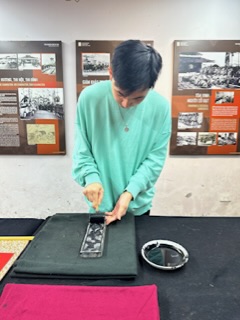
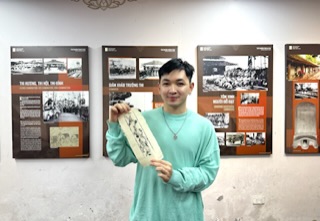
Translator: BP
WHY ARE DOCTORAL STELES AT VĂN MIẾU – QUỐC TỬ GIÁM LISTED IN UNESCO'S MEMORY OF THE WORLD
On the afternoon of March 9, 2010, in Macao, China, during the annual meeting of the Memory of the World Committee for Asia and the Pacific (MOWCAP), the stone steles of doctoral examinations during Lê and Mạc dynasties (1442-1779) at Văn Miếu-Quốc Tử Giám in Hanoi were recognized as world documentary heritage and included in UNESCO's Memory of the World list.
On May 25, 2011, in Manchester, England, UNESCO Director-General Irina Bokova officially approved and added 45 documentary heritages from various countries worldwide, including the doctoral steles at Văn Miếu-Quốc Tử Giám, to the Memory of the World list as recommended by the International Advisory Committee of the UNESCO Memory of the World Programme.

According to UNESCO criteria, for a heritage to be recognized as Memory of the World, it must be documentary, meaning it must be a purposefully created product containing information on a tangible carrier. The material must meet criteria such as authenticity, uniqueness, and especially global significance in a specific field.
The 82 doctoral steles at Văn Miếu-Quốc Tử Giám qualify as documentary heritage because they are records of doctoral examinations on stone, commissioned by Lê and Mạc dynasties from 1484 to 1780. The content of the steles is rich, with the stones serving as the main carriers of information.
The doctoral steles of Vietnam meet all the UNESCO criteria for Memory of the World. They are authentic documents with clear origins, and their historical and artistic aspects make them unique and irreplaceable. The steles provide insights into the introduction and changes of Confucianism in Vietnam, its presence outside China, and its role as the cradle and center of Chinese culture. Thus, they contribute to humanity's understanding of the history of human culture in the 15th to 18th centuries in the Asian region.
The stone steles of doctoral examinations during the Lê and Mạc dynasties at Văn Miếu-Quốc Tử Giám fulfill all criteria, with the most notable being the unique theme of the documents and the social impact of these steles compared to other similar documentary heritages.
The doctoral steles cover various topics, notably in the field of education and the utilization of human talent – products of education. The unique educational philosophies of ancient dynasties, such as "Talented individuals are the nation's vital energy," emphasize that education is not only for students but also a lifelong process even after passing the exams and becoming officials. The inscriptions on the steles often remind successful individuals to live in a way that is "worthy of reality," to be "virtuous and honest," avoiding corruption and bribery. These educational ideas and moral principles are still frequently mentioned not only in regional countries but are also goals for most nations worldwide in the fight against corruption and in the development of their countries.
The significance of the Doctoral Steles extends to a larger societal context. The erection of these steles has encouraged all levels of society to pursue education for self-affirmation, to develop talents, and to become useful individuals, bringing glory to their families, homeland, and country. The Doctoral Steles attract the attention of many people, including scholars and high-ranking politicians in Vietnam and around the world. The inscriptions on the steles consistently provide surprises and fascination for those who seek to understand. Therefore, the Doctoral Steles are invaluable documentary heritages for humanity.
LH
"STORK AND LOTUS FLOWER" - AN ARTISTIC REPRESENTATION OF ASPIRATIONS ACHIEVED ON DOCTORATE STELES
Graduating is a significant milestone marking one's achievement; the first step to open up the path to a successful career for every student. The noble and beautiful aspirations of reaching the pinnacle of academic success are fervently cherished by all generations of students. These aspirations are vividly portrayed on the literary pattern "Stork and Lotus Flower" carving on the doctoral stele at Văn Miếu - Quốc Tử Giám.

The literary pattern "Stork And Lotus Flower" depicts a scene where a group of storks is swimming gracefully in a lotus pond. This project is carved on the edge of the doctorate stele of the Nhâm Tuất royal exam in 1589. It is a form of humorous artwork symbolizing the attainment of academic success and consecutive doctoral degrees.
This is truly a tranquil and beautiful rural painting, brimming with life. It features a scene of storks gracefully swimming in a lotus pond. The storks are intricately carved with various natural poses, with some swimming, some foraging, and others elegantly raising their heads. Every movement is expressed with great subtlety and skill. The lotus flowers in the pond are in full bloom, exuding their fragrant beauty. Some tender buds are gently cradled by the lotus leaves, coiled and intertwined, while others stand tall among delicate and elongated blades of grass. The beauty and subtlety of nature in this carving reflect the masterful craftsmanship and creativity of the stone carver.
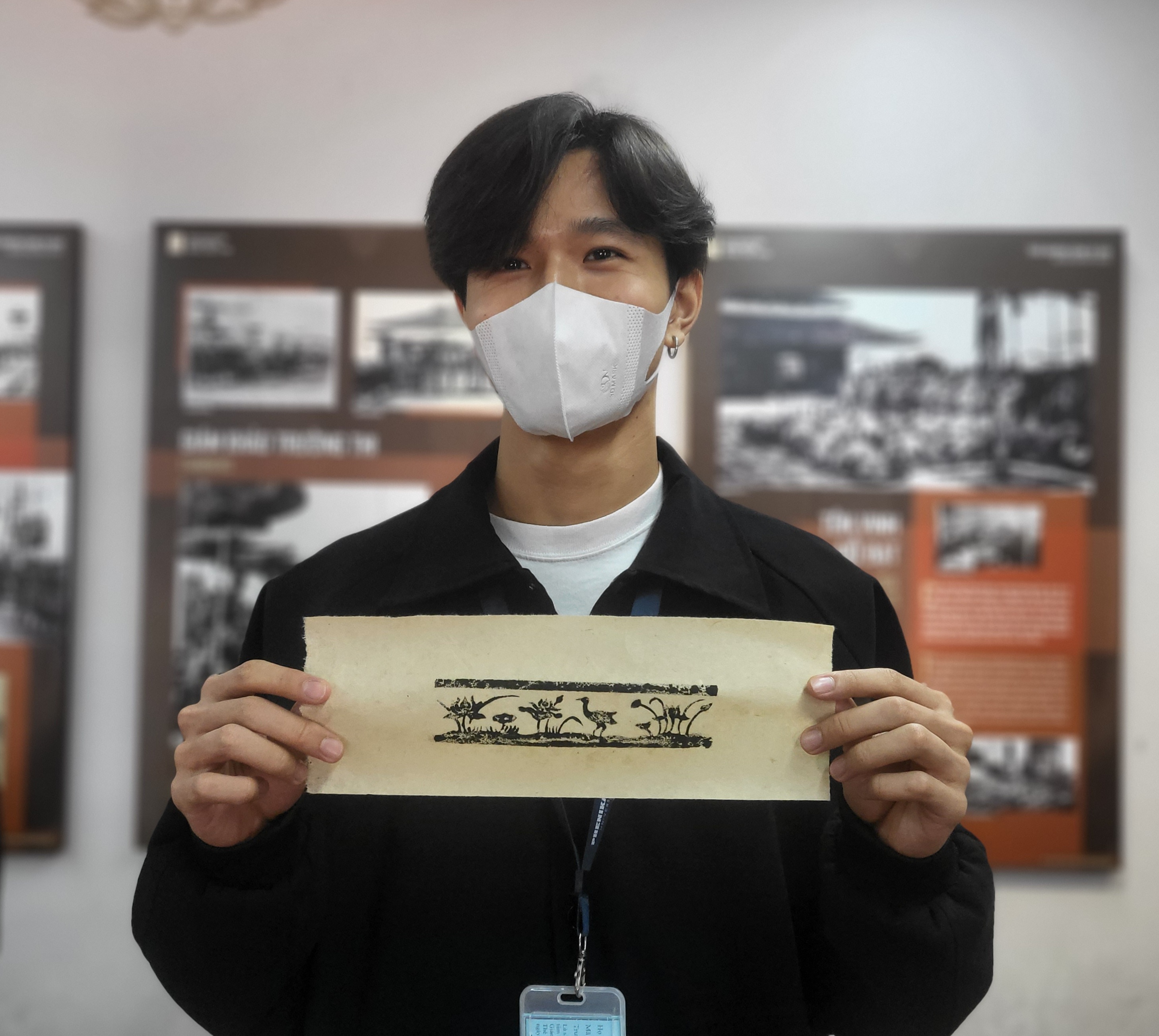
In the past, achieving a doctoral degree and attaining glory and honor were boundless sources of joy for scholars. Graduating with a doctorate marked a significant turning point in the life of every student. After obtaining a doctorate, a bright new chapter would open up, thanks to their diligent and persistent studies. Passing the doctorate examination not only brought personal glory to the candidate but also pride to their family and homeland. The Doctorate steles solemnly record the names of those who passed the exam, and it is a place of tribute to the pursuit of knowledge. The decorative sculptures on the edges and pediment are all outstanding artistic patterns illustrating this theme.
Each decorative theme represents aspirations for success and the collective celebration of the nation. When education flourishes, talents thrive, and knowledge is highly esteemed. They all express a strong spirit of encouragement, inspiration, and support for every student, both in the past and for generations to come.
AV
TL:LH
ROYAL EXAMINATION IN THE YEAR OF THE QUÝ MÙI REIGN ENTITLED: HỒNG THUẬN VI (1514)
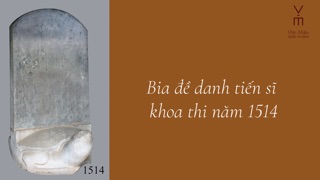
The stone stele records the names of the laureates of the exam held in 1514,
located at the Special National Landmark Văn Miếu - Quốc Tử Giám
The stone stele is 159 cm high, 110 cm wide, and 19 cm thick. The top of the inscription is adorned with decorative cloud motifs. The body of the inscription is decorated with floral patterns and is placed on the back of a tortoise. The tortoise has a rounded head that is raised high, with round, small eyes and a wide mouth, with a ridge running down its center. On the stele pediment is the ancient Chinese character of a seal in the style (Triện) recording the year of the exam: “Records of the Doctoral laureates of the Quý Mùi Royal exam, 6th Hồng Thuận Reign”.
There is also text composed by the eminent scholar Vũ Duệ (1468 - 1522), who passed the doctoral examination in the Canh Tuất year, Hồng Đức 21 (1490). The text imparts wisdom and guidance to those who achieve a doctorate: “For them, loyalty to the Dynasty, devotion to duty and striving for moral perfection must prevail over talent, skill, and literary creativity. They should become ‘auspicious clouds, stars, shining gems and pure gold’ for the nation; “swords and lances” in the combat against rebels; and solid pillars like the trunks of the “kỷ” and “tử” trees. They should become “rice” or “silk” for the poor, or ‘tonics’ for the State - so that our nation can be built on stable foundations like the Thái Sơn mountain, and advance steadily forward. They should not betray His Majesty’s trust. Through their loyalty they can make their causes and fame long-lasting like this stone stele. On the other hand, if any of them turns out to be corrupt or degenerate, he will be regarded like a scratch on a gemstone. The public will criticise such a person severely. So, the tiến sĩ should be cautious about this.”
His Majesty gave different assignments relating to the examination to Duke Lê Phụ (title: Tá lý hiệp mưu kính thận trinh ý công thần Đặc tiến khai phủ kim tử vinh lộc đại phu tả bình chương quân quốc trọng sự nhập nội kiểm hiệu Thượng tướng thái úy Lượng quốc công thượng trụ quốc), Minister of the Mandarinate Đàm Thận Huy (title: Phụng trực đại phụ Lại bộ thượng thư tri chiêu văn quán tú lâm cục tư chính thượng khanh), Vice-Minister of Public Works Lê Tán Tương (title: Gia hạnh đại phu Công bộ hữu thị lang khuông mỹ doãn), Minister of Rites and Rector of the Quốc Tử Giám, Count Lê Tung (title: Đặc tiến kim tử vinh lộc đại phu thiếu bảo Lễ bộ thượng thư đông các đại học sĩ kiêm Quốc Tử Giám Tế tửu tri kinh diên sự Đôn Thư bá trụ quốc), Minister of Rites, Count Nguyễn Bá Thuyên (title: Đặc tiến kim tử vinh lộc đại phu Lễ bộ thượng thư Do Lễ bá trụ quốc), Minister of Finance, Baron Đoàn Mậu (title: Đặc tiến kim tử vinh lộc đại phu Hộ bộ thượng thư tri chiêu văn quán tú lâm cục Cẩn Lễ nam chính trị thượng khanh) and Đỗ Nhạc (title: Quang nghiệp đại phu thượng thư đông các đại học sĩ nhập thi kinh diên chính trị khanh).
Up to 5,700 Confucian scholars took part in the Royal examination (first round) in the year of Giáp Tuất, during the reign of Hồng Thuận VI. After four exams, 43 winners were selected. Thus, Nguyễn Đức Lượng and some other persons became the 1st-class tiến sĩ; Nguyễn Vũ and some other persons; 2nd-class Tiến sĩ xuất thân; Nguyễn Bỉnh Di and some others, 3rd-class Tiến sĩ xuất thân. They were granted honors as stipulated by the established rules. The Ministry of Rites submitted to His Majesty a request to set up a stone stele in their honor at the Thái Học House.
At the end of the inscription, the names and information of the calligraphers are recorded: Composed by the Minister of the Mandarinate Vũ Duệ (title: Trinh ý công thần đặc tiến kim tử vinh lộc đại phu thiếu bảo Lại bộ thượng thư Đông các đại học sĩ nhập thị kinh diên chính trị thượng khanh). Written on the stele by Chu Đình Bảo (title: Trung trinh đại phu Trung thư giám điển thư khuông mỹ thiếu doãn). Engraved by Phạm Đức Nhi (title: Thông chương đại phu kim quang môn đãi chiếu tử chính khanh). The stele was set up on the 17th day of the 4th lunar month of the year of Quang Thiệu VI (1521).
An Nhiên
TL: LH
PROJECT LOTUS FLOWER ON DOCTORAL STELE
The lotus flower is a precious flower, symbolizing noble qualities, purity, and is a familiar symbol in Vietnamese culture. In art, the lotus is frequently used for decoration in various artistic projects, carrying rich symbolism. Perhaps in our daily lives, we have never seen the lotus and chrysanthemum combined, yet this unique combination is featured on the Doctoral Stele.
This is the Lotus Vine Project. The artist has sculpted a lotus flower in full bloom with two lotus leaves embracing a mirror-shaped pedestal in the center, surrounded by 5 - 7 other petals blooming outward. The composition is vividly arranged by alternately placing a lotus flower next to a chrysanthemum (sometimes even combined with other flowers like peonies or money plants). These two types of flowers are connected by vines and leaves, enclosing the four sides of the Doctoral Stele.
The Lotus Vine Project, as depicted by ancient artists, conveys a very high level of craftsmanship. In reality, lotus and chrysanthemum leaves are quite different from those depicted on the project, and these flowers are not climbing plants. This showcases the creativity and skillfulness of the ancient artists.
In reality, the lotus has been incorporated into art from a very early stage, becoming a traditional art form and decoration in our culture. In Eastern culture, the lotus is also considered a symbol of Buddhism. In our country, since the Lý Dynasty, Buddhism has been considered the state religion, so the lotus theme has been extensively used in various Buddhist-related constructions (Buddha statues, temple pillars, stele decorations, pagodas, etc.).
Later, during the early Lê Dynasty, despite the limitations placed on Buddhism and the rise of Confucianism, the lotus continued to be a popular theme and was used for decoration on Doctoral Steles. Some artists even creatively combined two symbolic flowers representing two streams of thought on a single art project: the lotus representing Buddhism and the chrysanthemum representing Confucianism. This seemed to express the harmony between Confucianism and Buddhism in contemporary society. All of this embodies the timeless aesthetic value of the lotus flower that has deeply permeated the souls of the Vietnamese people.
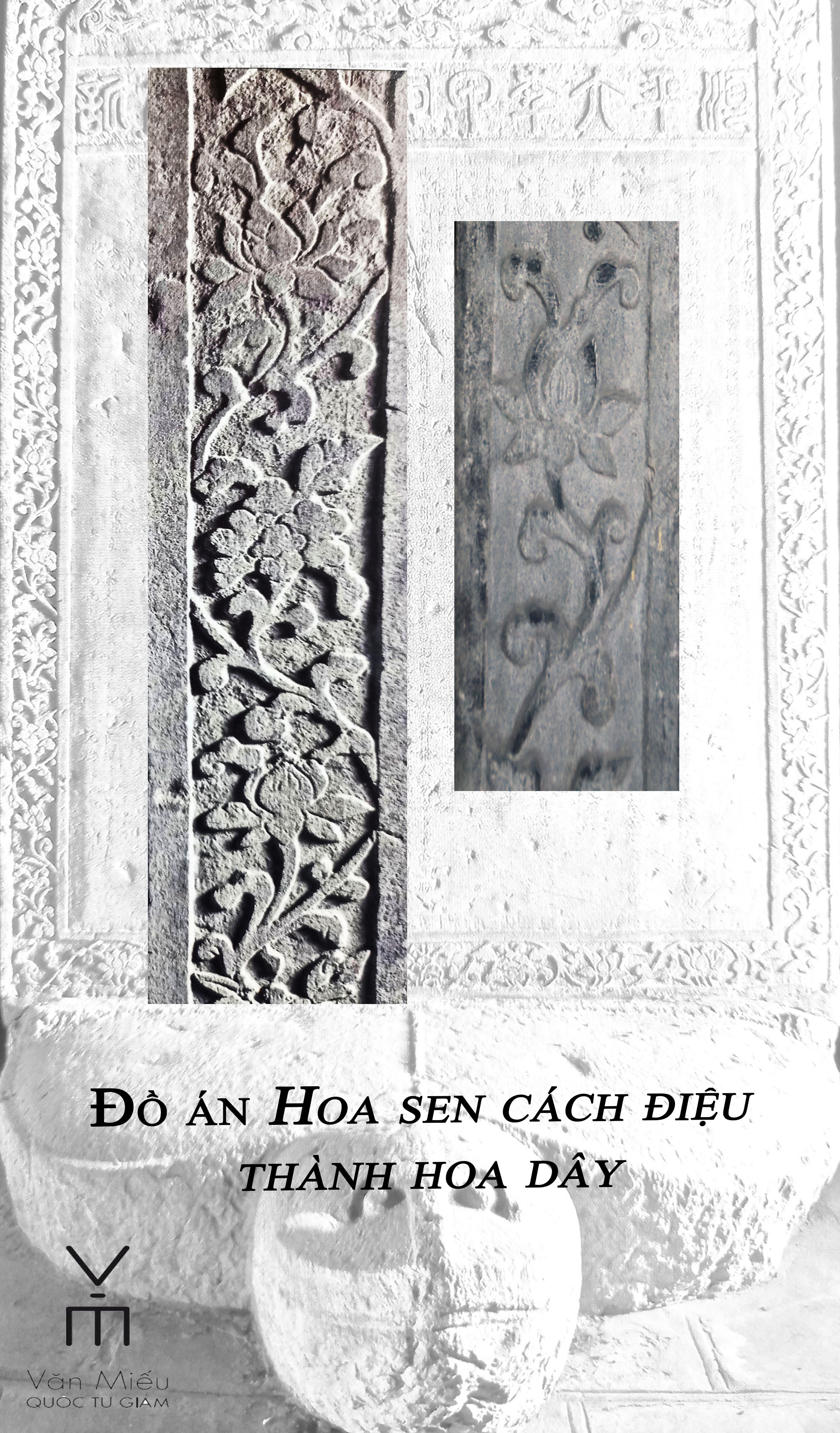
AV
TL; LH
WHY DO THE DOCTORAL STELE TORTOISES AT VĂN MIẾU -QUỐC TỬ GIÁM HAVE DIFFERENT SHAPES?
Currently, at Văn Miếu -Quốc Tử Giám, there are 82 Doctoral Stele, and each one is placed on the back of a tortoise. However, the shapes of the tortoies are not the same, my friends. Do you know why?
That's because these Doctoral Stele were erected over a long period of nearly 300 years (from 1484 to 1780), so depending on the sculptural style of each era, the tortoises have different shapes. In general, the shapes of the tortoises can be divided into 3 categories according to the era of the Stele's construction as follows:
The first category included steles erected from 1484 (15th year of Hồng Đức reign title) to 1536 (7th year of Đại Chính reign title). The tortoises (the sole of stele) were carved with round, smooth shape, the carvings look fine and precisely. The sole is in short, flat semicircular shape.
The secaond category including steles setup in 1653 ( first year of Thịnh Đức reign title). The tortoises (the sole) were made with square blocks, the carving are straight and simple, the neck of tortoise are short, the heads is up or transverse, the mouth is widely open, the leg were carved simply.
The third category including steles set up from 1717 (third year of Vĩnh Thịnh reign title) to 1780 (41st year of Cảnh Hưng reign title). The tortoises are crafted very similarly to real tortoises: short necks, with a ridged edge on the back, a large nose, round and small eyes. The turtle shell is curved, with an engraved pattern resembling a hexagon.
The first category
The 2nd category
The third categoryo
An Nhiên
TL: LH
THE STONEMASONS HONORED ON DOCTORAL STELES AT VĂN MIẾU – QUỐC TỬ GIÁM
Among the 82 doctoral steles at Văn Miếu – Quốc Tử Giám, in addition to the names of eminent scholars, there are also the identities of high-ranking officials in the court, the names of the individuals who composed the inscriptions on the steles, wrote the characters, engraved the words, and erected the steles. Of particular interest, five individuals are recognized with the title 'Stonemason'.
The first person is Phạm Thọ Ích from Kiêu Kỵ village, Gia Lâm district. His name is inscribed on the doctoral stele of the Giáp Thìn examination, in the 5th year of Bảo Thái (1724). On this stele, he refers to himself as a stonemason.
In the doctoral examination Đinh Mùi, in the 8th year of Bảo Thái (1727), Phạm Thọ Ích was again the inscriber. This time, he carved his own name on the stele, stating, "Phạm Thọ Ích from Kiêu Kỵ village, Gia Lâm district, respectfully carved the characters."
The second individual is Hoàng Quang Trạch, who engraved the doctoral stele for the Quý Sửu examination, in the 2nd year of Long Đức (1733). In the final section of the stele's inscription, he clearly carved his identity, "Hoàng Quang Trạch, the village chief of Gia Đức, Thuỷ Đường district, respectfully carved the characters."
Lê Nguyễn Diệu, from An Hoạch hamlet, Đông Sơn district, is honored on two doctoral steles: one for the Kỷ Mùi examination, in the 5th year of Vĩnh Hựu (1739), and another for the Quý Hợi examination, in the 4th year of Cảnh Hưng (1743). Both steles state, "Lê Nguyễn Diệu from An Hoạch hamlet, Đông Sơn district, respectfully carved the characters."
The fourth person is "Bá hộ Lê Khắc Thực and his entire team of stone gatherers, respectfully carved the characters," honored on the doctoral stele for the Bính Dần examination, in the 7th year of Cảnh Hưng (1746).
The last stonemason mentioned is Lê Văn Lộc, a stone carver from Nhuệ hamlet, An Hoạch commune, Đông Sơn district, recognized on the doctoral stele for the Quý Mùi examination, in the 24th year of Cảnh Hưng (1763). At the end of the stele's inscription, it states, "Lê Văn Lộc, stone carver from Nhuệ hamlet, An Hoạch commune, Đông Sơn district, obediently carved the characters." Lê Văn Lộc is the second case recorded on a doctoral stele with the title of 'stone carver' (following Phạm Thọ Ích), and this title is officially inscribed in the main body of the stele.
Certainly, the creation of the 82 stone steles at Văn Miếu – Quốc Tử Giám was the labor of many generations of talented stonemasons. Among these doctoral steles, only five stonemasons with their inscribed names are indeed a few and rare. This might be due to the hierarchical distinctions of the feudal regime, where the status of stonemasons remained in the lower ranks of society. However, by inscribing their identities on a few stone steles out of the total 82 at Văn Miếu – Quốc Tử Giám, their position in the historical hierarchy of Scholars - Farmers - Artisans - Merchants is somewhat affirmed.
Even though their names might not be fully recorded on the doctoral steles, no one can deny the significant contributions they have made to society. These skilled stonemasons are the ones who silently crafted the invaluable 'Cultural Heritage' - the irreplaceable doctoral steles of the nation. The present generations of Vietnam always remember them with gratitude and respect.
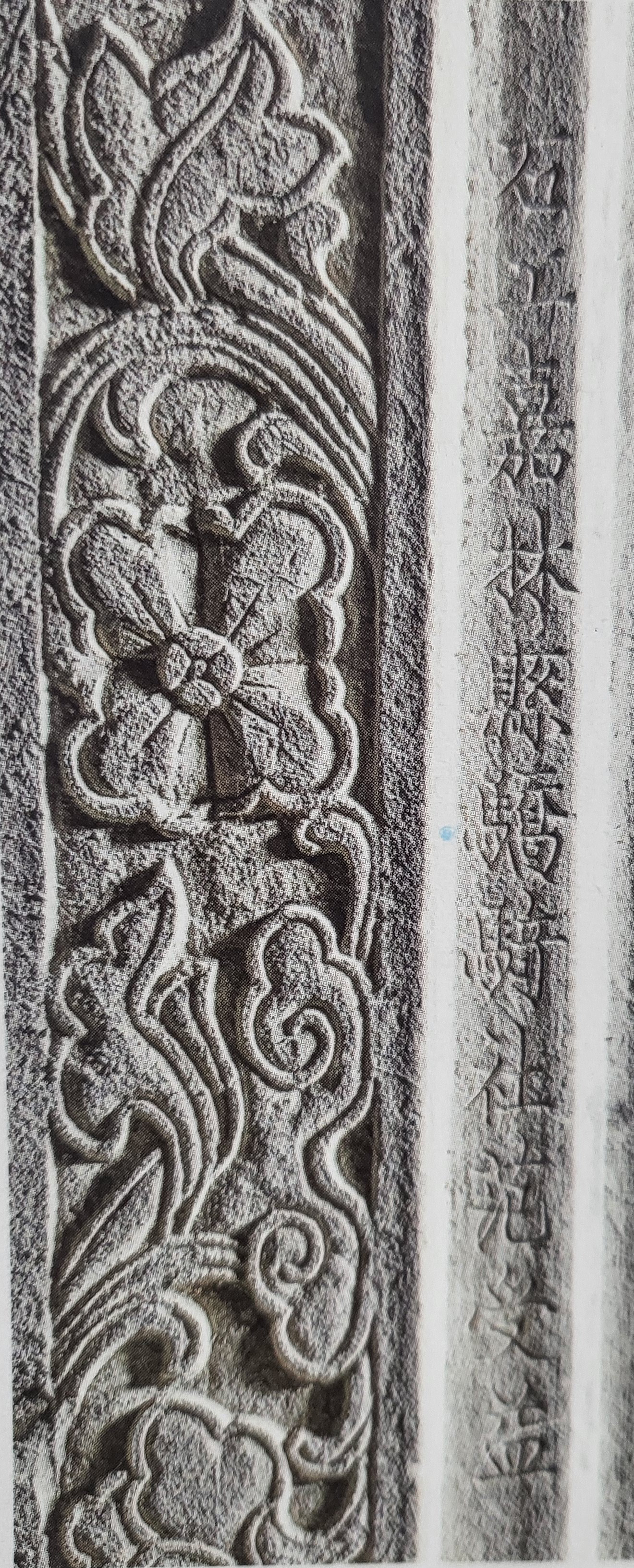
The rim of the doctoral stele from 1724 engraved with the name of Phạm Thọ Ích.

Two doctoral steles from 1743 and 1739, bearing the name of the inscriber Lê Nguyễn Diệu, from An Hoạch hamlet, Đông Sơn district."
TL: LH
STELE RECORDS OF DOCTORAL LAUREATES OF ROYAL EXAM IN THE YEAR OF ẤT MÙI REIGN TITLE: VĨNH THỊNH XI (1715).
The doctoral stele of Royal exam in the year of Ất Mùi Reign title: Vĩnh Thịnh XI (1715) was erected in the spring of March 1717.
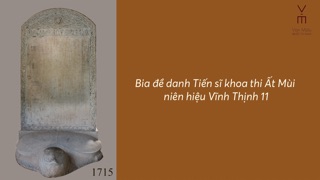
The stele is large, with a height of 184 cm, a width of 114 cm, and a thickness of 20 cm. The stele pediment is adorned with a pair of dragons coiling around clouds and embracing the sun and moon. The body of the stele is decorated with a combination of precious flowers. The tortoise has a round head, short neck, small eyes, wide mouth, no sharp teeth, a curved back, and its legs extend outward with five toes. The upper part of the stele is engraved with the following inscription in the classical Chinese script style: "Royal exam in the year of Ất Mùi Reign title: Vĩnh Thịnh XI (1715)"
On the stele, the text is written in classical Chinese by the scholar Bùi Sĩ Tiêm, who was a member of the Academy, and he was also one of the successful candidates in the Royal exam in the year of Ất Mùi, achieving the rank of Second Doctoral Degree (Hoàng giáp). Bùi Sĩ Tiêm was a person of integrity and courage, reaching high government positions and holding the title of Thái thường tự khanh. Edited by the Minister of the Mandarinate Duke Nguyễn Quý Đức (title: Tá lý công thần đặc tiến kim tử vinh lộc đại phu Tham tụng Lại bộ thượng thư, Đông các đại học sĩ thiếu phó Liêm quận công).
This examination had over 2,500 participants, among whom 20 were selected as outstanding scholars. The 20 winners of the first round of the exam gathered in the courtyard of His Majesty’s Palace on the 11th day of the 6th lunar month. His Majesty set the topic for the required essay about the fundamentals of State governance.
The next morning the Chief Examiner submitted the essays to the Emperor. His Majesty rated the winners: Bùi Sĩ Tiêm and Nguyễn Quý Ân became 2nd –class laureates; Phùng Bá Kỳ and 17 persons became 3rd –class laureates.
“The names of the laureates were announced using a megaphone. Mandarins from the Ministry of Rites and the Golden Board hung on the gate of Quốc Học House. Then His Majesty bestowed on the laureates ceremonial costumes and treated them to a Royal Banquet held in Quỳnh Hoa Royal Garden. His Majesty’s favors for Royal exam winners were as generous as those granted by the previous kings. Furthermore, he ordered the setting up of a stone stele inscribed with the names of the laureates, as stipulated by the regulations. What a great honor for the laureates!’. These are the privileges bestowed by the imperial court upon the newly conferred scholars in Royal exam in the year of Ất Mùi, Reign of Vinh Thinh 11 (1715).
The concluding part of the prose on the stelet clearly demonstrates the court's perspective on the importance of nurturing talented individuals: " His majesty realizes that good persons are the core of the nation, and men of talent and virtue constitute the foundations of the State; they are of importance to State governance so they should be nurtured."
At the end of the text, the names and information of the calligraphers: Ngô Bảo (title: Thị nội thư tả thủy binh phiên tướng sĩ lang phó sở sứ) of Gia Thị commune, Gia Lâm district and Engraved by Baron Nguyễn Đình Huy (title: Kim quang môn đãi chiếu triện thích thái hàm tự thừa Liêu Tường nam).
Stele records of Doctoral laureates of Royal exam in the year of Ất Mùi Reign title: Vĩnh Thịnh XI (1715) is an extremely valuable historical source among the 82 Doctorate Steles at the special national landmark Văn Miếu - Quốc Tử Giám.
List of successful candidates in the Royal exam in the year of Ất Mùi Reign title: Vĩnh Thịnh XI (1715):
Đệ nhị giáp Tiến sĩ xuất thân, 2 người:
BÙI SĨ TIÊM: người xã Kinh Lũ huyện Đông Quan.
NGUYỄN QUÝ ÂN: người xã Thiên Mỗ huyện Từ Liêm.
Đệ tam giáp đồng Tiến sĩ xuất thân, 18 người:
PHÙNG BÁ KỲ: người xã Vĩnh Mỗ huyện Yên Lạc.
NGUYỄN NHAM: người xã Phùng Xá huyện Thạch Thất.
CAO DƯƠNG TRẠC: người xã Phú Thị huyện Gia Lâm.
ĐỖ ĐÌNH THỤY: người xã Yên Lãng huyện Lôi Dương.
DƯƠNG BẬT TRẠC: người xã Cổ Lễ huyện Nam Chân.
NGÔ NHÂN HÂN: người xã Cẩm Chương huyện Đông Ngàn.
NGUYỄN CÔNG THÁI: người xã Kim Lũ huyện Thanh Trì.
NGUYỄN TUYỀN: người xã Mao Điền huyện Cẩm Giàng.
NGUYỄN ĐỨC ÁNH: người xã Phật Tích huyện Tiên Du.
TRẦN ÂN TRIÊM: người xã Yên Lâm huyện Yên Định.
LƯƠNG LÂM: người xã Tào Sơn huyện Ngọc Sơn.
LÊ HOÀN VIỆN: người xã Bát Tràng huyện Gia Lâm.
HOÀNG ĐĂNG XUÂN: người xã Đại Lý huyện Thuần Lộc.
ĐINH NGUYÊN HANH: người sở Kim Lan huyện Gia Lâm.
NGUYỄN ĐÌNH QUỸ: người xã Nguyệt Áng huyện Thanh Trì.
NGUYỄN PHÙNG THÌ: người xã Hoa Lâm huyện Nam Đường.
NGUYỄN KIỀU: người xã Phú Xá huyện Từ Liêm.
LÊ CẨN: người xã Nam Hoa Đông huyện Thanh Chương.
TL:LH
THE CONSTRUCTION OF DOCTORAL STELES AT THE VĂN MIẾU – QUỐC TỬ GIÁM
In the year 1484, King Lê Thánh Tông issued a decree to erect Doctoral Steles at the Văn Miếu – Quốc Tử Giám to praise virtuous talents, encourage learning, and promote moral education for intellectuals and officials of that time.
The Doctoral Stele consists of two parts: the stele itself and the tortoise. The pediment of the stele is arched and adorned with decorative patterns. Below the pediment the inscriptions of examination dates and the names of successful candidates, written in the Trien script, and some steles are inscribed using the Khai script (types of ancient Chinese character).
The body of the stele is rectangular, with decorative patterns on the edges of the stele. The interior of the stele is engraved with Chinese characters, including the inscription of the stele, a list of successful Doctorate candidates, and finally, the names and titles of the individuals who composed the inscription, the supervisor, the calligrapher, the year of erection, and sometimes the name of the person who engraved the characters.
And the stele is placed on the back of the tortoise, symbolizing the perseverance and endurance of virtuous talents who passed the imperial examinations.
Currently, the historical site preserves and conserves 82 steles corresponding to 82 examination subjects, inscribing the names of 1304 Doctorate degree holders from the examinations held between 1442 and 1779. The Doctoral Steles, erected from 1484 to 1780, have become precious historical archives and are recognized as National Treasures and World Documentary Heritage.
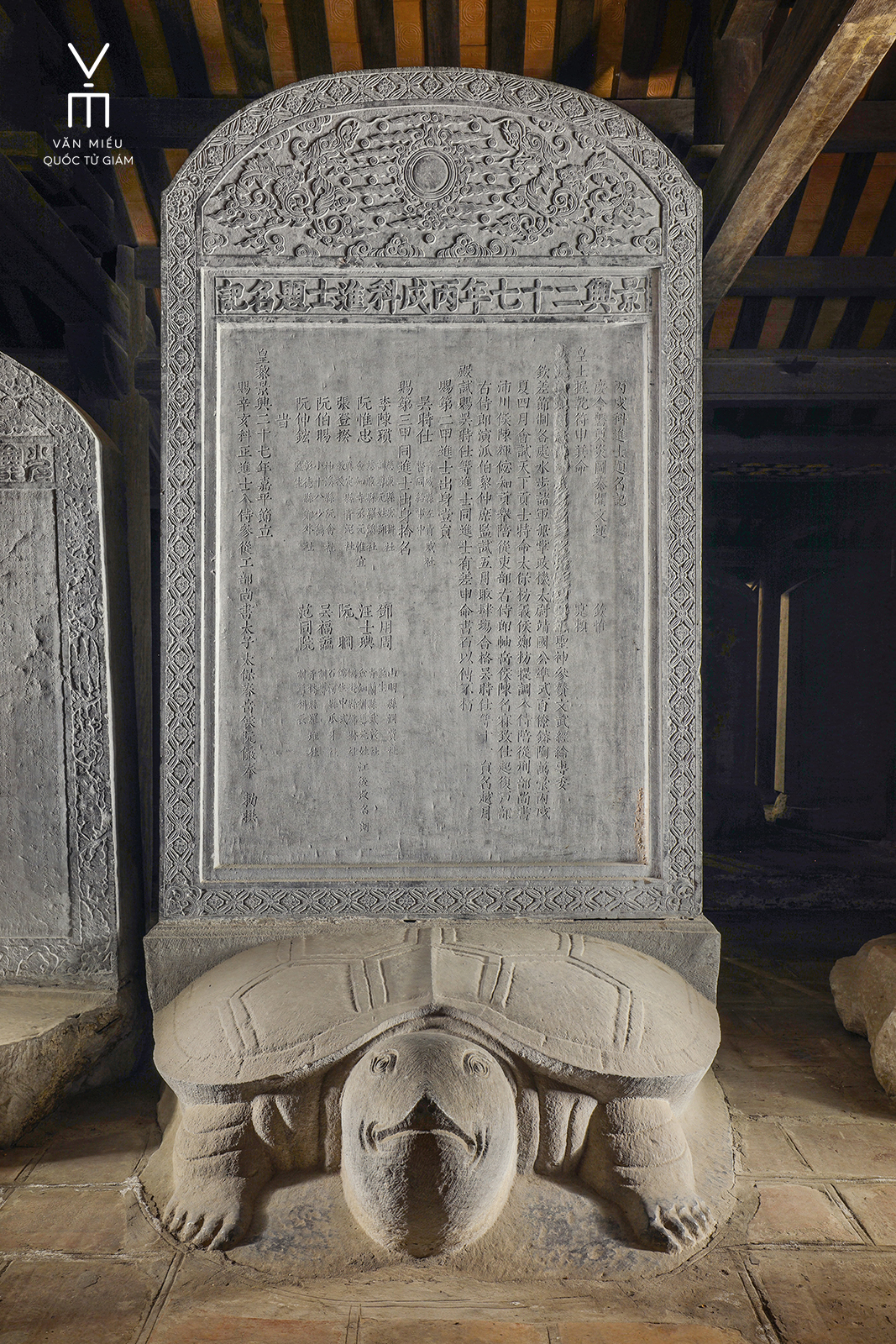
"INTERPRETING THE UNIQUE ENGRAVING 'TWO NGHÊ’S – HOLY CREATURES ADMIRING CHRYSANTHEMUM FLOWERS'"
At Văn Miếu – Quốc Tử Giám, there is an exceptional engraving called "'Two Nghê’s – Holy creatures admiring Chrysanthemum Flowers" on the Stele of Doctoral laureates for the royal exam which took place in 1592. This is the only stele at Văn Miếu – Quốc Tử Giám with this decorative design.
The Nghê is a unique mythical creature in Vietnamese culture, commonly used in artistic sculptures and stone statues, and is presented in various shapes and forms. The depiction of two Nghê’s adoring chrysanthemums, represent a form of light, and are portrayed with vivid, respectful poses, with a joyful expression on their faces. They symbolize the happiness of successful scholars, and the joy of the royal court in selecting talented individuals for the country.
This joy is not only conveyed through the image of "Two Nghê’s Admiring Chrysanthemum Flowers" on the lower part of the stele but also through the content of the inscription on the stone, which reads, "Thus, the Master’s Doctrine was revitalized and the Confucian forest became green again. The Confucian students and the citizens of the capital city crowded around to admire the laureates; all felt very happy to live in peace and prosperity under this dynasty."
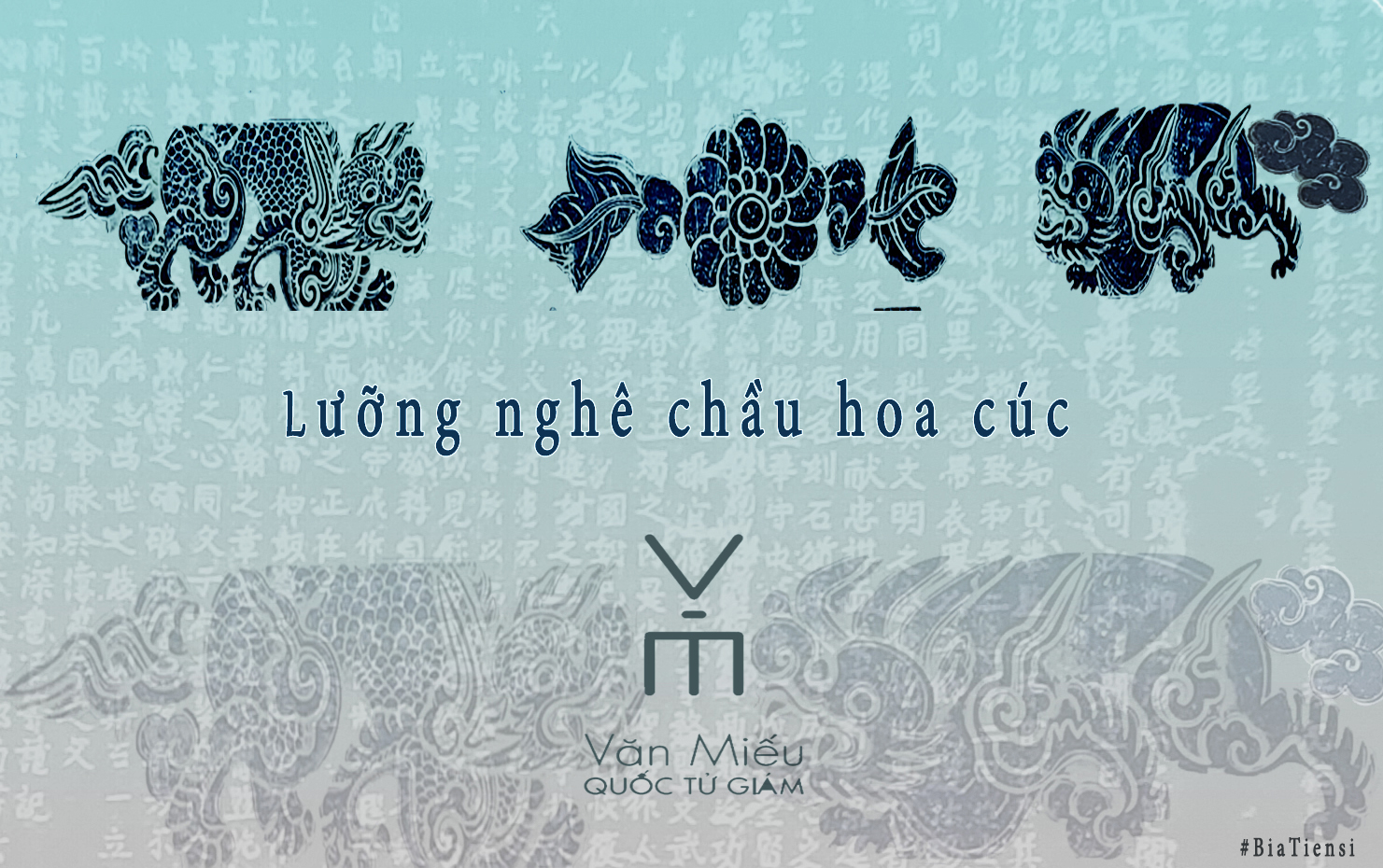
TL:LH
THE LAST DOCTORAL STELE ERECTED AT VĂN MIẾU – QUỐC TỬ GIÁM
The 82 doctoral steles at Văn Miếu – Quốc Tử Giám are extremely valuable historical artifacts. These historical stone documents provide a tremendous amount of information about the Confucian education system in ancient Vietnam. The steles were erected at different times. Of the 82 steles, the first stele was erected in the year 1442, and the doctoral stele of the Kỷ Hợi examination in the reign of Cảnh Hưng 40 (1779) was the last stele erected at Văn Miếu – Quốc Tử Giám.
This stele was erected in the middle of winter, in the year Canh Tý, during the reign of Cảnh Hưng 41 (1780) under the rule of Lord Trịnh Sâm. The stele is large, with a solemn decoration, measuring 2 meters in height, 125cm in width, and is 28cm thick. The pediment of the stele is decorated with the image of two dragons transforming into clouds while embracing the sun. The name of the stele is engraved in ancient Chinese character, 12cm in height. The body of the stele is adorned with a combination of flower motifs. The tortoise has a short neck, small eyes, a long mouth, and no fangs. The engraved pattern on the shell is in the shape of hexagonal tiles.
In the winter of the year of Kỷ Hợi, a Royal examination was held (the first round) attracting Confucian scholars who had passed the inter-provincial examination. The second round of the examination was held in the spring of the year of Canh Tý in the Royal Palace. On the following day His Majesty himself came to the Palace and set the topic for the required essay. In the end, 15 people passed this examination. Among them, two individuals achieved the second rank of Doctor. Thirteen individuals achieved the third rank of Doctor, including Doctor Phan Huy Ôn, from Thu Hoạch village, Thiên Lộc district, which is now Thạch Châu commune, Thạch Hà district, Hà Tĩnh province. He was the last person to have his name engraved on the doctoral stele at Văn Miếu – Quốc Tử Giám.
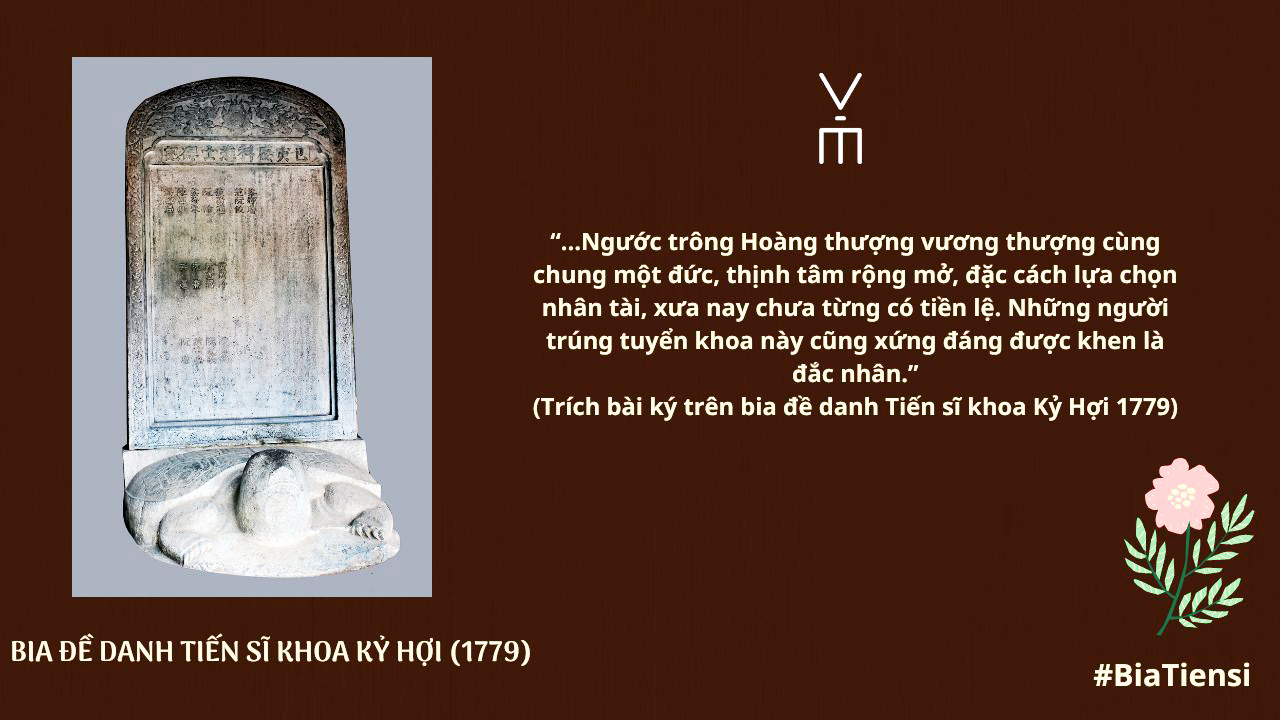
TL: LH
A STRANGE FLOWER ON STONE STELAE
On the doctoral laureates’ stelae at Văn Miếu - Quốc Tử Giám there are images of a very strange flower, do you know what flower it is? .
It is the Bao Tien flower, which is carved on most of doctoral laureates’ stelae at Văn Miếu - Quốc Tử Giám. The design of the Bảo Tiên flower on doctoral laureates’ stelae there during the Lê – Mạc dynasty takes the lotus as the main theme, often arranged with delicate leaves, or with the birds such as phoenixes, pheasants, and peacocks, which are very vivid.
The flower patterns on the stones are carved with great delicacy, featuring various shapes and rich symbolism.
The research of Dr. Trần Hậu Yên Thế on the history of this project is related to the process of Buddhism's penetration into China. In the development of Chinese art, the efforts of Buddhism to infiltrate, reconcile, and transform have brought the lotus flower together with the peony (representing Confucianism) and the chrysanthemum (representing Taoism) as a symbol of the three prevailing religions. In Vietnam, this project is widely used in decorative techniques on the architecture of pagodas, palaces during the Ly and Tran dynasties, and continued to thrive in the Le dynasty. At Văn Miếu – Quốc Tử Giám, Bảo Tiên flower is commonly adorned on the stone stelae.

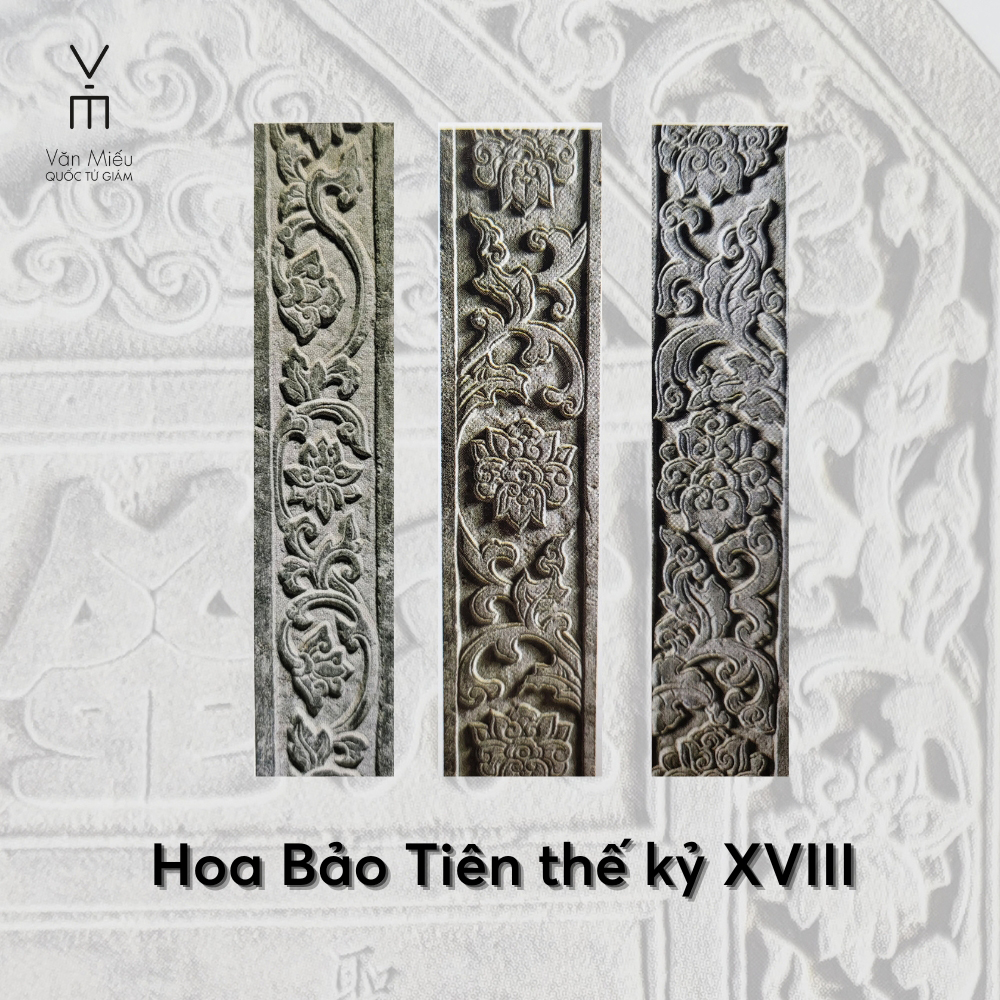
LH
READING AND UNDERSTANDING THE DOCTORAL STELE: THE STELE CARVED WITH THE NAME OF THE FATHER OF THE GREAT POET NGUYEN DU
The doctoral stele representing the examination year of Canh Thìn, under the reign of Cảnh Hưng the 21st (1760), was erected in the spring of February (1760), after the examination was held.
The stele is large, measuring 198 cm high, 123 cm wide, and 26 cm deep. The top of the stele is adorned with two dragons turned to clouds embracing the sun and moon. The edge of the stele is decorated with flowers. The turtle has a round head, short neck, large eyes, wide mouth, no fangs, and a curved back.
The names of both father and son, Nguyễn Nghiễm and Nguyễn Khản, are engraved on the stele. Nguyễn Nghiễm composed the text on the stele, and Nguyễn Khản was one of the five successful candidates of this examination. Nguyễn Nghiễm is also the father of the great national poet Nguyễn Du. He passed the examination in the year of Tân Hợi of Vĩnh Khánh the 3rd’s reign (1731) and held the position of Principle of Quốc Tử Giám.
The examination selected five outstanding candidates, all of whom achieved the rank of Third Class Doctorate. Among them, Nguyễn Khản held the position of Academician. At the end of 1769, he was appointed as a tutor to teach the crown prince Trịnh Khải (later known as Trịnh Tông) by Lord Trịnh Sâm. He was promoted to the position of deputy minister of the Ministry of Mandarinate.
The doctoral stele of the examination in 1760 is an extremely valuable historical resource within the system of 82 doctoral steles at the special national heritage site, Văn Miếu - Quốc Tử Giám./.

TL:LH
THE STONE STELE FOR EXAM IN 1760 AT VĂN MIẾU – QUỐC TỬ GIÁM
The stone stele for exam in 1760 is one of 82 stone stelae registered as the World Documentary Heritage by UNESCO as well as the national treasure that a pride of Vietnam.
The stone stele is 198cm height and 123 cm width and 26cm thick. The arched pediment is decorated with two dragons becoming clouds franking to the sun. The text engraved on the body part of stone stele showing the important imformation of examination in big Seal characters. The edging is decorated with “Bảo tiên” flowers. The pedestal is in the shape of tortoise being 33cm height and 131cm width and 200cm thick. The big writing under pediment, showing the name of stone, being in Seal characters and in 10cm. The stone was erected in 1763.
In the 2nd lunar month of the spring of the year of Canh Thin, His Majesty approved the proposal of the Ministry of Rites to hold a Royal examination (first round) for Confucian scholars all over the country.
The inscription, recording the names and homelands of doctoral laureates. There were five doctoral laureates being ranked among thousands of candidates taking part in exam in 1760, being appointed as mandarins with their great contributions for a nation. The stone stele registered as a precious heritage of a nation, preserved for generation in the future.
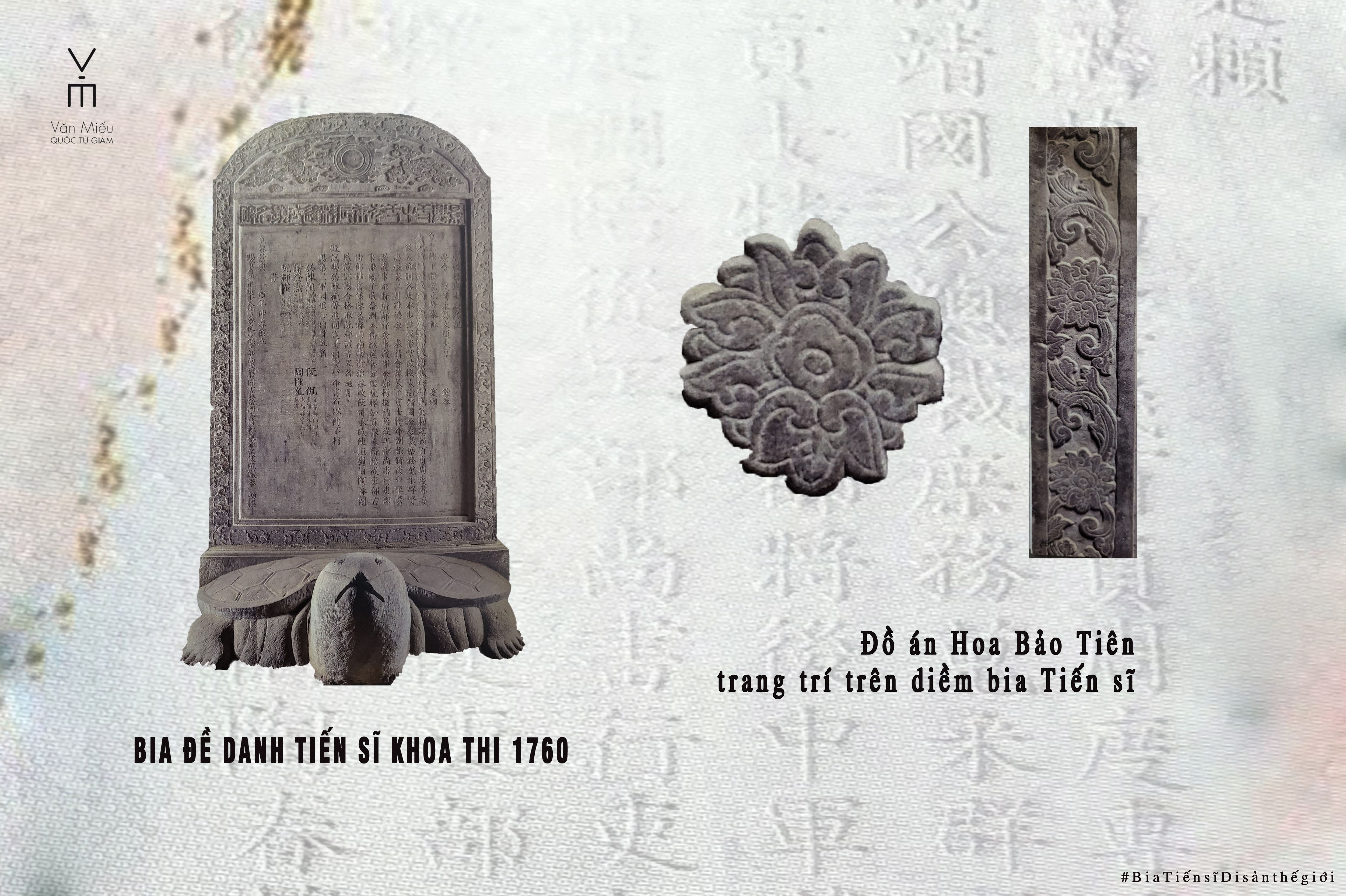
Thúy Hồng
THE STONE STELE TO RECORD THE NAMES OF THE DOCTORS ATTENDING THE EXAM HELD IN 1694
“Synthesis of primordial energies leads to emergence of superb talents. When backed by many superb men, a civilised and thriving dynasty will be long – lasting. Obviously, the course of the universe and that of the human world are in correlation with each other. Likewise, govermance and talents are inter – related. So many reigns have glided by until today, when the afore – mentioned synthesis occurs agains”. These are the opening sentences carved on the stone stele to record names of the doctors of the exam held in 1694 at Văn Miếu-Quốc Tử Giám and emphasize the importance of human talent for a nation.
The stele is very large, 187cm high, 126cm wide, and 27cm thick. The top of the stele is decorated with two phoenixes flanked by clouds, the sun, and the moon. The edges of the stele is decorated with flowers. The tortoise bearing the stele has a round head, a short neck, small eyes, a wide mouth, no teeth, an arched back, and long legs with 5 toes clustered together. The top of the stele is engraved with the date the exam was organized on.
On the stele is a text written in Chinese, engraved by Cẩn sự Tá lang of the Hanlin Academy and composed by Academician Nguyễn Nham. He passed the Royal exam in 1715 under the reign of King Lê Dụ Tông. He was awarded the title of 3rd class. The transcription was edited by the Minister of the Mandarinate, Duke Nguyễn Quý Đức.
This National exam had more than 2,000 participants. After the fourth test, the mandarins overseeing the exam selected Ngô Công Trạc and four other candidates as winners. The following month they were invited to sit for the 2nd round of the examinations at the Royal Palace. As a result, all the candidates were awarded the title of 3rd class.
After passing the exam, each of the doctors received accolades. Their names were announced by the mandarins of the Ministry of Rites and inscribed on the Golden Board hung at the gate of Thái Học House. They were granted favors such as ceremonial apparel, a Royal banquet in the Royal Garden, and silver blossoming twigs according to the old customs. Then, they were promoted to posts, both within and without the administration, such as Supervisors or members of the Academy. In the following 24 years, the laureates were “like fluttering oriels and flying Hồng birds”, both inside and outside the Court. Some of them were appointed to be very important officers.
At the end of the epitaph, the full name and detailed information about the men who engraved the text on the stele are also recorded.
The stone stele recording the names of the doctors of the exam held in 1694 is an extremely valuable source of historical data among of 82 Doctoral steles at the Special National Landmark of Văn Miếu - Quốc Tử Giám.
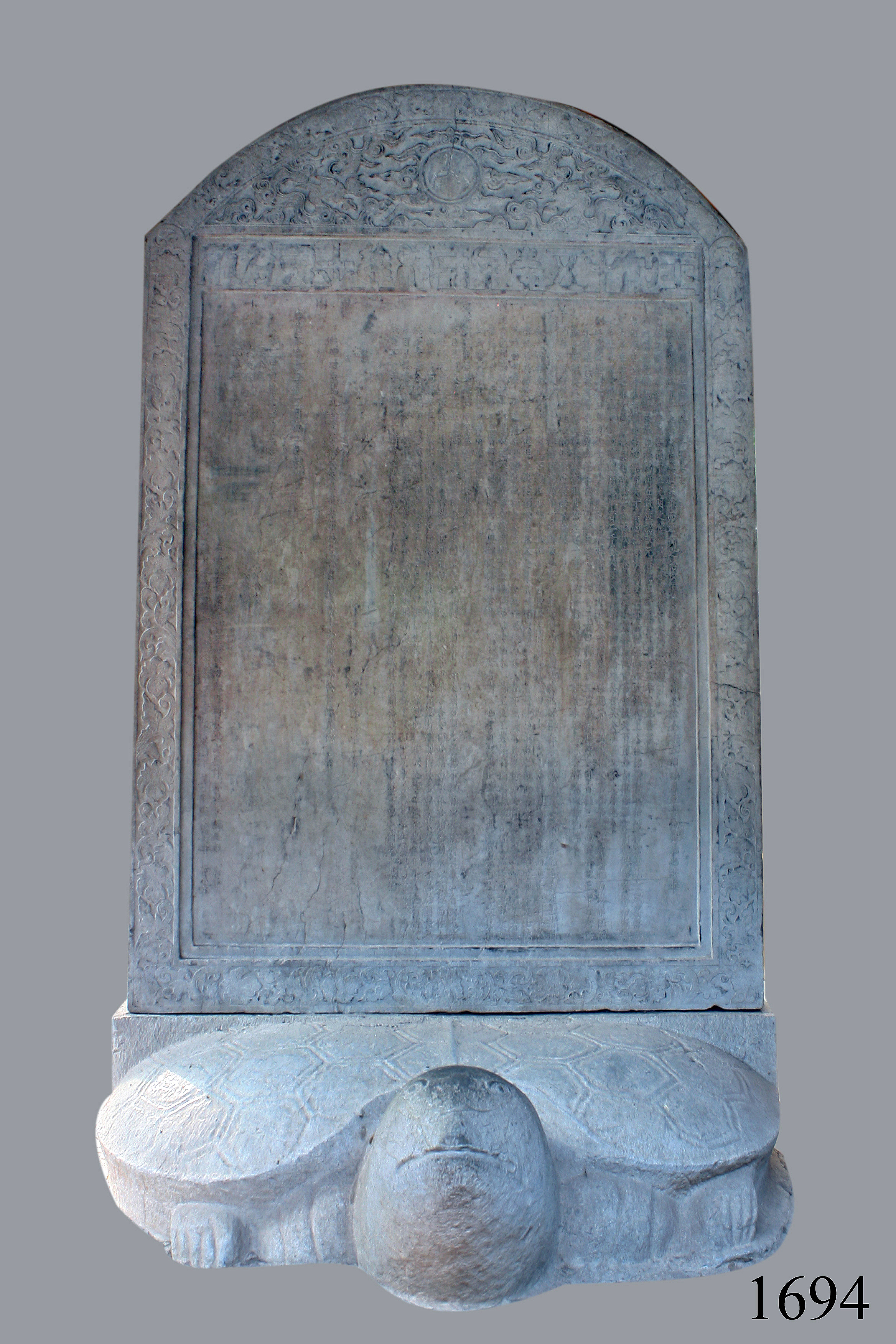
LH
THE DECORATION ART ENGRAVED ON THE DOCTOR’S STONE STELE OF THE ROYAL EXAM WAS HELD IN 1589
The doctor’ stone stele of the royal exam held in 1589 was set up on November 16th, 1653 at Văn Miếu - Quốc Tử Giám. This stele is decorated with sophisticated, meticulous motifs on the top and the edges.
The top of the stele is carved with two phoenixes worshiping the sun and moon. The artists depicted vividly two phoenixes in a position that is slowly landing.
the edge of the stele is decorated with peach blossoms, chrysanthemums, and a picture of the bird perched upon the apricot branches. The Apricot blossoms symbolize good signs, and birds on the tree bode a good omen. The bottom edge of the stele was carved with Storks and Lotuses symbolizing the great success in life, career and examinations.



LH
BIA ĐỀ DANH TIẾN SĨ KHOA THI NĂM QUÝ HỢI (1683)TẠI VĂN MIẾU-QUỐC TỬ GIÁM
Trong số 82 tấm bia đề danh các vị tiến sĩ tại Văn Miếu-Quốc Tử Giám chỉ có 18 tấm bia có khắc tên các vị Trạng nguyên. Nằm trong 18 tấm bia đặc biệt này không thể không nhắc đến bia tiến sĩ khoa thi năm Quý Hợi (1683), bia khắc tên Trạng nguyên Nguyễn Đăng Đạo.
Bia đề danh tiến sĩ của khoa thi năm Quý Hợi(1683) có kích thước nhỏ, dáng bia dẹt, cao 164cm, rộng 150cm, bia được chia làm 3 phần rõ rệt: Trán bia, Thân bia và Đế bia hình rùa. Trán bia được trang trí mặt trời và rồng mây cách điệu. Dưới Trán bia là hàng chữ Triện, chiều cao 10cm. Diềm quanh thân bia được trang trí họa tiết hoa dây. Chữ khắc trên Thân bia rất rõ nét. Đế bia hình rùa được tạo tác đơn giản, rùa có đầu ngẩng cao, mắt và mũi nhỏ, mai rùa trơn nhẵn, chân rùa được đục nông.
Bia được dựng vào ngày mồng 3 tháng 3 năm 1717 trong đợt dựng bia tập trung lần thứ 3 (gồm 21 tấm bia của các khoa thi tổ chức từ năm 1656 đến năm 1712). Về việc này, trong bài văn bia có ghi rõ: “Nhưng việc khắc đá đề tên chưa kịp cử hành, đó là vì các khoa từ năm Bính Thân tới nay vẫn chưa được dựng bia là muốn đợi làm luôn một thể”.

Khoa thi năm Quý Hợi (1683) được tổ chức vào cuối năm đã thu hút tới 3000 người dự thi. Trải qua 4 trường thi của kỳ Hội thí đã lấy đỗ được 18 người. Sang tháng Giêng năm Giáp Tý, các thí sinh tiếp tục dự kỳ Điện thí do vua Lê Hy Tông đích thân ra đề. Sau kỳ Điện thí chọn được 3 người đỗ đầu gồm: Trạng nguyên Nguyễn Đăng Đạo, Bảng nhãn Phạm Quang Trạch và Thám hoa Quách Giai.
Trạng nguyên Nguyễn Đăng Đạo sinh năm 1651, mất năm 1719. Ông là người làng Hoài Bão, huyện Tiên Du, trấn Kinh Bắc (nay là xã Liên Bảo, Tiên Du, Bắc Ninh). Cha ông là Tiến sĩ Nguyễn Đăng Tuân, bác là Thám hoa Nguyễn Đăng Cảo. Nguyễn Đăng Đạo đỗ Trạng nguyên khi 33 tuổi. Năm Đinh Sửu (1697) ông được cử đi sứ sang nhà Thanh để thương lượng đòi lại động Ngưu Dương, Hồ Điệp, Phổ Viên thuộc huyện Vị Xuyên, xứ Tuyên Quang. Nguyễn Đăng Đạo làm quan trong triều trải các chức: Bồi tụng, Hộ bộ Hữu Thị lang, Lại bộ Hữu Thị lang, Ngự sử đài Đô ngự sử, Binh bộ Thượng thư,.. Khi mất, ông được phong tặng Lại bộ Thượng thư, tước Thọ Quận công, đồng thời được sắc phong làm Phúc thần phối thờ ở đình làng Hoài Bão.
Bảng nhãn Phạm Quang Trạch sinh năm 1653, người xã Đông Ngạc, huyện Từ Liêm(nay là thôn Đông Ngạc, xã Đông Ngạc, huyện Từ Liêm, Hà Nội). Ông đỗ Bảng nhãn khi 31 tuổi. Ông làm quan đến chức Lễ bộ Hựu thị lang, tước nam. Khi mất được tặng chức Tả thị lang, tước tử.
Thám hoa Quách Giai sinh năm 1660, người xã Phù Khê, huyện Đông Ngàn (nay là thôn Phù Khê, xã Phù Khê, huyện Từ Sơn, Bắc Ninh). Ông đỗ Thám hoa khi 24 tuổi, làm quan đến chức Thái thường tự khanh.
Đỗ hàng Đệ nhị giáp Tiến sĩ xuất than là Hoàng giáp Nguyễn Đương Hồ, người huyện Tiên Du, tỉnh Bắc Ninh. Nguyễn Đương Hồ làm quan đến chức Hình bộ Thượng thư. Đỗ hàng Đệ tam giáp đồng Tiến sĩ xuất thân có 14 người.
Bài ký văn bia do Cẩn sự lang Hàn lâm viện hiệu thảo Nguyễn Kiều-Tiến sĩ khoa thi năm Ất Mùi Vĩnh Thịnh 11(1715), ông là người đã soạn 4 bài văn bia Tiến sĩ các khoa 1667, 1683, 1697, 1713. Nổi bật trong lời văn bia là những lời răn dạy về trách nhiệm gánh vác trọng trách triều đình dành cho những quan chức đương thời và những người vừa đỗ đạt: “Nhưng những người hiện đang được triều nay trọng dụng há không nhớ ơn lựa chọn của tiên vương, cảm nghĩ sự biểu dương ngày nay mà cẩn bước đường về sau, mỗi ngày một tiến để khỏi hổ thẹn với khoa danh sao? Thảng hoặc không được như thế, chỉ nặng nghĩ lo riêng cho mình mà nhẹ lòng vì việc nước, cầu may cho được chu toàn, thích xu nịnh, né tránh việc mất lòng, ắt không tránh khỏi công luận mai sau, há chẳng đáng sợ hay sao?”
CT
THE STONE STELE TO RECORD NAMES OF THE DOCTORS OF THE EXAM HELD IN 1623
The stone stele to record names of doctors of the exam held in 1496 was erected on December 16, 1653. This stele is 156 cm high, 106 cm wide and 17cm thick. Its forehead is decorated with the motifs “the sun and rays of light”. The edge around the stele is decorated with flowers.
The examination drew more than 3,000 participants, out of whom seven were rated as winners. On an auspicious day of 4th lunar month, His Majesty sat in the Kính Thiên Palace and set the topic for the second round of the examination. Having read the examination papers, His Majestic decided to award the title 3rd – class to six candidates, with Phùng Thế Trung rank at the top of the list.
October 1653 His Majestic had arranged for the names of the doctoral laureates to be recorded in the book “Đăng khoa lục” and written on a Golden Board to hang at the Quảng Văn Pavilion.

LH
THE STONE STELE TO RECORD NAMES OF THE DOCTORS OF THE EXAM HELD IN 1496
The stone stele to record names of doctors of the exam held in 1496 was erected on December 6, 1496, it was erected during the reign of King Lê Thánh Tông. This stele is 169 cm high, 118 cm wide and 19 cm thick. Its forehead is not decorated, and the edge around the stele is decorated with flowers. It was built along with other steles under the Lê Sơ dynasty and their decorative motifs and inscriptions are small and shallow.

This exam could select 30 excellent people. The King personally read the candidates’exam paper and then chose Nghiêm Viện as the best candidate who was bestowed the academic title of Trạng nguyên. The second best is Nguyễn Huân ( academic title of Bảng nhãn), the third best is Đinh Lưu(academic of Thám hoa). In addition to the three best candidates, there are also 8 candidates who ranked 2nd in the exam, they were bestowd the academic title namely Hoàng giáp. 19 candidates who ranked 3rd were bestowed the academic title namely Tiến sĩ or Doctor.
The king granted the doctors the usual honors, ordered that the Ministry of Public Works engrave the names of the doctors on stone stele, and that the Academy Royal Commentator, Lưu Hưng Hiếu make a report to record the exam. The content of the report that was engraved on the stele clearly pointed out the responsibilities and obligations of scholars to the country.
CT
THE STONE STELE AT THE VĂN MIẾU-QUỐC TỬ GIÁM TO RECORD NAMES OF DOCTORS OF THE ROYAL EXAM IN 1511
Among the 82 steles at the Văn Miếu-Quốc Tử Giám, 13 were erected under the Lê dynasty. There is a stele that records names of the doctors of the examination held in 1511 and marks a change in the art of stele decoration in the Lê Sơ Dynasty.
The stele was erected on March 15, 1513. The stele is small, flat, 166 cm high, 124 cm wide and 20 cm thick. Like other steles at the Văn Miếu-Quốc Tử Giám, it has 3 parts: stele forehead, body and turtle-shaped pedestal. The forehead is decorated with the motifs "Sacred clouds and jewels, rhino horns". The body is decorated with flowers. On the top of the stele is a line of words in Seal characters, the words are 15cm high. Tortoise holds its head high, havs large eyes, prominent nose, pointed feet, smooth shell with raised ridges running along. However, this stele shows a difference in the art of stele decoration, this is the stele marking the change from shallow engraving to embossed motifs. With this technique, the motifs are engraved more carefully, so the motifs like waves, trees and clouds look more vivid.
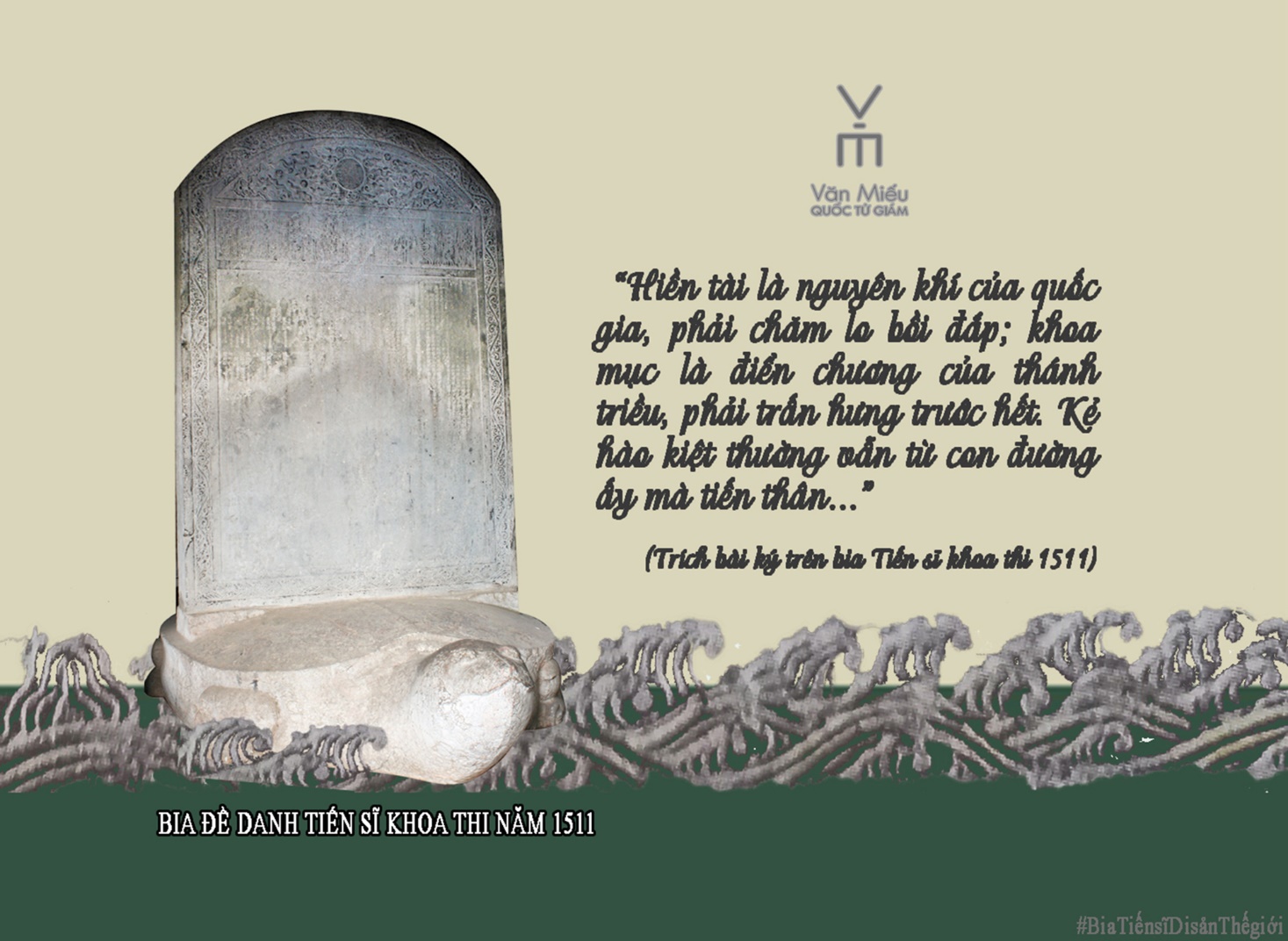
In the spring of 1511, the candidates took the exam held by the court. 47 excellent candidates were selected. On April 17, King Lê Tương Dực personally assigned an essay whose theme asked about the country's governance in the past and present. After the exam, the top three people called Tam Khôi were bestowed academic titles(Trạng nguyên-the best candidate, Bảng nhãn-the second best and Thám hoa-third best) including Trạng nguyên Hoàng Nghĩa Phú, Bảng Nhãn Trần Bảo Tín and Thám hoa Vũ Duy Chu.
In addition to the three best candidates, there are also 9 candidates who ranked 2nd in the exam, they were awarded the academic title namely Hoàng giáp. The 35 people who ranked 3rd were awarded the academic title namely Tiến sĩ or Doctor. All of them were appointed by the court to different positions in the government system and made many contributions to society.
CT
THE STONE STELE AT THE VĂN MIẾU-QUỐC TỬ GIÁM
TO RECORD THE NAMES OF PH.DOCTORS OF THE EXAM HELD IN 1727
There were 3000 participants who took part in the National examination in 1727, but only 10 excellent men were selected to participate in the Royal exam. After the examination, the doctor laureates were ranked, granted the most solemn graces from the court, and were appointed to positions. In 1733, King Lê Thần Tông ordered engraving the names of 10 doctor laureates on the stone stele located at Văn Miếu – Quốc Tử Giám.
For nearly 300 years the stelea have remained intact. The letters and motifs on the stelea are deeply beautiful engravings. The stone stele is 184 cm high, 130 cm wide and 24 cm thick. The arched pediment is decorated with two dragons facing the sun. The edging is decorated with string flowers. The rectangular body of the stelea is engraved with about 1300 vertical characters. The pedestal is in the shape of a tortoise with its head raised, with no turtle shell in the carving.
The content of the text shows that the selection and using of talents were taken seriously: “Stone stelea have been built for Royal examination laureates with a view to memorializing their names forever and diffusing the brilliance of Khuê and Tảo constellations. His Majesty’s efforts to cultivate and foster the moral of Confucian scholars and to re ward and inspire men of distinction can be said to surpass, in terms of extent, those of the previous Emperors, or even those of the sovereigns in the days of yone”.
The participants numbered up to 3,000, but only 10 of those emerged as winner. This shows the rigor in the organization of talent selection exams.
The text for the stele of the examination held in 1475 was composed by the academician Nguyễn Duy Đôn, edited by Minister of Militery Affairs Phạm Khiêm Ích.
These stone stele wereset up on the 26th day of the 8th lunar month of the year Long Đức II (1733) in Great Việt.

LH
THE STONE STELE AT THE VĂN MIẾU-QUỐC TỬ GIÁM TO RECORD THE NAMES OF PH.DOCTORS OF THE EXAM HELD IN 1481
The stone stele is 141cm height and 109cm wide and 18cm thick. The arched pediment is decorated with holy cloud and jem. The edging is decorated with the string flowers of "Thảo Đường". The pedestal is in the shape of a tortoise with big eyes and head held high. The stone stele was erected in 1484.
There were over 2000 participants who took this exam. The King personally ranked those who passed. The most excellent candidates were called doctoral laureates with their ranks. There were 40 doctoral laureates ranked among thousands of candidates taking part in exam in 1481.
The text also clearly shows the praising Lê? Kings for their contributions, recording the names and homelands of doctoral laureates. The stone stele is registered as a precious heritage of the nation, preserved for generations in the future.
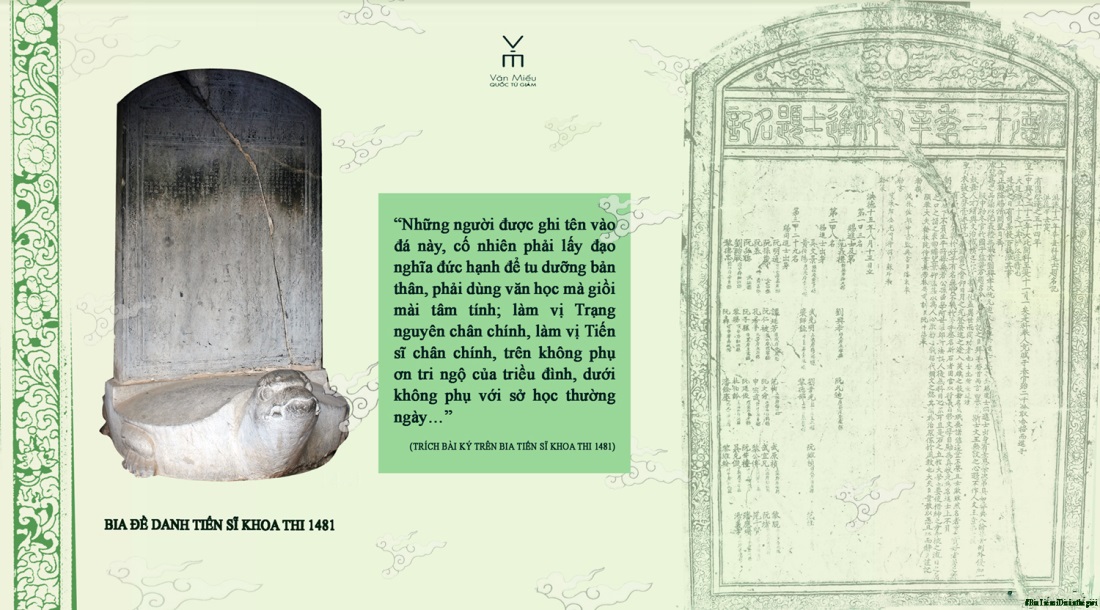
The stone stele at Văn Miếu - Quốc Tử GIám to record the names of PH doctors of the exam held in 1481.
LH
THE STONE STELE FOR EXAM IN 1752 AT VĂN MIẾU - QUỐC TỬ GIÁM
The stone stele is 170cm height and 108cm wide and 19cm thick. The arched pediment is decorated with holy tree and the sun and the moon. The edging is decorated with the combination of "Bảo Tiên" flowers. The big writting under pediment, showing the name of stone, being in Seal characters and in 10cm. The pedestal is in the shape of tortoise with the big eyes and its neck craning highly. The stone stele was erected in 1753.
In the winter of 1752, the King ordered the national exam to be held to select the talents throughout a country. The King chose the brilliant mandarins with their deep knowledge and experiences playing roles as the members of board of examiners. Passing the national exam was a condition to take part in the royal exam at the king's court. The most excellent candidates were called doctoral laureates with their ranks. There were six doctoral laureates ranked among thousands of candidates taking part in exam in 1752.
The inscription, praising Lê Kings and Trịnh Lords for their contributions, recording the names and homelands of doctoral laureates. The stone stele registered as a precious heritage of a nation, preserved for generation in the future.
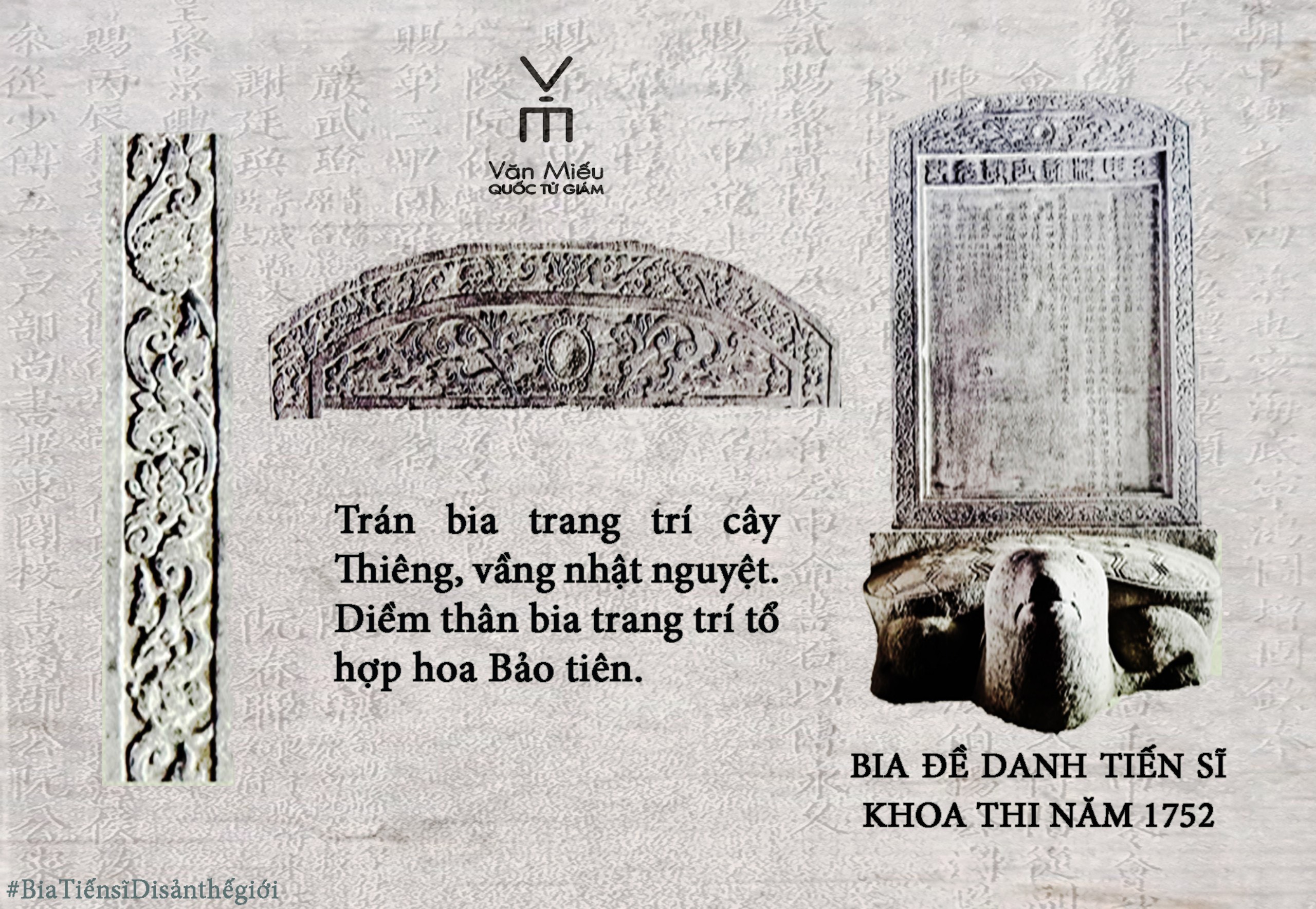
Translator: BP
THE STONE STELE AT THE VĂN MIẾU-QUỐC TỬ GIÁM TO RECORD THE NAMES OF PH.DOCTORS OF THE EXAM HELD IN 1683
After passing the Royal exam, the doctors were granted many privileges by the court: “The names of the doctors were publicly announced, and written on the board that was hung at the Quốc học house. They were also given robes, belts, hats, and the opportunity to attend a banquet ".... Finally, their names were engraved on a stone stele which was erected at the Văn Miếu-Quốc Tử Giám. The stele that records the names18 doctors who passed the exam held in 1683 is one of 82 steles being preserved at the Văn Miếu-Quốc Tử Giám.
This stele is big, 178 cm high, 122 cm wide, 23 cm thick. The pediment is decorated with clouds , the moon and the sun. The edge around is decorated with flowers. The turtle's head is high; its neck is short; its eyes are small, its mouth has no fangs. Its back has a small moulding; each of its legs has 5 claws.
The name of this stele which is engraved in the style of the Seal script at the top of the stele indicates the year the exam was held.
The Hội exam had 3,000 candidates, but only 18 of them could pass. In January of the following year, the Royal Exam was held, and the King personally ranked those who passed. The king selected the best 3 candidates, they were awarded the three academic titles including Trạng nguyên, Bảng nhãn and Thám hoa. They were Trạng nguyên Nguyễn Đăng Đạo, Bảng nhãn Phạm Quang Trạch and Thám hoa Quách Giai.
The text in Chinese was composed by Nguyễn Kiều (1695-1752). He was born in Phú Xá commune, Từ Liêm district (now Phú Thượng, Tây Hồ district, Hà Nội). He is the husband of Đoàn Thị Điểm - a famous female poet. At the age of 21, he passed the exam held in 1715, became an official and was promoted to Tả Thị lang position (equivalent to Deputy Minister) of War Ministry.
The text also tells us that the court has selected reliable and talented officials to assign the organization of this exam. They have made an important contribution in selecting talents for the country.
The text also clearly shows the view of the Court on respecting talents, saying: "Because talent is the tool of the nation, with enough tools, anything can be done. Therefore, from the past to the present, there is nothing as urgent as looking for talented people to trust and assign work." Along with that, the advice for the scholar is also clearly stated: "Those who are being respected by the court today should remember being chosen by the ancestors so that they will be careful with their future actions. They should also try to make progress every day so that they don't feel ashamed of the wrong things they do. On the contrary, if they only think for themselves but don't care about the country, like to be flattered, and avoid losing heart, they will inevitably be shamed by public opinion in the future."
The stele of the exam held in 1683 and 81 other steles are very valuable historical documents still being preserved at the Văn Miếu-Quốc Tử Giám.
CT
THE STONE STELE FOR EXAM IN 1463
The stone stele for exam in 1463 being one of the first 10 stone stelae erected 1484 under the reign of Lê Thánh Tông king.

The stone stele for exam in 1463 is flat, 152 cm high, 119 cm wide, 17 cm thick. The arched pediment is decorated with the motif of “Clouds – shaped musical jade”. Motif of clouds representing impact of Taoism on the stone stelae. The big writing under the pediment, showing the name of stone, being in Seal characters and 11cm high. The body is rectangle standing on the pedestal. The pedestal has in tortoise shape with the edge in the middle of the smooth shells and the feet consisting 5 toes.
There were up to 1.400 candidates participaed in this exam. The candidates had to do the essay with the topic given by King concerning how to rule a nation and manage the talents. 44 successful candidates passed the exam with high scores, called the doctoral laureates with their ranks: the rank first (Trạng nguyên, Bảng nhãn, Thám hoa), the second (Hoàng giáp), the third (Tiến sĩ).
The inscription on the stone showing the way of king to treat the talents. Otherwise, the inscription referred to content that it was an unfortunate that many stone stelae were not erected until 1484. .
BP.
A SOLE STONE STELE ERECTED UNDER MẠC DYNASTY AT VĂN MIẾU - QUỐC TỬ GIÁM
Among of 82 stone stelae is one stone stele for exam in 1529 erected under the reign of Mạc dynasty.
The stone stele for exam in 1529 is flat, 158cm high, 109cm wide, 20cm thick. It consists of 3 parts: pediment, body and tortoise-shaped pedestal. The arched pediment is decorated with the motif of "clouds and pearl". The rectangle body recording the text in Chinese characters. The big writing under the pediment, showing the name of stone, being in Seal characters and 11cm high. The pedestal has in tortoise shape with big eyes and the edge in the middle of the smooth shells.
The stone stele was erected in Novembern of 1529 after three years of Mạc Đăng Dung king's accession and the beginning of examination. Especially, there were two men wrote the text engraved on the stone.
The exam in 1529 was the first exam organized under Mac dynasty. Up to 4000 candidates participated in exam. The candidates had to do the essay with the topic given by king concerning how to rule a nation and manage the talents. 27 successful candidates passed the exam with the high score, called the doctoral laureates with their ranks: the rank first (Trạng nguyên, Bảng nhãn, Thám hoa), the second (Hoàng giáp), the third (Tiến sĩ)
Under Mac dynasty, the king paid a great attention to education and the talents. The inscription on the stone showing us the doctoral laureates received many favours from king. Moreover, the inscription on the stone recording the admonition for the Confucian scholars as well as the next generation.
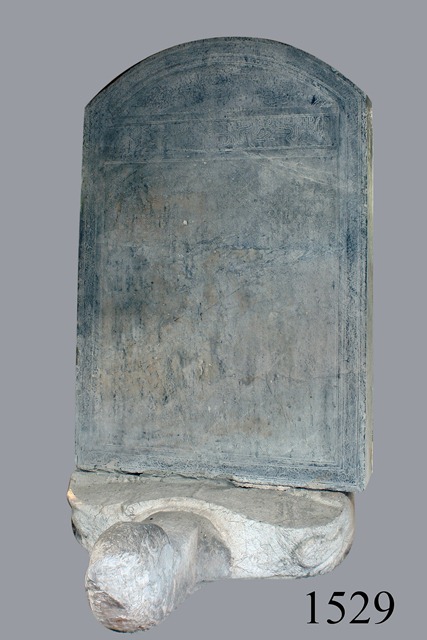
Bia đề danh Tiến sĩ khoa Kỷ Sửu niên hiệu Minh Đức 3 (1529).
Access the website for the list of doctoral laureates passing exam in 1529
http://vanmieu.gov.vn/vi/di-tich/82-bia-tien-si
Translator: BP
THE STONE STELE AT THE VĂN MIẾU-QUỐC TỬ GIÁM TO RECORD THE NAMES OF PH.DOCTORS OF THE EXAM HELD IN 1502
On 82 steles at the Văn Miếu-Quốc Tử Giám, the number of doctors whose names are engraved on a stele ranges from 3 to 62. The stele that records the names of doctors of examination in 1502 is one of the two steles with the largest number of doctors. The first is the stele of the exam in 1478 that records names of 62 doctors, and the other stele was the one of 1502 with 61 doctors.
In terms of shape and size, the stone stele of the exam held in 1502 is small, flat, 155cm high, 111cm wide and 15cm thick. It consists of 3 parts: Pediment, Body and Tortoise-shaped Pedestal. The arched pediment is decorated with the motif of “Clouds and jewels”. The body is now cracked, the edge around the body is decorated with flower motifs. The big writing under the pediment is in Seal characters and 07cm high. The pedestal looks plain, and the tortoise has a big head, no legs, big eyes, smooth shell. The eyes and nose form T-shape.
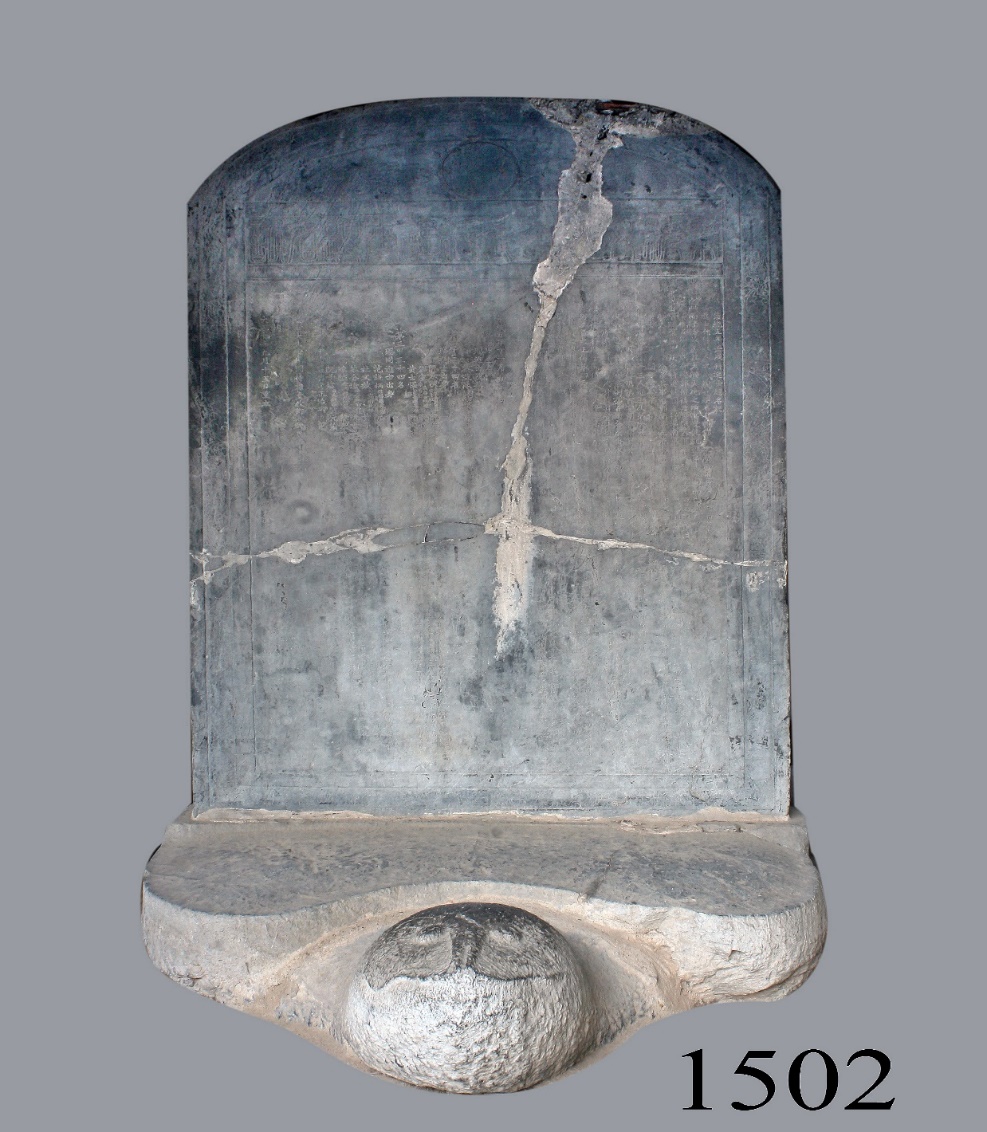
It is clearly stated in the inscription on the stele that there are two different dates for the erection of the stele. The first is on November 10, 1502 while the information at the end of the text says that the stele was erected on September 15, 1536. According to the book “Văn Miếu-Quốc Tử Giám và 82 bia Tiến sĩ” by the late Assoc. Prof. Dr. Ngô Đức Thọ, there is likelihood that for some reason only the text was written while the inscriptions and stele erecting were not done. At the beginning of the Mạc dynasty, the stele was erected and the text that had been written before was engraved on the stele.
In the spring, 1502, as usual, the court organized the Hội exam(a national exam). Up to 5000 candidates took the exam. After four rounds, 61 people were selected to participate in the Đình exam(Royal exam) After that, the candidates were personally examined by King Lê Hiến Tông at the Dragon yard. Finally, the king selected the 3 best people who were awarded the academic distinctions, including Trạng nguyên, Bảng nhãn và Thám hoa. In addition, 58 other candidates were selected.
To look up the names of the doctors, please click on the link: http://vanmieu.gov.vn/vi/di-tich/82-bia-tien-si/...
CT
LOTUS MOTIFS DECORATED ON THE STONE STELES AT THE VĂN MIẾU-QUỐC TỬ GIÁM
Lotus symbolizes elegance, purity, and has become familiar in Vietnamese culture. From an early period, the lotus appeared in the visual arts, and was reflected in architecture and sculpture. This creates the style of lotus of different periods.
Typically, lotus motifs are also decorated on the edges of the stone stele at the Văn Miếu-Quốc Tử Giám. These motifs are diverse and of high aesthetic value, including: Cloud-shaped lotus; Lotus-shaped pedestal; Creeper lotus;…
* Cloud-shaped Lotus
Lotus motifs were decorated on the first steles of the early Lê Dynasty. The lotus is in the center of the decorative composition. When seen from the side, each layer of petals is clearly visible. The flower bud in the innermost part has not yet bloomed. The layers of lotus petals spread evenly on both sides. The outermost lotus petals have a spiral shape while each petal looks like a cloud.
Cloud-shaped lotus motifs appear mainly on a few stone steles at the Văn Miếu – Quốc Tử Giám erected in the 15th century. During this period, decorative motifs on stele often looked very delicate, sharp and elegant.
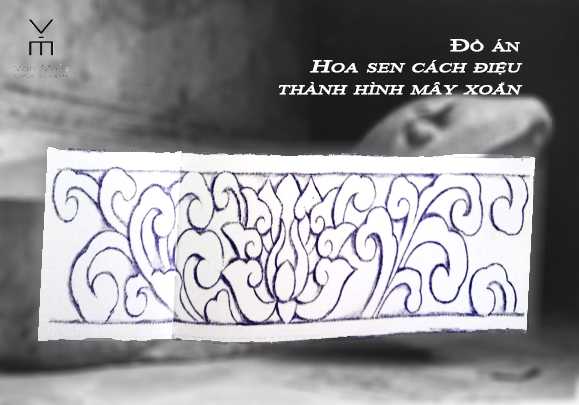
(Photo: The stylized lotus motif of the early Lê Dynasty is decorated on the stele that records the names of the Doctors of the exam held in 1478.
Source: " Nét Việt trên bia Tiến sĩ Văn Miếu" – Quốc Tử Giám”, Trần Hậu Yên Thế, Trần Trung Hiếu, Fine Arts Publishing House 2018)
*Motif of lotus-shaped pedestal
The lotus motifs of this type are decorated on the stele in the same way as those decorated on the pedestal of the Buddha statue. At the Văn Miếu – Quốc Tử Giám, there are more than 10 stone steles which were erected around the 17th century and decorated with lotus motifs but in different ways.
The lotus motifs decorated on stele in this way are usually large. The petals are arranged in 1 to 3 layers, and are arranged horizontally. The layers of petals are shallowly carved, and stylized into a cloud shape.

(Photo: Motif of lotus-shaped pedestal decorated on steles erected in the sixteenth and seventh centuries)
*Motif of Creeper Lotus
Motif of Creeper Lotus Another type of lotus motif on the stone stele is Creeper lotus. This motif is a combination of 2 types of flowers: chrysanthemum and lotus. These two flowers are arranged one after another on a creeper and are decorated around the edge of a stele. The lotus motif of this type is only a formalization. In fact, lotus leaves and chrysanthemum leaves are different from those engraved on the stele; moreover, these two flowers are not creepers. Thereby, we can see the creativity and ingenuity of the ancient artisans.

(Photo: Motif of Creeper lotus decorated on the edges of the steles at the Văn Miếu – Quốc Tử Giám)
CT
THE STONE STELE RECORDING NAMES OF LAUREATES OF EXAM HELD IN 1475 AT VĂN MIẾU – QUỐC TỬ GIÁM
In 1484, King Lê Thánh Tông ordered the erection of the stone stele recording names and homelands of doctor laureates. There are 7 out of the 10 stele erected in this time still kept at Văn Miếu – Quốc Tử Giám. The stone stele recording names of laureates of exam held in 1475 is one of those 7 stele.
The stone stele is small - 154cm high, 119 cm wide, and 18cm thick. The stele consists of 3 parts: the forehead, the main part and the tortoise base. The forehead is decorated in the form of clouds playing with the sun. The main part is engraved with vertical Chinese stele. The sides are decorated with wire flowers. The tortoise is delicately carved, with head raised high, the mouth wide with two fangs, the eyes quite large, the turtle shell not carved, and the turtle's legs with 5 claws attached to the body.
In march of 1475, the imperial court held a National exam for bachelors. There were more than 3000 candidates, through four rounds, and only 43 people were selected for the Royal exam.
The first grade laureate was Vũ Tuấn Chiêu, 49 years old. The second grade laureate was Ông Nghĩa Đạt. The third grade laureate was Cao Nghĩa, 37 years old.
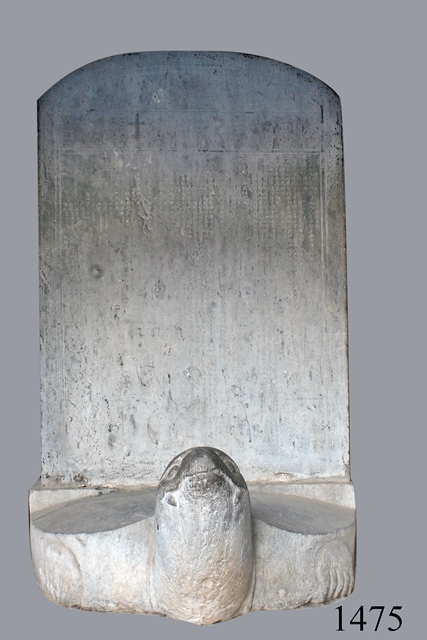
The text for the stele of the examination held in 1475 was composed by the academician Lê Tuấn Ngạn. The content shows that the education and training of talents was very important under the reign of King Lê Thánh Tông: “Men of talent are absolutely essential for the nation, just as vital energy is a requirement for every human being. However, there must be a policy and procedure for selecting and promoting talented people.”. “All of them have been appointed to different posts…They try their hardest to perfect themselves and record brilliant achievements to fulfill their aspirations and to pay a debt of gratitude to the Court. People of subsequent generations may point to their names on this stone stele and offer opinions such as: “This man is righteous and that man is wicked…Therefore, this stone stele not only highlights the good reputation of the laureates of the Royal examination, but also serves as advice and warning.”.
The text also tells us the names, positions, and responsibilities of the officials responsible for this exam such as: Commanders in chief, Count Trịnh Công Lộ, Minister of the Mandarinate Hoàng Nhân Thiêm. Panel of Judges: Chief Academician Thân Nhân Trung, Academician Đỗ Nhuận and Quách Đình Bảo. Supervisors: Procurator Trần Phong and Phí Bá Khang.
The text on the stele of 1475 records the names of calligraphers. With their skillful and talented hands, they have created a unique work of art, which is a valuable historical source of education in Vietnam during the monarchy.
LH
THE FIRST DOCTOR STELE WAS ERECTED AT VĂN MIẾU – QUỐC TỬ GIÁM
On the 15th day of the 8th lunar month,1484, King Lê Thánh Tông ordered the erection the stone stele recording names and homelands of doctor laureates of examinations at Văn Miếu – Quốc Tử Giám in order to honor talents and encourage studying. The stone stele recording names of laureates of exam held in 1442 was one of the first 10 stone stalea which were erected at this time.
The stone stele is small, 108cm high, 52cm wide, 18cm thick. The stele pediment is in an arch shape and decorated with precious clouds, sacred trees, and strange grass. The stele was put on the tortoise which has a round head, raised high, slightly forward and mouth wide with fangs. The tortoise’s eyes are large, round, and graceful, expressing the eternal desire of knowledge. The first sentence of the text in big capital states the year when the examination was held.
The main part of the text praises the merit of the contemporary king, the reason for holding the exam, names and functions of the examiners with the designated tasks, then it reports names and homelands of laureates in the order of rank: first rank, second rank, third rank and the name and functions of the text composer, editor, calligrapher, time of stele erection. It tells us also the number of candidates for the National exam was 450 men, and only 33 men were selected.
The first grade laureate was Nguyễn Trực. He worked as Rector of Quốc Tử Giám later. Nguyen Truc was sent as the King’s envoy to China. The second grade laureate was Nguyễn Như Đổ who also worked as headmaster of Quốc Tử Giám. The third grade laureate was Lương Như Hộc. He was the first person who taught woodblock printing to the villagers of Liễu Tràng and Hồng Lụcc in his hometown. Ngo Si Lien was among 33 doctoral laureate who passed exam with the third rank called doctor. He was appointed to many official roles at the court. The national history series compiled by historians includes writings by Ngo Si Lien. The series includes 15 books. He also worked as a deputy head of Quốc Tử Giám.
The text on the stele 1442 records the names and the titles of the text composer, editor, calligrapher and the time of the stele erection. They were the high officials and talented men.
The text for the stele of the first examination held in the 3rd year of the reign of Dai Bao (1442) was composed by the academician Than Nhan Trung (Title: Han lam vien Thua chi, Dong cac Dai hoc si) and affirms: “Virtuous and talented men are the primordial vitality of a State. If this vitality is strong, the State will be powerful and prosperous. If it is not, the State will weaken and have a low standing. Therefore, clear-sighted monarchs always attach importance to educating talented men and selecting Confucian scholars for the mandarinate, and regard the fostering of the State’s primordial vitality as an urgent task”. This is the quintessence of knowledge of the intellectuals of different generations and the experiences of the principles for educating themselves and those of the State governance of Vietnam.
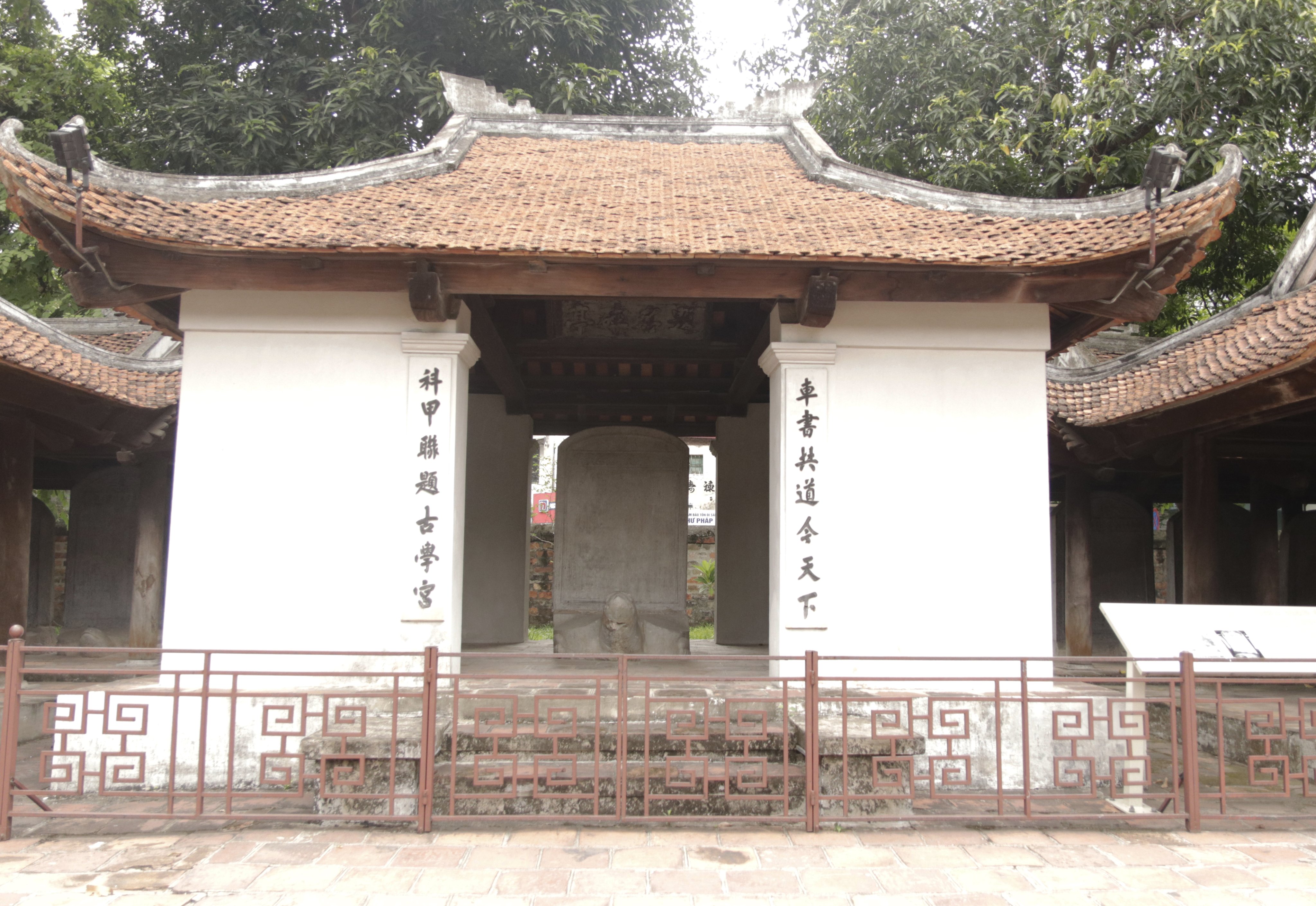
The stone stele of the exam in 1442 is placed in the hall. The outside is engraved with parallel sentences which mean to praise the education and engraving the name of Doctor Lauretes.
LH
STORKS AND LOTUS CARVED ON DOCTOR STELE AT VĂN MIẾU – QUỐC TỬ GIÁM
The folk sculpture "storks and lotus" is a familiar image in Vietnamese villages: a large lotus pond interspersed with lotus leaves, lotus flowers and storks and ducks swimming. This is carved on the Doctor's stele.

Doctor stele for the exam in 1589
82 Doctoral steles at Văn Miếu – Quốc Tử Giám, are not only the historical records of Vietnam's education of the monarchy, but also unique works of art with the typical sculptural style of each dynasty. On the forehead and the sides of the stele many vivid, diverse and realistic decorative projects are carved. The decoration motif Storks and Lotus is carved on the doctor stele for the exam in 1589. This is a large lotus pond, interspersed with lotus leaves, lotus flowers and storks and ducks swimming.

Storks and Lotus
(carved on doctor stele for the exam in 1589)
The names of the men who study well and pass the royal exam were engraved on the Doctoral stele. So the decoration motifs on the stele often reflect the joy of passing, luck, and happiness of education, examinations and the career of academicians. The sculpture of "storks and lotus" is the symbol of great success in life, career and examinations.
Students are printing the motif of Storks and Lotus on Do paper
Visiting Văn Miếu - Quốc Tử Giám, you will have the opportunity to admire these artistic masterpieces. And you could have interesting experiences with the traditional woodblock printing method. You can print and bring home the ancient motifs from hundreds of years ago, with the profound philosophies of the ancestors.
LH
AN HOẠCH STONE, WHICH STONE STELES OF VĂN MIẾU QUỐC TỬ GIÁM WERE MADE OF
Visitors to the Văn Miếu-Quốc Tử Giám are particularly interested in historical and cultural values of 82 stone steles - National Treasures, World Documentary Heritage; however, few of them pay attention to the material the steles are made of. Actually, these steles are made from the blue stone taken from An Hoạch mountain, Đông Sơn district, Thanh Hóa province. This kind of stone is used to make steles.
Steles at the Văn Miếu - Quốc Tử Giám are works of art that reflect the sculptural style of each monarchy. The stone carving was carried out very meticulously. The work was usually supervised by the chief officials of the Ministry of Rites. The Ministry of Works was in charge of selecting stone and carving artists. The text that recorded information of the exam held in 1748 said that two groups of workers "took stone from An Hoạch village, Đông Sơn district to make stone stele" (quote from Văn Miếu - Quốc Tử Giám and 82 stone steles- Dr. Ngô Đức Thọ, Chief Editor.).
An Hoạch village (also known as Nhồi or Nhuệ) is an old village located in the southwest of Thanh Hóa city, now in An Hoạch ward, Thanh Hóa city, Thanh Hóa province. In this area, there is a high rocky mountain range called Nhồi mountain, or Khê, An Hoạch, Vọng Phu mountain ... The rocks have various colors: black, red, brown, yellow, dark blue, two of which, dark stone and dark blue stone are the rarest. These two kinds are smooth and have few compounds, so they are less likely to be damaged by the weather. Therefore, since ancient times, they were often chosen to make important objects that would be supposed to last for a long time.
Describing this special stone material, the inscription of the stone stele at Bảo An pagoda located on An Hoạch mountain, Thanh Hóa province says: "The stone looks iridescent like green jade. It is used for making musical instruments, like musical stone whose sound can resound for miles away, or used to make steles whose inscriptions can last for thousands of years"
Nowadays, the preservation of the steles is always highly regarded. In 1994, with the sponsorship of American Express Company, the Government of Vietnam built 8 houses to protect the steles. These houses are designed in the architectural style of the Late Lê dynasty, which looks simple, solemn, and harmonious with the surrounding landscape. This makes it difficult for visitors to be able to recognize between the old and the new.
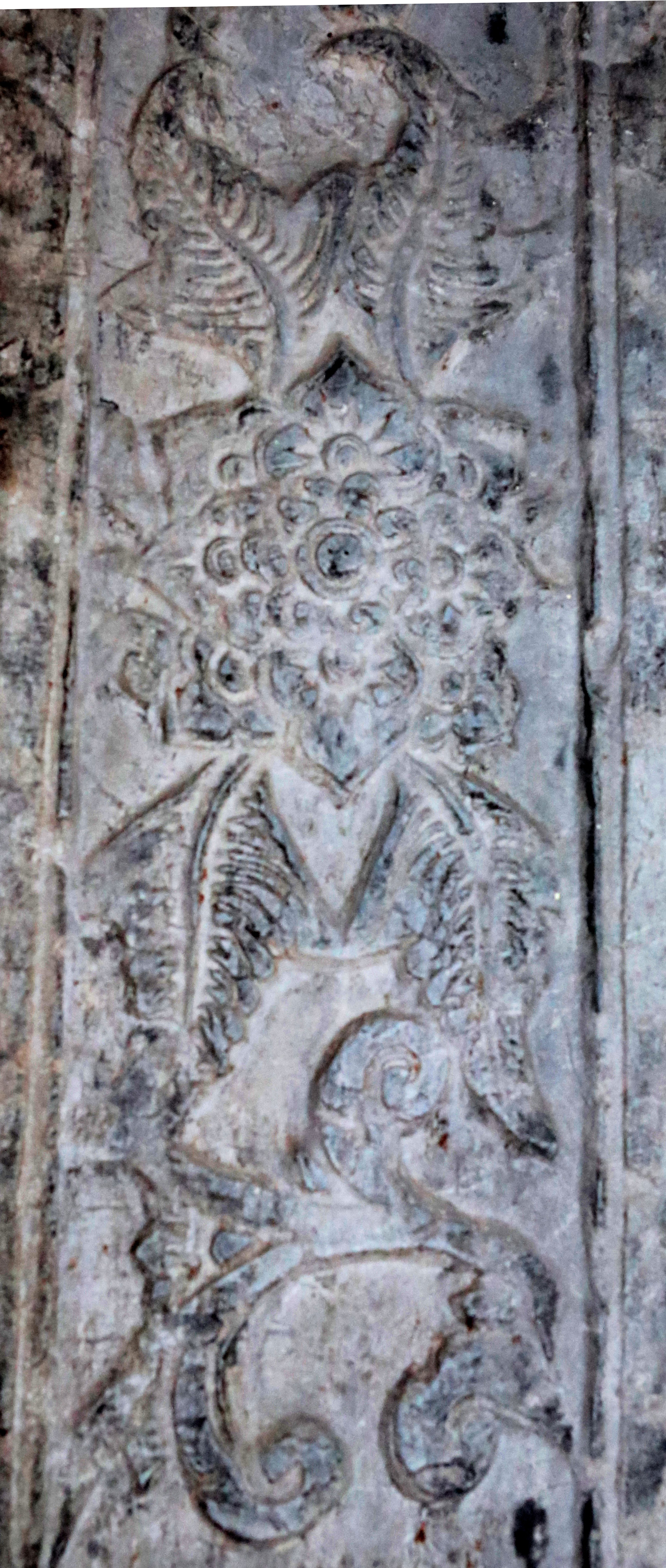
CT
DECORATIVE MOTIF OF BUFFALO ON STONE STELE AT VĂN MIẾU-QUỐC TỬ GIÁM
The stone steles not only clearly reflect the Confucian examinations, and the honoring of talents, but also show us the traditional artistic values in Vietnamese culture. The Buffalo decorated on a stele that records the information of the exam held in 1643 is a typical example.
Buffalo is the second animal in the 12 animal designations, and plays an important role in Vietnam's agriculture. Perhaps, only in the long-standing agricultural civilization are there customs and festivals such as buffalo fighting, buffalo competitions, ... Because buffalo in Vietnamese culture symbolizes firmness, loyalty, hard work and honesty. For a long time, buffalos have become part of Vietnamese belief in social life, which is both familiar and sacred. Buffalo became the source of inspiration in poems, paintings, sculptures, songs ... of Vietnam.
It is interesting that the buffalo is decorated on the stone stele that records the information of the exam held in 1643. This is the only stele of 82 steles at Van Mieu-Quoc Tu Giam to have buffalo motif. That decorative motif depicts two mandarins standing next to a buffalo. Although the motif is not very big, it clearly shows the spirit of the subjects. The two mandarins look very unhurried. The buffalo looks strong, muscular and has curved horns like a crescent moon.
The motif reminds us of the old verse “Con trâu là đầu cơ nghiệp, which means that a buffalo is very important to the beginning of a business”. It is also reminiscent of Shen Nong ceremony and and Tịch Điền ritual that took place in the past. This ritual would take place in early spring, when the king personally participated in the plowing. In the past, the royal Court took this ritual very seriously with the hope of a year with all good things and bumber crops.
The Buffalo on the stone stele also symbolizes the desire for human well-being, peace and happiness. It is also the duty of the intellectuals to build a prosperous country.
In this year, 2021, although the pandemic of Covid-19 is still worrying. Hopefully, everything will be fine in the year of Buffalo.
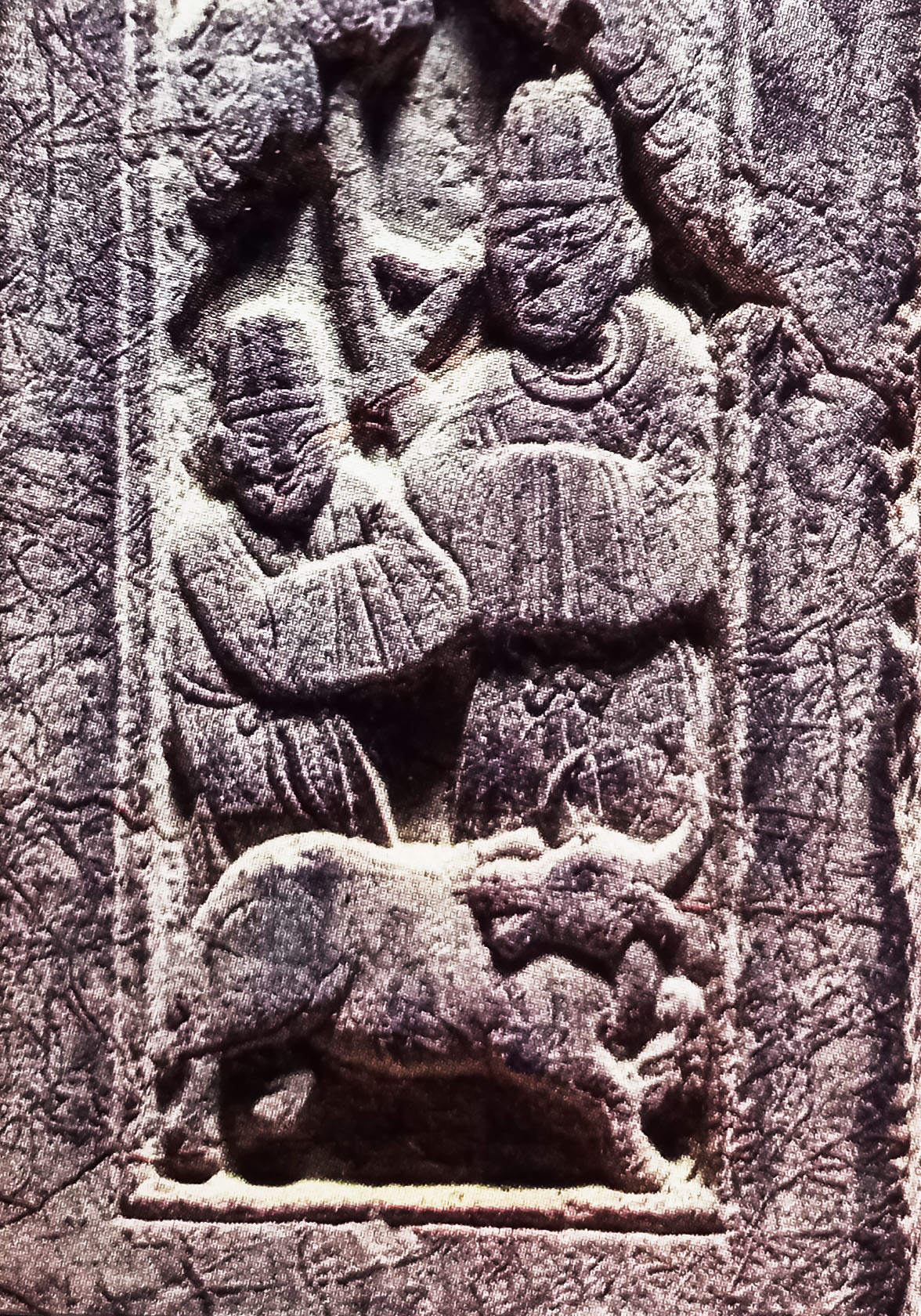
The buffalo motif on the stone stele recording the information of the exam held in 1643
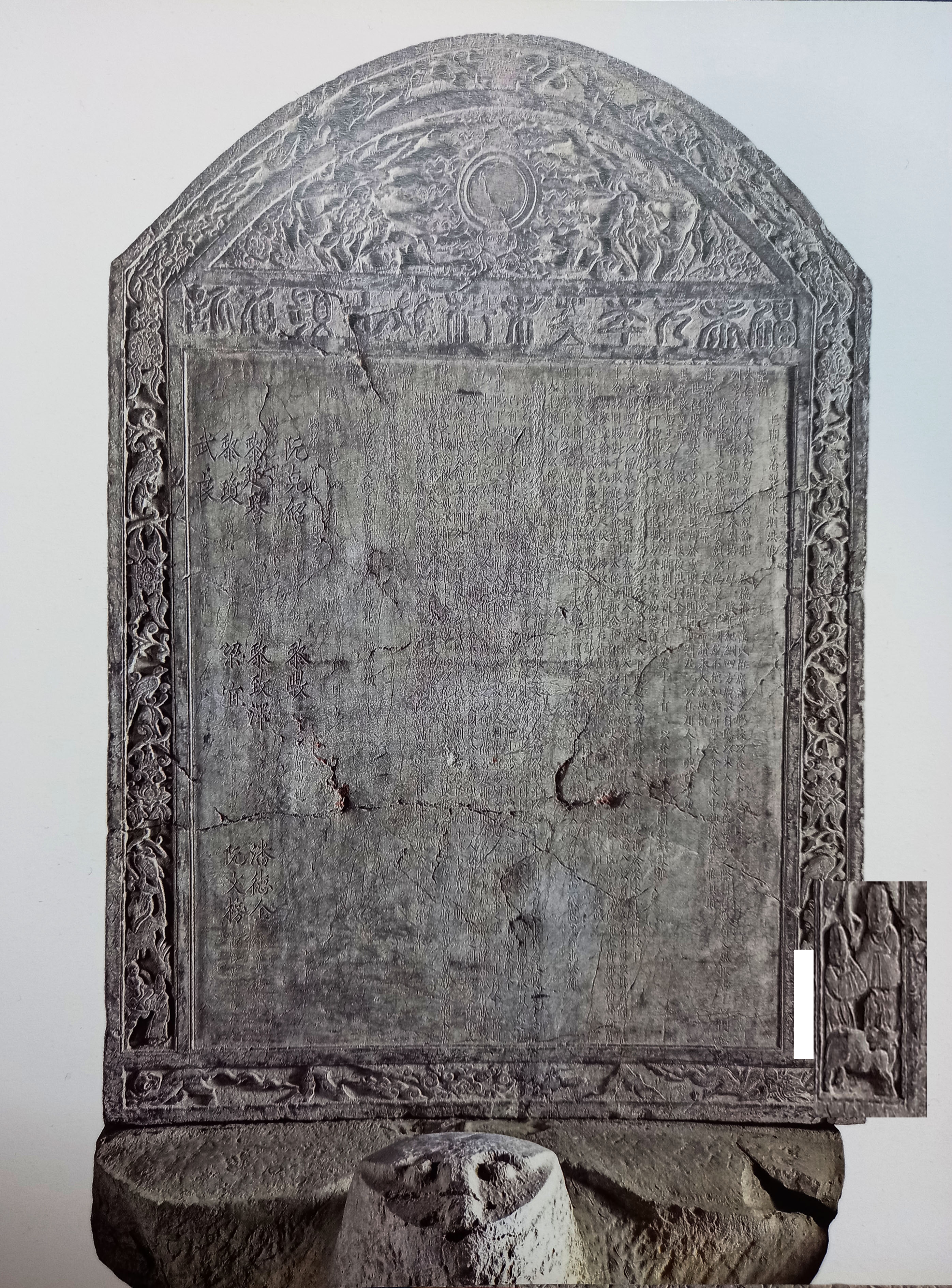
The stone stele recording the information of the exam held in 1643
CT
Dragons decorated on stone steles at Văn Miếu-Quốc Tử Giám
The dragons decorated on the stone steles at Van Mieu - Quoc Tu Giam are unique decorative patterns. Dragons on the top position of stone steles are in the shape of two dragons flanking a moon and sun. The moon and sun represent wisdom. The image of two dragons flanking the sun and moon indicates the flourishing development of intellectuals.
Out of 82 steles, there are 46 steles decorated with dragon motifs which are of different and elaborate designs. The first stelae were built in 1484; however, the dragon motifs did not appear at this time but in 1565.
The dragon motifs are divided into 2 types: " Awake dragon " and "Cloud-shaped dragons". "Awake Dragon" twists its body, its scales are clearly carved, head is held high, hair flies in the wind. It looks powerful. The moon and the sun have rays of light around them. In particular, the dragons of this type have only 3 claws. There are 14 steles decorated with the Awake- dragon motifs.
However, out of the 14 above-mentioned steles, there is only stele of the exam in 1607 which was decorated with a dragon of another style. It was "Two dragons facing a pearl". More specifically, the two dragons represent the balance between Yin and Yang while the pearl represents the universe. The motif on this stele is very clear but stiff.
The image of "Cloud-shaped dragons" was decorared for the first time on the stone stele which record names of PhD in the exam in 1656. From that year on, there were 32 other steles decorated with this motif. If we look at it at first glance, it is easy to confuse dragons with clouds. However, when we look closely, we will recognize dragons. Dragons of this type do look lissom.
The dragons were vividly carved by artisans, and come in many different shapes and styles. Although dragon is an imaginary animal , its appearance is clearly created. Moreover, it lives in a world of its own.
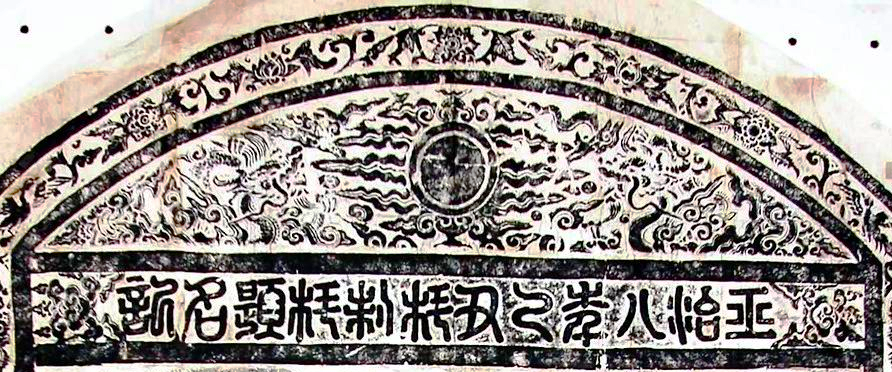
"Two dragons flanking the sun and the moon" decorated on the stele that records the examination in 1565
"Two dragons flanking a pearl" decorated on the stele that records the exam in 1607
"Cloud-shaped dragons" decorated on the stele that records the exam in 1763
CT
BIA TIẾN SĨ TẠI VĂN MIẾU - QUỐC TỬ GIÁM HÀ NỘI VỚI TRUYỀN THỐNG HIẾU HỌC DÒNG HỌ NGUYỄN HẠ YÊN QUYẾT
82 bia đá đề danh Tiến sĩ của các khoa thi từ 1442 đến 1779 tại Văn Miếu - Quốc Tử Giám là những di vật quý giá và được xem như pho sử bằng đá về giáo dục Nho học Việt Nam, trải qua hơn 5 thế kỷ tồn tại cùng với những thăng trầm của lịch sử, cho đến nay vẫn giữ nguyên giá trị.
Nội dung bia Tiến sĩ tại Văn Miếu - Quốc Tử Giám còn ghi đầy đủ những thông tin cụ thể về khoa thi, số lượng thí sinh, tên, quê quán người thi đỗ, tên các quan coi thi, chấm thi,... Những thông tin này cung cấp cho chúng ta cái nhìn tổng quan về sự phát triển giáo dục thời Lê - Mạc. Qua thông tin trên các bia Tiến sĩ chúng ta thấy sự xuất hiện của nhiều làng khoa bảng, dòng họ khoa bảng. Trong số đó có dòng họ Nguyễn ở Hạ Yên Quyết, huyện Từ Liêm, nay thuộc phường Yên Hòa, Cầu Giấy, Hà Nội.
Làng Hạ Yên Quyết (làng Cót) là một làng trong 4 làng nổi tiếng (Mỗ, La, Canh, Cót). Dòng họ Nguyễn là một trong những họ nổi tiếng ở Hạ Yên Quyết, đây là một dòng họ có truyền thống hiếu học từ lâu đời. Đến nay họ Nguyễn đã phát triển được hơn 20 đời trong gần 600 năm với rất nhiều danh nhân học cao, trí lớn, có đức, có tài, đã đem toàn bộ tài năng và trí tuệ của mình cống hiến cho đất nước, phục vụ nhân dân. Họ đều là những người đức độ, chính trực, thanh liêm, lập lên nhiều công lao lớn và được sử sách ghi lại. Dòng họ Nguyễn có tất cả 5 vị đỗ đại khoa, 30 vị đỗ Cử nhân, Tú tài.
Cụ thủy tổ của dòng họ là Nguyễn Như Uyên, ông đỗ Đệ nhị giáp Tiến sĩ xuất thân (Hoàng giáp) khoa Kỷ Sửu niên hiệu Quang Thuận 10 (1469) đời vua Lê Thánh Tông. Làm quan đến chức Lại bộ Thượng thư, chưởng lục bộ, kiêm Tế tửu Quốc Tử Giám, Nhập thị kinh diên.
Đời thứ hai là Nguyễn Xuân Nham, cháu họ của Nguyễn Như Uyên, ông đỗ Đệ tam giáp Đồng tiến sĩ xuất thân khoa Kỷ Mùi niên hiệu Cảnh Thống 2 (1499) đời vua Lê Hiến Tông. Làm quan đến chức Thừa chính sứ.
Nguyễn Như Uyên và Nguyễn Xuân Nham đỗ các khoa thi năm 1469 và năm 1499. Hai khoa thi này theo Đại Việt sử ký toàn thư chép đều được dựng bia đặt tại Văn Miếu - Quốc Tử Giám song đã bị thất lạc, những bia này hoặc đã bị huỷ hoại, hoặc chuyển dịch thất lạc, bị vùi lấp đâu đó chưa phát hiện được.
Đến đời thứ ba là Nguyễn Khiêm Quang, cháu của Nguyễn Như Uyên, ông đỗ Đệ tam giáp Đồng tiến sĩ xuất thân khoa Quý Mùi niên hiệu Thống Nguyên 2 (1523) đời Lê Cung Hoàng. Khoa Quang Thiệu 5 (1520) và 2 khoa đời Lê Cung Hoàng (Thống Nguyên 2 (1523) và Thống Nguyên 5 (1526), tức 3 khoa thi cuối cùng của đời Lê sơ thì không những đương thời mà cả về sau cũng chưa bao giờ được dựng bia. Vì thế mặc dù đỗ Tiến sĩ song tên ông không được khắc trên bia đặt tại Văn Miếu.
Đời thứ 5 là Nguyễn Nhật Tráng, cháu của Nguyễn Khiêm Quang, ông đỗ Hội nguyên, Đệ nhị giáp Tiến sĩ xuất thân (Hoàng giáp) khoa Ất Mùi niên hiệu Quang Hưng 18 (1595) đời Lê Thế Tông. Bia Tiến sĩ năm 1595 đặt tại Văn Miếu – Quốc Tử Giám khắc tên ông: “Đệ nhị giáp Tiến sĩ xuất thân: Nguyễn Nhật Tráng: xã Yên Quyết Hạ, huyện Từ Liêm”.
Đời thứ 8 là Nguyễn Vinh Thịnh, cháu tằng tôn của Nguyễn Nhật Tráng, ông đỗ Đệ tam giáp Đồng tiến sĩ xuất thân khoa Kỷ Hợi niên hiệu Vĩnh Thọ 2 (1659) đời vua Lê Thần Tông. Tên của ông được khắc trên văn Tiến sĩ khoa thi năm 1659 đặt tại Văn Miếu - Quốc Tử Giám: “Đệ tam giáp Đồng tiến sĩ xuất thân: Nguyễn Vinh Thịnh: xã Nghĩa Đô huyện Từ Liêm”.
82 bia Tiến sĩ là nguồn sử liệu hết sức quý giá, chúng ta có thể tìm được rất nhiều thông tin về lịch sử, văn hóa, mỹ thuật, các giá trị triết lý, giá trị tư tưởng và quan điểm của người đương thời. Những tấm bia đá hiện vẫn còn ở Văn Miếu - Quốc Tử Giám luôn nhắc nhở chúng ta về chính sách đối với nhân tài, đề cao, ca ngợi công trạng của các danh nhân với dân, với nước. Trong số 1304 vị Tiến sĩ được lưu danh trên bia Tiến sĩ nói chung và những vị Tiến sĩ của dòng họ Nguyễn ở Hạ Yên Quyết nói riêng, rất nhiều người đã trở thành những nhà hoạt động chính trị, xã hội, văn hóa, giáo dục..., trở thành những vị quan công minh đem tài trí của mình giúp dân, giúp nước.
Bài và ảnh: Bạch Ngọc Minh
VỀ TẤM BIA KHOA THI NĂM MẬU TUẤT NIÊN HIỆU QUANG HƯNG THỨ 21 (1598) TẠI VĂN MIẾU - QUỐC TỬ GIÁM HÀ NỘI
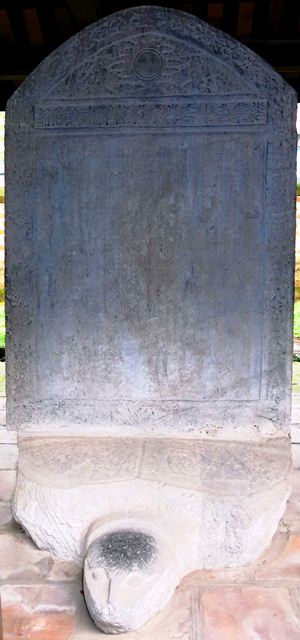
Di tích Quốc gia đặc biệt Văn Miếu - Quốc Tử Giám là nơi lưu giữ 82 tấm bia Tiến sĩ, những “Bảo vật quốc gia”, “Di sản Tư liệu Thế giới trên phạm vi toàn cầu” vô cùng ý nghĩa. Hệ thống bia Tiến sĩ đã trở thành những di sản vô giá của nền văn hóa dân. Trên bia có khắc họ tên và quê quán của 1304 vị Tiến sĩ thi đỗ dưới thời Lê - Mạc. Tấm bia Tiến sĩ khoa thi Mậu Tuất niên hiệu Quang Hưng thứ 21 (1598) có ghi họ tên quê quán của Tế tửu Quốc Tử Giám Nguyễn Duy Thì, một danh nhân có nhiều đóng góp cho đất nước.
Bia khoa thi Mậu Tuất (1598) có chiều cao 167cm, chiều rộng phần sát đế bia 118cm, độ dày của bia 23cm. Đế bia cao 35cm, rộng 114cm, dài 162cm. Trên bia có 46 dòng khắc 1207 chữ Hán... Đế bia được tạo hình rùa chạm khắc sơ sài rùa cổ rụt, đầu bằng ngang, hai mắt lồi và sống mũi được tạc rõ, đầu nhỏ. Mai rùa hơi cong, trên mai có khắc hình lục giác, có một gờ nhỏ ở giữa chạy suốt sống lưng, gáy khớp dày hẳn lên.
Tiêu đề của tấm bia khoa thi năm Mậu Tuất (1598) viết theo thể chữ triện, thường dùng trong ấn tín của triều đình và nghệ thuật thư pháp, có giá trị nghệ thuật cao được viết và khắc bởi nhóm: Trung thư giám Nguyễn Quang Đắc và Triện thích thái thừa Quế Lan nam Nguyễn Quang Độ.
Hoa văn trang trí xung quanh diềm bia là hoa sen, hoa cúc, hoa trà, hoa mẫu đơn chạm trổ cầu kỳ, có điểm thêm lá và hoa rất hài hòa. Chân diềm bia chạm hình cánh sen đều liên tiếp thành hàng dài, trên cánh có trang trí thêm các đường chỉ mảnh theo hình cánh hoa làm tăng thêm tính thẩm mỹ. Chỉnh thể của hoa văn ở diềm, chân diềm và chữ triện ở trên bia tạo thành một tác phẩm nghệ thuật độc đáo mang tính thẩm mỹ cao giúp các nhà nghiên cứu có thêm tư liệu tìm hiểu sâu hơn về điêu khắc đá và mỹ thuật Việt Nam ở thế kỷ XVII.
Bài ký của tấm bia Tiến sĩ khoa thi năm Mậu Tuất (1598) đã chỉ rõ đây là khoa thi thứ 2 dưới thời Lê Trung hưng. Bia cũng ghi lại đầy đủ thành phần của ban giám khảo là các vị đại thần đầu triều như: Đề điệu là Thái úy Ngạn quận công Trịnh Đỗ, Tri cống cử là Ngự sử đài Đô Ngự sử Lê Trạc Tú, Giám thí là Lễ bộ Tả Thị lang Ngô Tháo, Đại lý tự khanh Trần Phúc Hựu là quan độc quyển. Hoàng thượng đích thân định thứ tự cao thấp. Nho sinh Nguyễn Duy Thì đã phải đem hết tài học sở trường của mình chứng minh trước ban giám khảo, những người lỗi lạc, uyên thâm cả về kiến thức và kinh nghiệm. Ông đã vượt qua rất nhiều thí sinh để là 1 trong 5 người có tên trên bảng vàng, bia đá của kỳ thi Đình năm Mậu Tuất (1598).
Những người cùng được khắc tên trên bia với Nguyễn Duy Thì gồm: Nguyễn Thứ: người xã Bột Thái, huyện Hoằng Hóa; Lê Bật Tứ: người xã Cổ Định, huyện Nông Cống; Nguyễn Khắc Khoan: người xã An Khang, huyện Yên Phong; Nguyễn Giới (Kiệm): người xã Văn Lâm, huyện Nga Sơn.
Trong 5 vị Tiến sĩ khoa thi năm Mậu Tuất (1598) duy nhất Nguyễn Duy Thì sau này trở thành Tế tửu Quốc Tử Giám đúng như quan điểm của nhà nước đã nêu ở bài ký khoa thi này “chọn người tốt mà làm thầy” sau nhiều năm giữ chức Tư nghiệp đến năm Dương Hòa 6 (1640), ông giữ chức Tế tửu Quốc Tử Giám phụ trách việc đào tạo giáo dục nhân tài cho đất nước.
Bia khoa thi năm Mậu Tuất (1598) dựng vào ngày 16 tháng 11 năm Thịnh Đức thứ nhất (1653) sau khi Nguyễn Duy Thì thi đỗ 55 năm và qua đời được 2 năm. Hàn lâm viện Hiệu thảo Trịnh Cao Đệ là người soạn bài ký. Người nhuận lại bài ký là Lễ Bộ Thượng thư kiêm Hàn lâm viện Thị giảng Dương Trí Trạch. Họ là những người nổi tiếng văn hay chữ tốt, có uy tín và kinh nghiệm được triều đình giao cho trọng trách soạn văn ký, nhuận sắc bài ký trên bia Tiến sĩ để lưu danh muôn thủa.
Bia Tiến sĩ khoa thi năm Mậu Tuất (1598) là tấm bia ẩn chứa nhiều giá trị lịch sử, văn hóa, giáo dục. Tế tửu Quốc Tử Giám Nguyễn Duy Thì khắc tên trên bia lưu danh muôn thuở, hậu thế nhìn vào ngưỡng vọng, công trạng của ông luôn được người đời sau ghi nhớ. Một người hết lòng vì dân vì nước như ông được các thế hệ người Việt Nam tri ân và tưởng nhớ.
Tấm bia khoa thi Mậu Tuất (1598) là một di sản tư liệu quý, tác phẩm nghệ thuật độc đáo của nền văn hóa dân tộc hiện còn được lưu giữ tại Khu di tích quốc gia đặc biệt Văn Miếu – Quốc Tử Giám Hà Nội./.
Sưu tầm
DOCTORAL LAUREATE’S STELE - THE VALUABLE RESOURCES ABOUT HISTORY OF VIETNAMESE EDUCATION
Today, when visiting the Special National Landmark Van Mieu - Quoc Tu Giam, visitors get a better view of the 82 doctoral’s stele which preserve the names and native places of 1,304 graduates of 82 royal exams (81 exams held by Le dynasty and one exam held by Mac dynasty) held from 1442 to 1779. These 82 stone steles were inscribed on the Asia-Pacific Memory of the World Register in 2010 and the International Memory of the World Register in 2011.
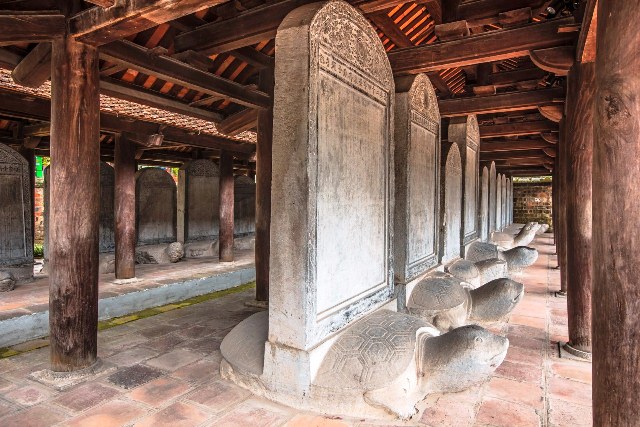
The history of Vietnamese education, Confucian teaching and learning in our country dates back to the Ly dynasty, and was further developed through the Tran and Ho dynasties. Under the Le dynasty, Confucian teaching resulted in training thousands of talented men for the country. The text for the stele of the first examination held in the 3rd year of the reign of Dai Bao (1442) was composed by the academician Than Nhan Trung (Title: Han lam vien Thua chi, Dong cac Dai hoc si) affirms: “Virtuous and talented men are the essence of the State’s vitality”. It was always considered the guideline for education of many dynasties.
The stele not only show the way of using talents, the content on the stele also teaches lessons and reminds the talented men the responsibility to the country: The text for the stele of the first examination held in 1487 states: “Whose names appear on this stone are very lucky! They should try their best to make their fame match their abilities”; The text for the stele of the first examination held in 1514 states: “They should become ‘auspicious clouds, stars, shining gems and pure gold’ for the nation”; The text for the stele of the first examination held in 1577 states: “If any of the laureates uses the honors he has gained to seek wealth and credit from the mandarinate, posterity will surely criticize him as an evil, mean man who brings disgrace on our education system”.
The text on the stele records the names and homelands of the laureates, the names and the titles of the text composer, editor, calligrapher and the time of the stele erection, the names of examination executives, examiners, and dates of Royal examination, the date of hanging the board written names who passed Royal exams… Based on that information, we can assess the situation of educational development under the Le and Mac dynasties.
The number of candidates attending the examination steadily rose over a period of one thousand years showing an interest in the education of the State and the society. In 1442, 450 men participated in the examination process; in 1448, there were 750 participants; in 1475 there were 3000 participants, and in 1640 there were 6000 men taking the exam.
However, the examination process was rigorous. Even though there was a steady increase in the number of men taking the exam, there was not an increase in the number of men who passed the exam. The candidates' quality requirements were disregarded. The text on the stele states: The number of men who passed the exam in one examination was 62 people (exam in 1478), and at least there were only 3 men passed (exam in 1592, 1667).
Of the 1304 graduates who were listed on the Doctorate laureate’s stalea, many later became social and political activists, famous culturalists who left behind many valuable works for future generations. Thus, 82 stone steles at Van Mieu - Quoc Tu Giam vividly reflect the educational history of our country from the 15th to the 18th centuries.
Translator: Thu Hương
THE STONE STELAE – A WORLD DOCUMENTARY HERITAGE
On January 14, 2011, 82 stone stelae were regconized as a national treasure. In May 2011, the 82 stone stelae at Van Mieu – Quoc Tu Giam were ranked as a world documentary heritage. Le Thanh Tong King (1460 – 1497) thought highly of Confucianism and ordered stone stelae to be erected to memorialize the nation’s talents.
Nowadays, 82 stone stelae from 15th to 18th centuriesrecord the names of 1304 doctoral laureates. These 82 stone stelae are original and havve beenpreserved.
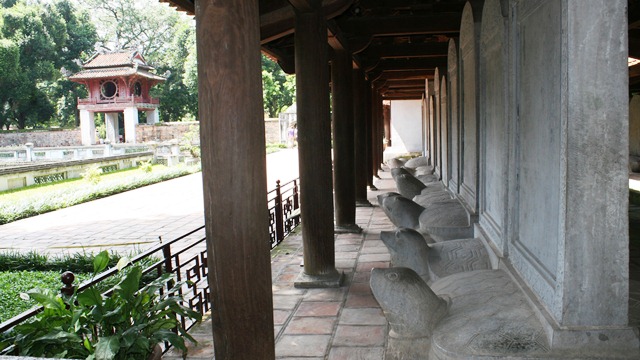
Original and unique
The 82 stone stelae are original artifacts found only at Van Mieu – Quoc Tu Giam in Hanoi. They provide an opportunity to researchthe connected relationship between geography and the history of culture in Vietnam.
The 82 stone stelae are a precious textual source of history that helps us research the life and careers of Vietnamese talents and provideso a complete list of graduates in Han – Nom bibliographies of Vietnam.
More specifically, each inscription provides information on the history of the examination and the political and social context of the Viet kingdom during that period by singing the praises of talented men and the virtues of the ruling monarch and outlines the purposes and requirements of the education system. The inscription for the examination held in 1442 says: “Virtuous and talented men are the primordial vitality of a State. If this vitality is strong, the State will be powerful and prosperous. If it is not, the State will weaken and have a low standing. Therefore, clear – sighted monarchs always attach importance to educating talented men and selecting Confucian scholars for the mandarinate, and regard the fostering of the State’s primordial vitality as an urgent task”.
Diversity of value of source text
Content of inscriptions on 82 stone stelae have been researched and identified many subjects: history, culture, education, philosophy, law, comtemplary written language...
The inscription on each stelae, speaks highly of the role of Confucianism in social-political life and the king. In the past, the kings always cared and respected the talents who are considered the most important factors to consolidate the country, and rule the nation.
History of education in Vietnam is evident on the 82 stone steale. The steale illustrate the rule of education, the names of exams (Hoi, Dinh exams) and the tittles of doctoral laureates with their ranks: the first rank (Trang nguyen, Bang nhan, Tham hoa); the second rank (Hoang giap); the third rank (Tien si).
The 82 stone stelae were engraved in Han character, important characters that provides research of the history of development of Han character from 15th to 18th centuries.The earliest stone stelae are inscribed with seal character, reflecting traditional creation of calligraphy in Vietnam.

Diversity of form and style
The 82 stone stelae were erected in different dynasties, which is evident by three different shapes of tortoise. Each stelae has its own artistic character, represented by the design of the tortoise or pediment and edges, which reflects the artistic symbolism of the times and thus sheds light on the development of Vietnamese art history during the 15th and 18th centuries. Every steale is a real work of art, having been created by the best scholars, craftmen and calligraphers of the era.
Stone stelae at Van Mieu – Quoc Tu Giam record events of politics, culture and science. The development of education policy was important to develop a strong nation.
Translator: Bich Phuong
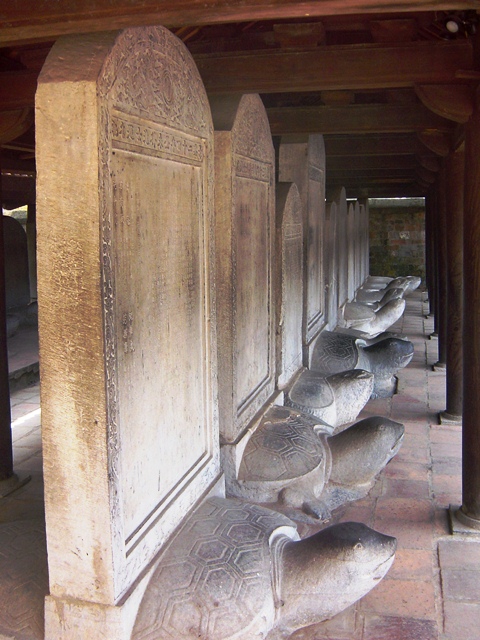
GIÁ TRỊ BIA TIẾN SĨ
82 bia Tiến sĩ là những di vật giá trị bậc nhất của di tích Văn Miếu- Quốc Tử Giám, niềm tự hào của nền văn hóa giáo dục dân tộc đã tạo nên và lưu giữ được một pho “sử đá” có giá trị về nhiều mặt.
1. Giá trị lịch sử
Nội dung những bài văn bia do phải tuân theo khuôn khổ, nội dung nhất định nên không tránh khỏi nhiều đoạn trùng lặp. Nhưng qua pho “sử đá” đồ sộ đó có thể thấy được quan điểm về giáo dục thời phong kiến được nói đến nhiều lần trong mục đích dựng bia đồng thời cho biết sự “náo nhiệt” của không khí học hành thi cử, họ tên của các bậc danh nho và các địa phương, các dòng họ có truyền thống khoa bảng.
Bia Tiến sĩ cho biết số người dự thi. Khoa 1442 có 450 người, khoa 1448 có 750 người, khoa 1463 có 1400 người, khoa 1466 có 1100 người, 1475 có 3000 người, khoa 1481 có 2000 người, khoa 1514 có 5700 người, khoa 1640 có 6000 người dự thi… Qua đó có thể thấy được số người đi học đậu thi Hương để vào thi Hội, thi Đình đông đến mức nào và cũng chứng tỏ việc học hành giáo dục của thời Lê phát triển rất cao.
Nhưng chẳng ai đi thi đều đỗ và đỗ cao cả. Với số lượng thí sinh đông như vậy mà có khoa thi chỉ lấy đỗ có 3 người (khoa Đinh Mùi niên hiệu Cảnh Trị 2 - 1667) và nhiều nhất là 62 người (khoa Mậu Tuất niên hiệu Hồng Đức 9 – 1478).
Các vị tân khoa sau khi thi đỗ được ban hưởng mọi ân huệ của nhà vua, nào mũ áo cân đai triều phục, nào ngựa quý cờ quạt nghi trượng phường trống vinh quy bái tổ, bổ dụng quan chức trong triều ngoài phủ…ngần ấy thứ vẫn chưa đủ, lại còn khắc đá đề tên đặt nơi cửa hiền tài khiến cho kẻ sĩ phu trông vào mà sinh lòng hâm mộ phấn chấn, tự biết rèn luyện lấy danh tiết. Người được khắc tên lên bia đá đầu tiên là Trạng nguyên Nguyễn Trực người xã Bối Khê, huyện Thanh Oai (nay thuộc thôn Bối Khê, xã Tam Hưng, huyện Thanh Oai, tỉnh Hà Tây) đỗ Trạng nguyên khoa Nhâm Tuất niên hiệu Đại Bảo 3 (1442) đời Lê Thái Tông, làm quan chức Thủ trung thư lệnh, Tri tam quán sự, đại liên ban đặc thụ, Hàn lâm viện Thừa chỉ kiêm Tế tửu Quốc Tử Giám, từng đi sứ nhà Minh. Ông là văn thần được Lê Thánh Tông rất kính trọng, thơ văn của ông sáng tác phần nhiều đều cho đưa đến để ông nhận xét, bình luận. Tác phẩm Bối Khê thi tập hiện chỉ còn 6 bài thơ chữ Hán chép trong Toàn Việt thi lục. Người cuối cùng được ghi tên lên bia đá là Tiến sĩ Phan Huy Ôn người xã Thu Hoạch, huyện Thiên Lộc, phủ Đức Quang, trấn Nghệ An (nay thuộc tỉnh Nghệ An) khoa thi Kỷ Hợi (1779) và cũng là khoa thi cuối cùng được dựng bia tại Văn Miếu- Quốc Tử Giám, Hà Nội.
Qua văn bia còn có tìm thấy tên họ của nhiều vị đã từng được nhắc đi nhắc lại nhiều lần trong các sách sử Việt Nam đồng thời cũng là những người có công lao lớn đối với nước với dân như Nhà sử học Ngô Sĩ Liên, Tiến sĩ năm 1442, người xã Chúc Sơn, huyện Chương Đức (nay thuộc huyện Chương Mỹ, tỉnh Hà Tây) đã soạn bộ sách Đại Việt sử ký toàn thư gồm 15 bộ. Hoàn chỉnh bộ sách này là nhà bác học Lê Quý Đôn người xã Diên Hà, huyện Diên Hà, tỉnh Thái Bình, đậu Bảng nhãn khoa thi 1752. Ông viết rất nhiều tác phẩm như: Đại Việt thông sử, Kiến văn tiểu lục, Phủ biên tạp lục, Vân đài loại ngữ… bao gồm các mặt chính trị, triết học, quân sự, kinh tế, xã hội, lịch sử, thơ ca.. Ông là một nhà học thuật tài năng lỗi lạc. Ngô Thì Nhậm, người làng Tả Thanh Oai, huyện Thanh Trì, Hà Nội, đỗ Tiến sĩ khoa 1775, là nhà chính trị, ngoại giao lỗi lạc, đã giúp vua Quang Trung - Nguyễn Huệ chiến thắng quân Thanh trong trận Ngọc Hồi - Đống Đa lừng danh trong lịch sử. Ông là con của Ngô Thì Sĩ đỗ Hoàng giáp khoa thi năm 1766, cha con cùng đỗ đạt và làm quan một triều.
Truyền thống hiếu học còn thể hiện ở dòng họ khoa bảng, một xã một huyện có nhiều người đỗ đạt cùng được khắc tên, quê quán trên bia Tiến sĩ.
Nói đến truyền thống hiếu học khoa bảng phải nhắc đến Kinh Bắc. Với một vùng đất màu mỡ có sông Đuống, sông Cầu…chảy qua, bên cạnh những làn điệu quan họ, tranh vẽ Đông Hồ… là danh sách của hơn 430 vị đỗ đại khoa gồm có 15 Trạng nguyên, trong đó có Lê Văn Thịnh người làng Đông Cứu, huyện Gia Lương, tỉnh Bắc Ninh), 15 Bảng nhãn, 19 Thám hoa, 90 Hoàng giáp và 291 Tiến sĩ, 10 Phó bảng, 98 vị được ghi tên lên bia đá dựng tại khu di tích Văn Miếu- Quốc Tử Giám.
Xã Mộ Trạch, huyện Đường Hào, tỉnh Hải Dương cũng nổi tiếng khoa bảng, có 30 Tiến sĩ. Dòng họ Thân Nhân Trung ở xã Yên Ninh, huyện Yên Dũng, tỉnh Bắc Giang mấy đời liền đỗ đại khoa, đều cùng làm quan một triều. Thân Nhân Trung đỗ Tiến sĩ năm 1469, làm quan Lại bộ Thượng thư Chưởng Hàn lâm viện kiêm Đông các Đại học sĩ, con là Nhân Vũ, Tiến sĩ năm 1481, và Nhân Tín, Tiến sĩ năm 1490, cháu ông là Thân Cảnh Vân, Thám hoa năm 1487.
Dòng họ Ngô xã Vọng Nguyệt, huyện Yên Phong 5 đời liền đỗ đại khoa: Ngô Nhân Triệt đỗ Tiến sĩ năm 1608 là cháu của Ngô Ngọc (Hoàng giáp 1487) và Ngô Hải (Hoàng giáp 1508) là con của Ngô Trừng (Hoàng giáp 1508), là cha của Nhân Tuấn (Tiến sĩ 1640).
Dòng họ Nguyễn xã Vân Điềm, huyện Đông Ngàn có Nguyễn Thực đỗ Hoàng giáp 1595 làm quan Tán trị công thần Tham tụng Lại Bộ thượng thư Chưởng Hàn lâm viện sự kiêm Đông các Đại học sĩ, tước Lan quận công, là cha của Nguyễn Nghi (Tiến sĩ 1620), tằng tổ của Nguyễn Khuê, Nguyễn Sĩ (Tiến sĩ 1670), cao cao tổ của Nguyễn Thẩm (Tiến sĩ 1760) và Nguyễn Thưởng (Tiến sĩ 1754).
Những dòng họ, xã có nhiều vị đỗ đạt cao đã tạo nên truyền thống hiếu học của địa phương.
2. Giá trị mỹ thuật của bia Tiến sĩ
82 tấm bia Tiến sĩ là 82 phong cách điêu khắc, nhưng có thể chia làm 3 loại theo thời gian dựng bia và đặc trưng nghệ thuật của bia:
Loại I: Gồm các bia dựng từ năm Hồng Đức thứ 15 (1484) đến năm Đại Chính thứ 7 (1536)
Loại II: Gồm các bia dựng cùng một năm Thịnh Đức thứ nhất (1653)
Loại III: Gồm các bia dựng từ năm Vĩnh Thịnh thứ 3 (1717) đến năm Cảnh Hưng thứ 41 (1780)
Theo nhiều nhà nghiên cứu đánh giá trong số 82 bia còn lại đến nay, có 25 bia loại II là những bia có nghệ thuật trang trí tiêu biểu, là những sản phẩm văn hóa quý giá nhất trong kho tàng sản phẩm văn hóa còn lại ngày nay ở Văn Miếu Hà Nội
a) Về hình dáng bia: Loại II đều cao to hơn loại I, thường cao từ 155cm đến 170cm, rộng từ 110cm đến 125cm và dày từ 20cm đến 30cm. Hình dáng của trán bia cong vút lên gần với hình bán nguyệt chứ không thấp bé như loại trước nữa.
b) Về nghệ thuật tạo rùa: Ở bia loại I thời Hồng Đức được thể hiện bằng những khối tròn, trơn nhẵn, đường nét tinh tế. Nhưng rùa loại II lại chỉ phác họa bằng những khối vuông, góc cạnh, đường nét đơn giản, dứt khoát. Rùa ở loại II cổ rụt, đầu chếch hoặc bằng ngang, mặt bẹt, sống mũi nở cao, thẳng, mắt tròn, nhỏ, lồi và sát gần nhau, hai hốc mày và toàn bộ trán đều nổi cao gắn liền với sống mũi, tạo nên một đường gần giống với chữ T; miệng rộng cong hình cung, không có răng nanh, mai cong đều có một gờ nhỏ ở giữa chạy giữa suốt sống lưng, vai rùa không rằn xuống mà gần như vuông hẳn lại, gáy có khớp dày và chân tạc sơ sài.
c) Về nghệ thuật trang trí trên bia: Trước hết hãy xem xét việc trang trí trên các trán bia, nơi vốn được coi là chỗ trang trọng nhất của một tấm bia. Ở đây chủ yếu đều chọn đề tài hai rồng chầu mặt nguyệt. Cách bố cục mang nhiều nét đẹp của loại đề tài này là cách bố cục hình rồng uốn khúc từ trên vòng xuống, đầu quay ngẩng lên trong tư thế rất khỏe. Đầu rổng ngẩng cao, mặt nghiêm chỉnh hướng về phía các viên ngọc đang bay lơ lửng trong viền mây lửa của mặt nguyệt. Thân rồng cuộn khúc vòng ngược trở lên, đuôi lượn sóng chạy song song với diềm bia. Hình rồng ở đây có dáng mập, thân nổi lên cuồn cuộn với những hình khối tròn, chắc nịnh và đường chạm sâu. Đặc điểm của hình rồng này là : Đầu to, trán tròn, mũi cũng rất to và phồng cao, mồm rộng có răng nhọn và đặc biệt có răng nanh mọc dài ra ngoài, mắt nhỏ có viền lông mày hình mây lửa, hai râu chảy từ mắt xuống vòng dài ra phía sau, gáy có bờm ngắn và trên đó là đôi sừng nhỏ, toàn thân có vảy, được viền bằng một lớp vây sắc, càng về cuối càng to. Đây là một loại rồng mang nhiều đặc trưng của những hình rồng đầu thế kỷ 17 nói chung.
Một thể loại khác là trán bia có hình phượng chầu mặt nguyệt. Hai bên mặt nguyệt là hai hình chim phượng to lớn xòe rộng cánh trong tư thế đang bay.
Nghệ thuật chạm khắc trên các bia loại II nhìn chung đã đạt đến một trình độ tinh xảo. Về bố cục điểm chung là tính cân xứng đăng đối. Tính sinh động đa dạng của bố cục cũng là một đặc điểm nổi bật trên các trang trí của diềm bia. Nghệ nhân không chịu gò bó trong một vài hình mẫu khác biệt nhau.
QUÁ TRÌNH DỰNG BIA TIẾN SĨ
Từ năm 1442 đến năm 1787 dưới triều Lê đã tổ chức được 124 khoa thi Tiến sĩ. Nhưng hiện nay ở Văn Miếu - Quốc Tử Giám chỉ có lưu giữ 82 tấm bia được xếp thành 2 khu vực Đông, Tây bên giếng Thiên Quang, mỗi bên 41 bia dựng thành 2 hàng. Cách sắp xếp bia không theo thứ tự thời gian, triều đại, hoặc kích cỡ lớn nhỏ mà đan xen lẫn nhau. Nhà che bia lúc đầu đã có và được tu sửa nhiều lần nhưng đến cuối thế kỷ XVIII bị tàn phá hết. Đến năm 1994 mới được làm lại.
Về chủ trương, bia được dựng sau mỗi kỳ thi nhưng không mấy khi được dựng ngay mà làm tập trung vào từng đợt.
- Đợt 1: Năm 1484 dựng 10 bia cho các khoa thi từ năm 1442 đến năm 1484.
- Đợt 2: Năm 1653 dựng 25 bia cho các khoa từ năm 1554 đến năm 1652.
- Đợt 3: Năm 1717 dựng 21 bia cho các khoa từ năm 1656 đến năm 1712.
Còn 26 bia được dựng ngay sau các khoa thi.
Lễ dựng bia Tiến sĩ đầu tiên được tổ chức trọng thể ngày rằm tháng Tám, năm Giáp Thìn niên hiệu Hồng Đức 15(đời Lê Thánh Tông) được ghi trong Đại Việt sử ký toàn thư: “ Vua cho là từ năm Đại Bảo thứ 3 triều Thái Tông (năm sinh vua Lê Thánh Tông) đến giờ việc dựng bia đề tên Tiến sĩ các khoa vẫn chưa làm được, sai Lễ bộ Thượng thư Quách Đình Bảo biên rõ họ tên, thứ bậc các Tiến sĩ từ khoa Nhâm Tuất Đại Bảo thứ 3, khoa Mậu Thìn năm Thái Hòa thứ 6, khoa Quý Mùi năm Quang Thuận thứ 4, khoa Bính Tuất năm thứ 7, khoa Kỷ Sửu năm thứ 10, khoa Mậu Thìn năm Hồng Đức thứ 3, khoa Ất Mùi năm thứ 6, khoa Mậu Tuất năm thứ 9, khoa Tân Sửu năm thứ 12, khoa Giáp Thìn năm nay (1484) khắc vào đá”.
Theo sách Kiến văn tiểu lục của Lê Quý Đôn viết năm 1776 thì lúc đó có 124 khoa thi Tiến sĩ nhưng nay chỉ còn 82 bia. Như vậy 42 khoa thi có bao nhiêu khoa không được dựng bia, bao nhiêu khoa có dựng nhưng đã mất?
Theo Đại Việt sử ký toàn thư thì 9 khoa thi những năm 1469, 1472, 1484, 1490,1493, 1499, 1505, 1508 và 1634 đều được dựng bia nhưng nay không thấy có.
THE STONE STELAE AT VAN MIEU - QUOC TU GIAM
Van Mieu – Quoc Tu Giam currently has 82 preserved doctoral laureates’ stelae, which bear the names and places of birth of 1307 graduates from 82 royal examinations which were held from 1442 to 1779 under the Le and Mac dynasties.

The laureates’ stelae were firstly erected at Van Mieu – Quoc Tu Giam in 1484 under the reign of the King Le Thanh Tong (1460-1497). This event was recorded in Dai viet su ky toan thu: “In the year of Giap Thin, the 15th year of the reign of Hong Duc (1484)… Autumn, on the 15th day of the 8th lunar month, the stelae were set up with the inscriptions of the names and birth places of the laureates from the examination held from the year of Nham Tuat, the 3rd year of the reign of Bao Dai (1442), under the King Le Thai Tong during that dynasty and up to the present.…”. It was such a special event which has increased the great spiritual value of Van Mieu – Quoc Tu Giam.
82 stone slabs remain at Van Mieu – Quoc Tu Giam, which have been set up for nearly 300 years from 1484 to 1780. Each stele was erected to engrave the names and birth places of the laureates of each examination. The laureates’ stelae were erected during different periods. In 1484, the King Le Thanh Tong ordered 10 stone stelae to be set up for the examinations held from 1442 to 1484. Only 7 stelae erected during that time remain today. Later, 5 stelae were set up from 1487 to 1529 in 1487,1496, 1513, 1521, 1529 and 2 stelae were erected in 1536 under the Mac dynasty. The maximum numbers of stelae were set up in 1653, 25 stelae were erected for the examinations organized from 1554 to 1653. The third period of the erection of 25 stelae was completed in 1717 for the examinations held between 1656 and 1717. The remainders of the 22 stelae were set up from 1721 to 1780. The last stele was erected in 1780 for the recording of the examination organized in 1779.
The Doctors’ stelae at Van Mieu – Quoc Tu Giam were created by talented and famous craftsmen and laureates. All the stelae at Van Mieu – Quoc Tu Giam were created in the same style, which is of flattened stelae. Each stele consists of two parts: Stele and stele sole.
+ The stele includes two main parts:
-The stele pediment is an arch shape and has various designs. The first sentence of the text which is in big ancient Chinese characters indicates the year the examination was organized.
-The main section is a rectangle engraved with the stele text in ancient Chinese characters. The text on the stele records the names and homelands of the laureates, the names and the titles of the text composer, editor, calligrapher and the time of the stele erection.
+The stele sole are tortoises with different designs and symbolize the longevity, immortality of the talented and virtuous people, the education and laureates’ stelae.
The stelae were erected in different sizes. Those stelae which were set up in the late 15th and early 16th centuries were small in size. Later, the sizes of the stelae were larger. Having been erected for nearly 300 years, the stelae were decorated with abundant designs. The largest size (height 1.75m excluding the stele sole, width 1.3m) and the smallest size (height 1.1m, width 0.7m), and the average depth of the stele is 0.25m.
The decoration of the stelae erected from 15th to 16th centuries is simple and poor. The stele pediments were decorated with the sun and spiral clouds. The edges of the stelae were engraved with flowering vines. The art styles of the stelae from the 17th to 18th centuries are diversified; the stele pediments were decorated with dragons, phoenix and the moon; the stele edges were enriched with floral motifs (flowers and leaves), human figures, birds and animals.
The motifs on the stone stelae are diversified, and reflect the development of the styles of art throughout time. Each stone stele is a real work of art, having been created by the best scholars, craftsmen and calligraphers of the era.
The special value of the stone stelae is the inscriptions in ancient Chinese characters. Each text provides a list of the laureates of that particular examination with the different ranks: De Nhat giap (first rank laureates), De Nhi Giap (second rank laureates) and De tam giap (third rank laureates). The inscriptions also give us important information on the history of the Vietnam education and examination system and a view of the nation regarding the recruitment and utilization of talented men. The idea that “Virtuous and talented men are the essential vitality of a State” is mentioned clearly in the texts on the stelae with the following significance:
- Drawing strategic policies for governors both in the past and the present that they should esteem talented people in the management of the State and the building up of the country.
- Specifying and orienting responsibility of the intellectuals for the nation. E.g. they must use their talent to serve the country and train talented men for the country
The texts on the stelae are the quintessence of knowledge of the intellectuals of different generations and the experiences of the principles for educating themselves and those of the State governance of Vietnam. In addition, the inscriptions also provide us with valuable lessons on the principles of State governance and that talented people must be given due attention and training whilst building and developing the country. The text for the stele of the first examination held in the 3rd year of the reign of Dai Bao (1442) was composed by the academician Than Nhan Trung (Title: Han lam vien Thua chi, Dong cac Dai hoc si) and affirms: “Virtuous and talented men are the essence of the State’s vitality” or “the most important and urgent question for the governance of any sovereign is how to make use of talented people” (Inscriptions for the examination in 1448). Throughout time, the policy of the State governance based on talented people is always right and affirmed. The text written for the examination held in the 3rd year of the reign of Hong Thuan (1511) by Minister of Rites, Director of the Quoc Tu Giam Le Tung (Title: le bo thuong thu Dong cac Dai hoc si kiem Quoc Tu Giam Te tuu) says: “Any Emperor who wants to govern all corners of the world in peace must seek the support of talented men”, “with regard to the philosophy of State governance, nothing is more important than talented men”. At the end of the reign of Le Trung hung, the role of talented people was still mentioned: “talented people are ho and tran trees for the nation” (Inscriptions of the examination in 1763).
The significant role of talented people for the nation is repeatedly affirmed and mentioned in almost all texts on the stelae that indicates a national policy and a key feature of State governance and is a valuable lesson for the current and following generations to follow.
To get talented people the governor should foster and train them. The way of recruitment and attraction of talented men has been reflected in the inscriptions of the stelae, which will make the country prosperous.
First of all, to recruit talented people, the State should give good opportunities for the activities of teaching and studying. It means the country must build schools, select the best teachers and try to encourage the students: “the King ordered the construction of schools in the prefects across the country and of the Quoc Tu Giam (University for the Sons of the Nation or National University) based in the capital city, recruit the best teachers and print teaching and learning materials” (Inscriptions for the examination in 1442)
However, to get real talented and virtuous people, good examinations must be organized by the government; the successful candidates of the examinations must be utilized and glorified: “the King has made the introduction of examinations to select Confucian mandarins the primary task of his governance” (Inscriptions for the examination in 1442). These procedures of organizing the examinations to recruit talented men are repeatedly mentioned in the inscriptions of the stelae, so this task is obviously considered as “a must thing to do” for the governor. There are 60 out of 82 texts covering this matter: “Top and lower ranks of talented men were selected through examinations” or “the recruitment of Confucian scholars should be through examinations” (Inscriptions for the examination in 1703), “training men of talent in schools and selecting Confucian scholars through examination” (Inscriptions for the examination in 1772).
The procedures to honor and glorify Confucian mandarins to spend all their time in study to become talented people were much diversified and those were the lessons and suggestions of the previous generation given to the one following in the State governance and the use of men of talent and virtue. Those people who were successful in their study and examinations were exempt from hard and unskilled work and the drudgery of labor; their names were inscribed on the Golden board hung in full glory at the Royal palace or at the gate of the Thai Hoc house; they were appointed to different government positions; ceremonial costumes and headwear were bestowed on the new laureates; their names were recorded in the book Dang Khoa Luc (Records of Royal Examinations) for mandarins and the literati to see and to read carefully so that they can admire the good actions presented and have the opportunity to inspire themselves. All of this will make the significance of this inscribed text more radiant, and will have close relations with the fundamentals of governance and the promotion of a civilized mode of life” (Inscriptions for the examination in 1481).
The inscriptions on the stelae provide us with lessons on how to educate ourselves and to become useful people for the homeland and the country. It is common sense that when people have achieved their goals and are glorified, they sometimes neglect their education; when they receive higher positions they could become as proud as a cock or look down upon others. In fact, some people lose their will to strive or become depraved and even lose their human dignity and it could be too late for them to be aware of what has happened to them. The inscriptions on the stelae serve as an advice, even a warning on time for contemporary Confucian scholars and for the subsequent generations. Firstly, though they succeed and are glorified they must have the dignity to be able to repay the Emperor; their actions must be in accordance with the credits and titles given to them by the Court. If they want to do those things civil mandarins must whole-heartedly care for the people and the country and know how to propose good policies to the Court…. “They must try their best to perfect their morality such as integrity, industriousness, they should be solid and pure, like “gold and gems”, must have a sense of teamwork and while serving His Majesty they should constantly be right minded” (Inscriptions for the examination in 1706).
The advice on the way to live and how to educate themselves are very sincere and detailed because they gather not only the excellent knowledge and experiences of the text composer but also the emotion for the next generations of the country: “Working at the Court, they should help the Emperor perfect his moral virtue and bring benefits to the people. When assigned to govern a region, they should become towers of strength. When holding high posts, they should display their powers of reasoning, so as to fulfill their duties as advisors to the Monarch.” (Inscription for the examination in 1691), “Old age only makes them stauncher. They should set examples for their descendants and inculcate in them fine virtues such as faithfulness, trustworthiness, honesty and self-respect. They should not use their good fortune for their personal benefit” (Inscription for the examination in 1670).
The lessons and life experiences of our ancestors and those of the knowledgeable, courageous, moral and talented generations recorded on the stone stelae, have been experienced and proved throughout time. Those lessons are extremely precious for us for all time, especially nowadays when the country has been in a period of renovation in all aspects and education has experienced many reforms and experiments. The most important task is to train and foster real virtuous and gifted people, who not only care for their generation but also think of the future generations of the country.
The erection of the stone stelae has exerted a great influence on the course of the training and education of talented people for the country. The doctoral laureates’ stelae at Van Mieu – Quoc Tu Giam have a great impact on contemporary people and those of coming generations. The name having been recorded on the stele is an encouragement for study and effort to become useful people for the country and for society. The laureates’ stelae are also a symbol and pride, success and knowledge.
Nowadays, the laureates’ stelae draw the interest of scholars, visitors and dignitaries at home and abroad. Many very important leaders from different countries visit the vestige and they highly value the benefit and significance of the laureates’ stelae.
82 stone stelae were classified as a Documentary Heritage of the World and was inscribed in the list of Memory of the World Regional Register for Asia and Pacific by UNESCO in March 2010 and a Documentary Heritage of the World and inscribed in the list of Memory of the World International Register by the General Director of UNESCO in May 2011. The 82 stone stelae at Van Mieu – Quoc tu Giam were ranked as State treasures by the Prime Minster of the Socialist republic of Vietnam on 14th January 2015. This is in recognition of the outstanding value of the laureates’ stelae at Van Mieu – Quoc Tu Giam and that of the national culture and education in particular and of the people in general.
